Allison Collection Photos
February, 1943
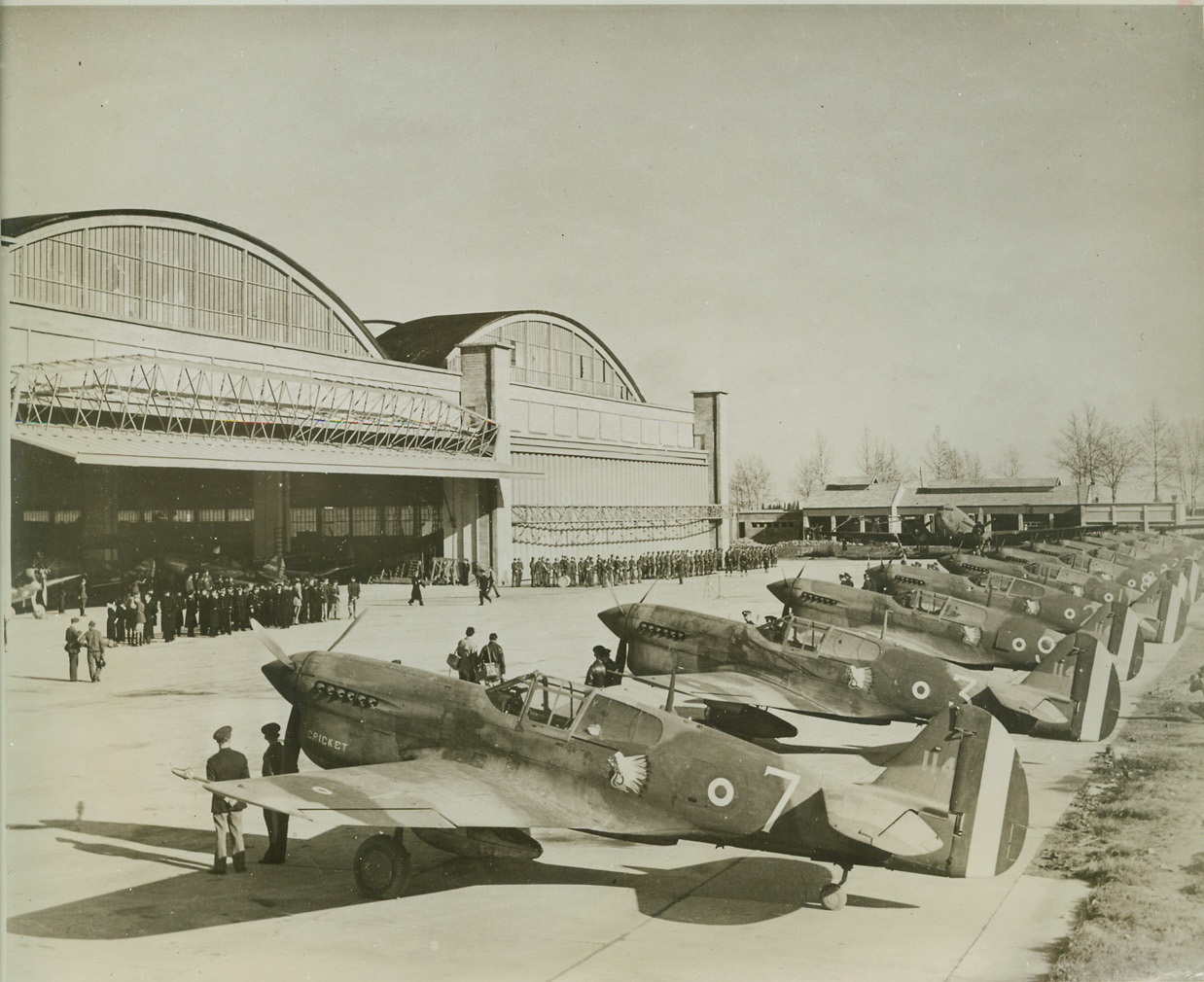
American Donate Planes to Free French, 2/4/1943. Somewhere in North Africa – Thirteen P-40’s stand ready to be flown by Free French pilots, at an airport “somewhere in North Africa.” The speedy Warhawks were presented to the Free French Air Force on behalf of the people of the United States. Credit (U.S. Army Official Photo – ACME);
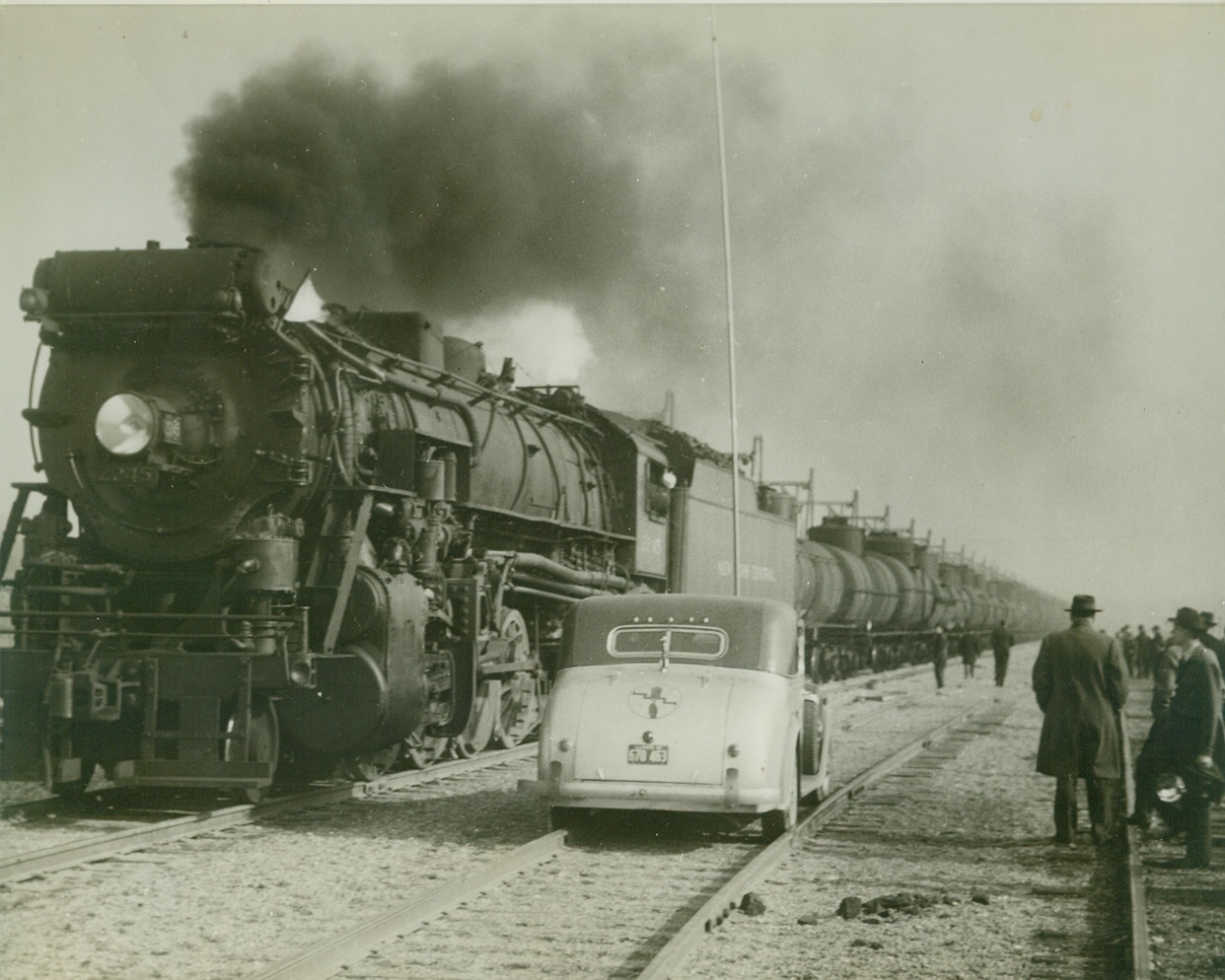
FIRST LOAD OF OIL LEAVES FOR EAST, 2/20/1943. NORRIS CITY, ILL.: Ninety-six tank cars loaded with oil at the local terminal of new Texas-Illinois Pipeline, are shown made up into the first train to leave the terminal for the petroleum starved East Coast. Formal ceremonies were held at the opening of the service. The 24-inch pipe line will be extended from here to New York and Philadelphia in the near future, but the pipe-rail system will relieve present shortage in the East until the entire line is completed. Credit: OWI Radiophoto from ACME;
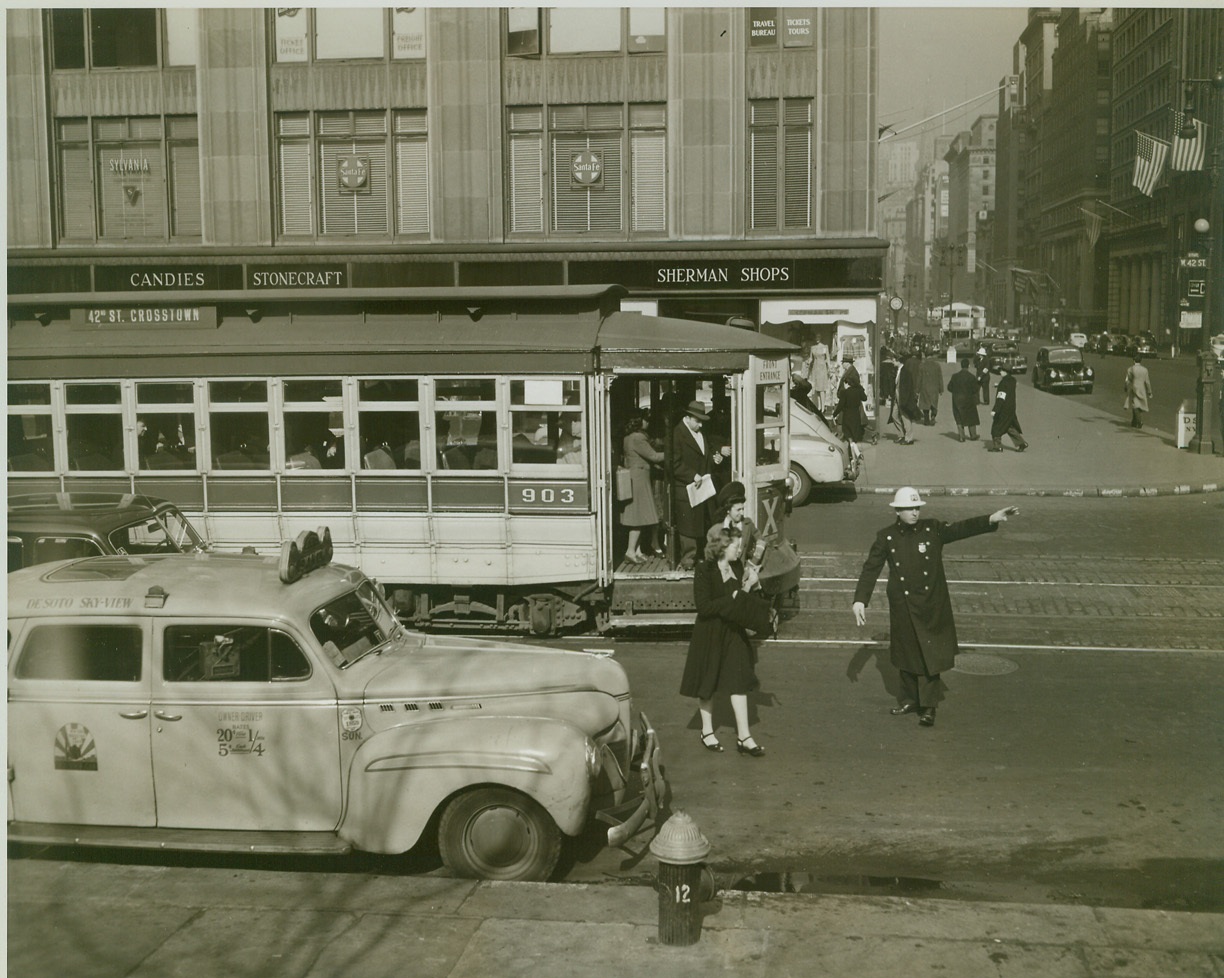
SEEK SHELTER!, 2/20/1943. NEW YORK CITY – Stopping a trolley car at 42nd Street and Fifth Ave., a policeman orders passengers to leave the car and seek shelter in nearby buildings as the “red” signal sounds. Photo was made during the third successive air raid alert under the new signal system in New York City today (February 20). Credit: OWI Radiophoto from ACME;
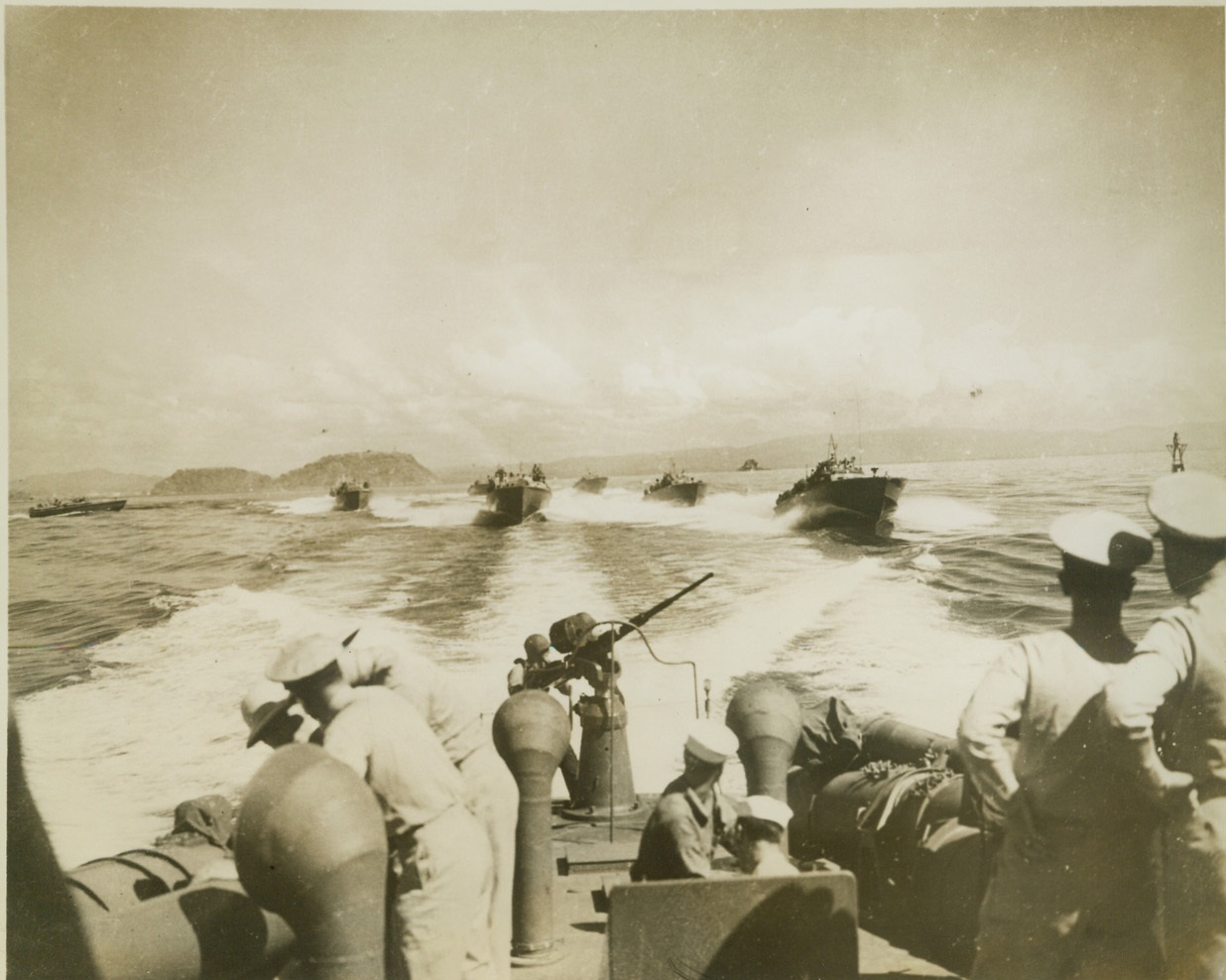
U-BOATS BEWARE, 2/3/1943. OFF PANAMA – Speedy torpedo boats attached to the 15th Naval District knife thru the waters protecting the vital Panama Canal during recent maneuvers. These high-powered units of Uncle Sam’s Navy have proved their value in combating the U-Boat menace. Credit: OWI Radiophoto from ACME;
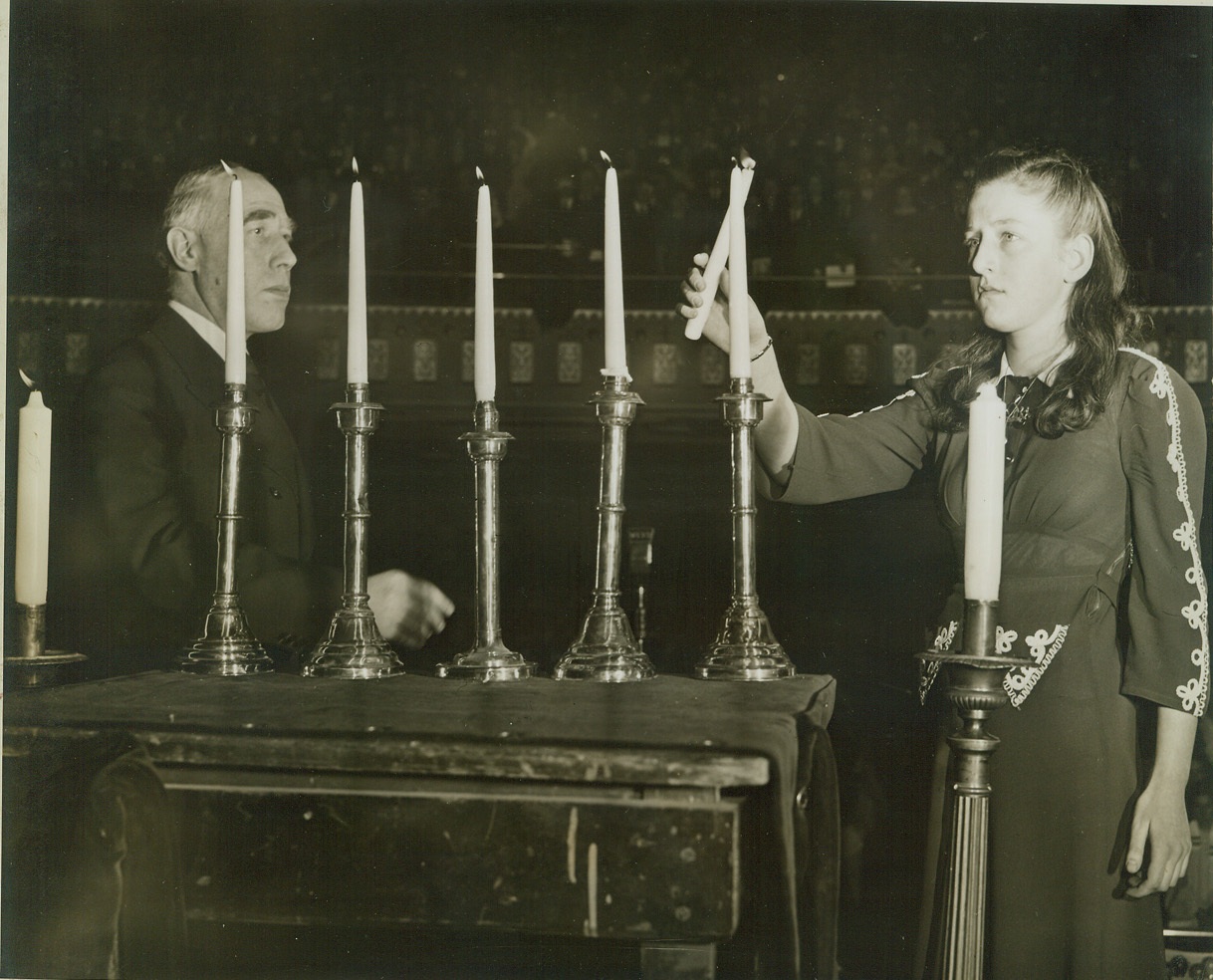
FOR HITLER’S YOUNGEST VICTIMS, 2/22/1943. NEW YORK CITY – Janine Putter, refugee child from France, lights one of the memorial candles at a Solemn Assembly of Prayer and Protest held at the Mecca Temple today by three thousand Jewish children from 518 religious schools in greater New York. The assembly was held for the children in Nazi-occupied countries. Credit: ACME;
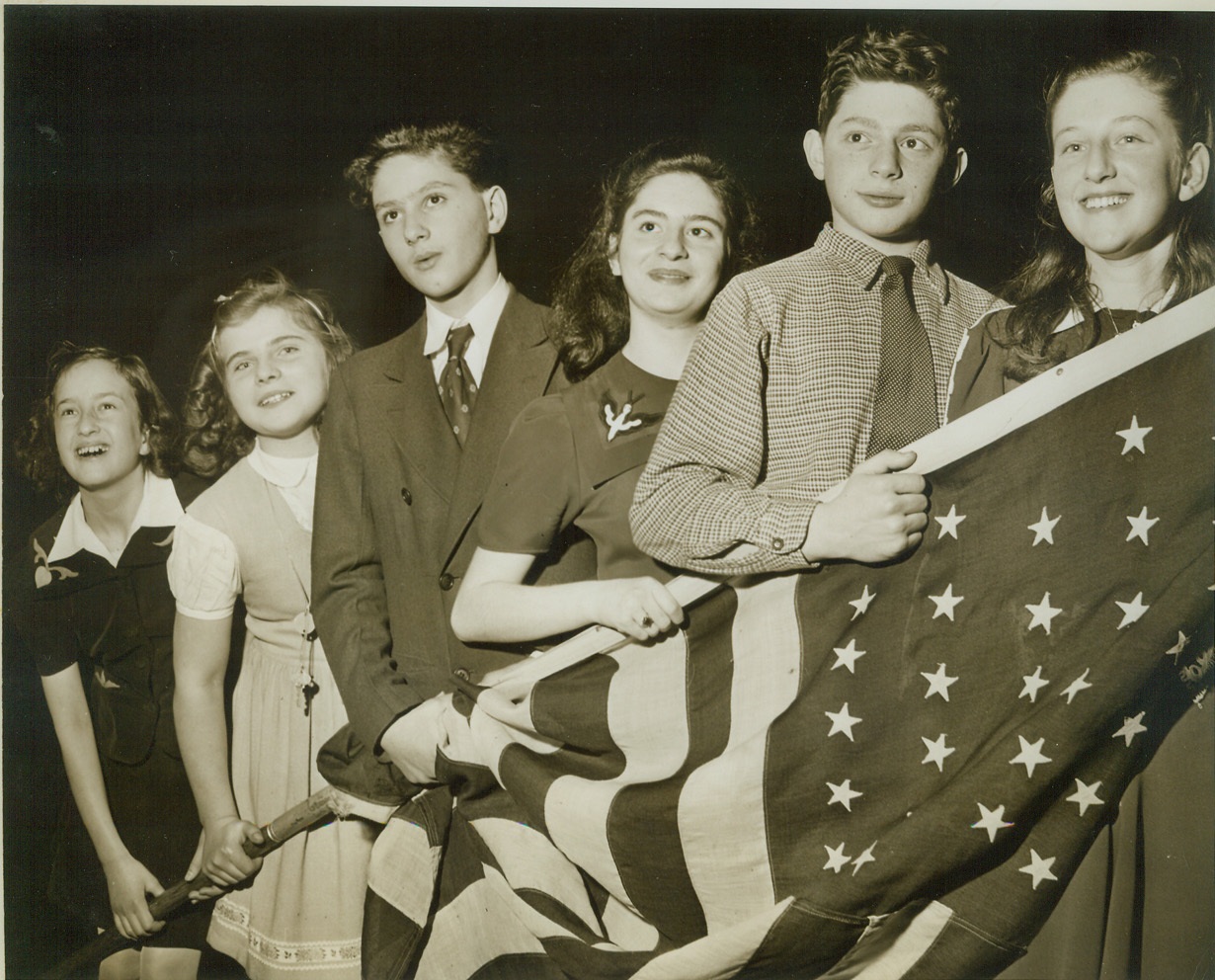
YOUNG JEWISH REFUGEE CHILDREN, 2/22/1943. NEW YORK CITY – A group of refugee children recently arrived in this country from Europe stand behind the American Flag at a Solemn Assembly of Prayer and Protest held today at the Mecca Temple by three thousand Jewish children from 518 religious schools in greater New York for the children in Nazi-occupied countries. Left to Right: Ingeborg Jacob, Germany; Ruth Friedberg, Poland; Abraham Brumberg, Poland; Helen Springer Germany; Manfred Kochen, Luxembourg; and Janine Putter, France. Credit: ACME;
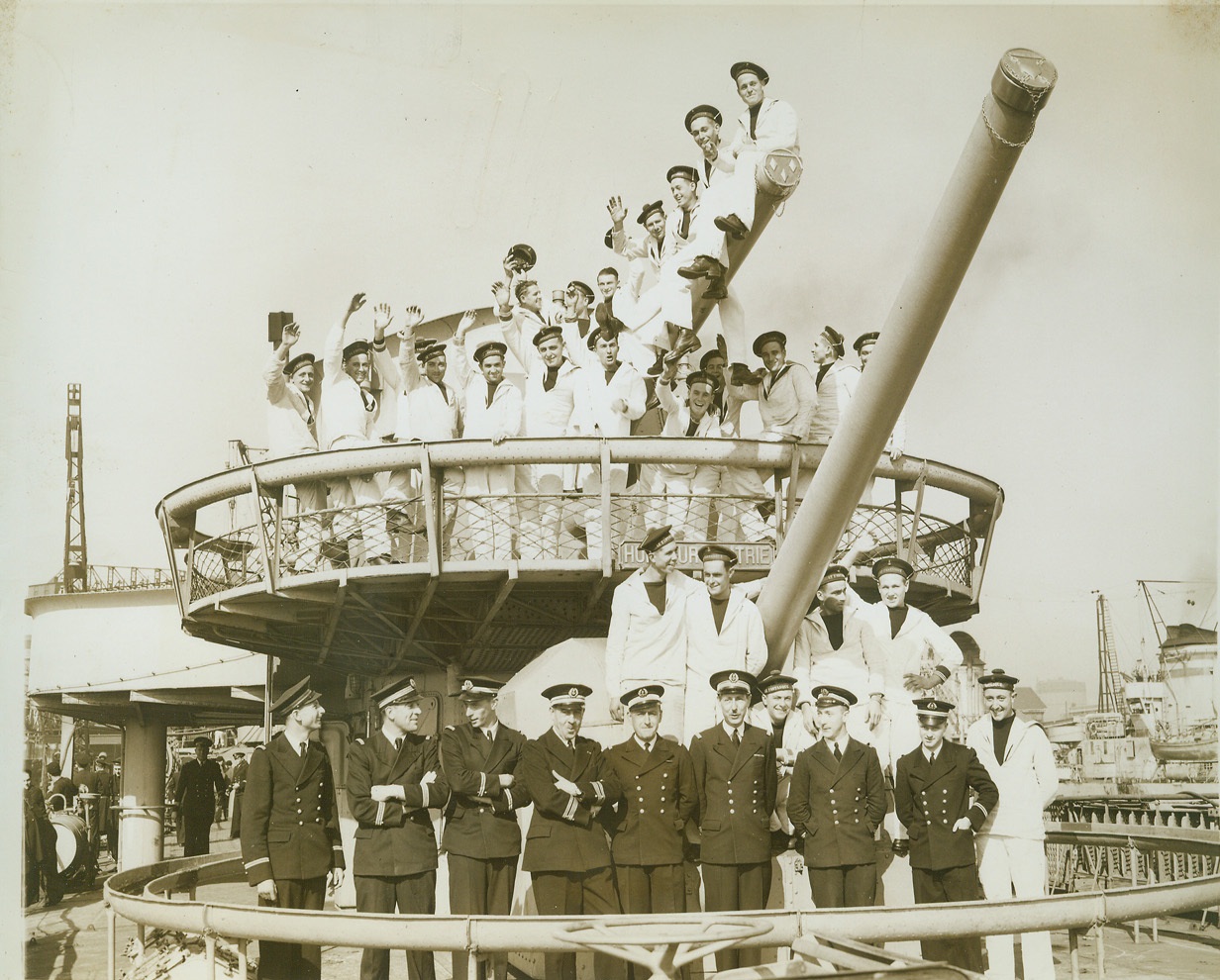
FRENCH DESTROYERS IN BOSTON FOR REPAIRS, 2/22/1943. BOSTON, MASS. – Sailors of the French destroyer “Le Fantasque” cheer on their arrival in Boston, where their ship together with French destroyer “Le Terrible” will be put in trim fighting condition before joining the Allied fleet. Credit: ACME;
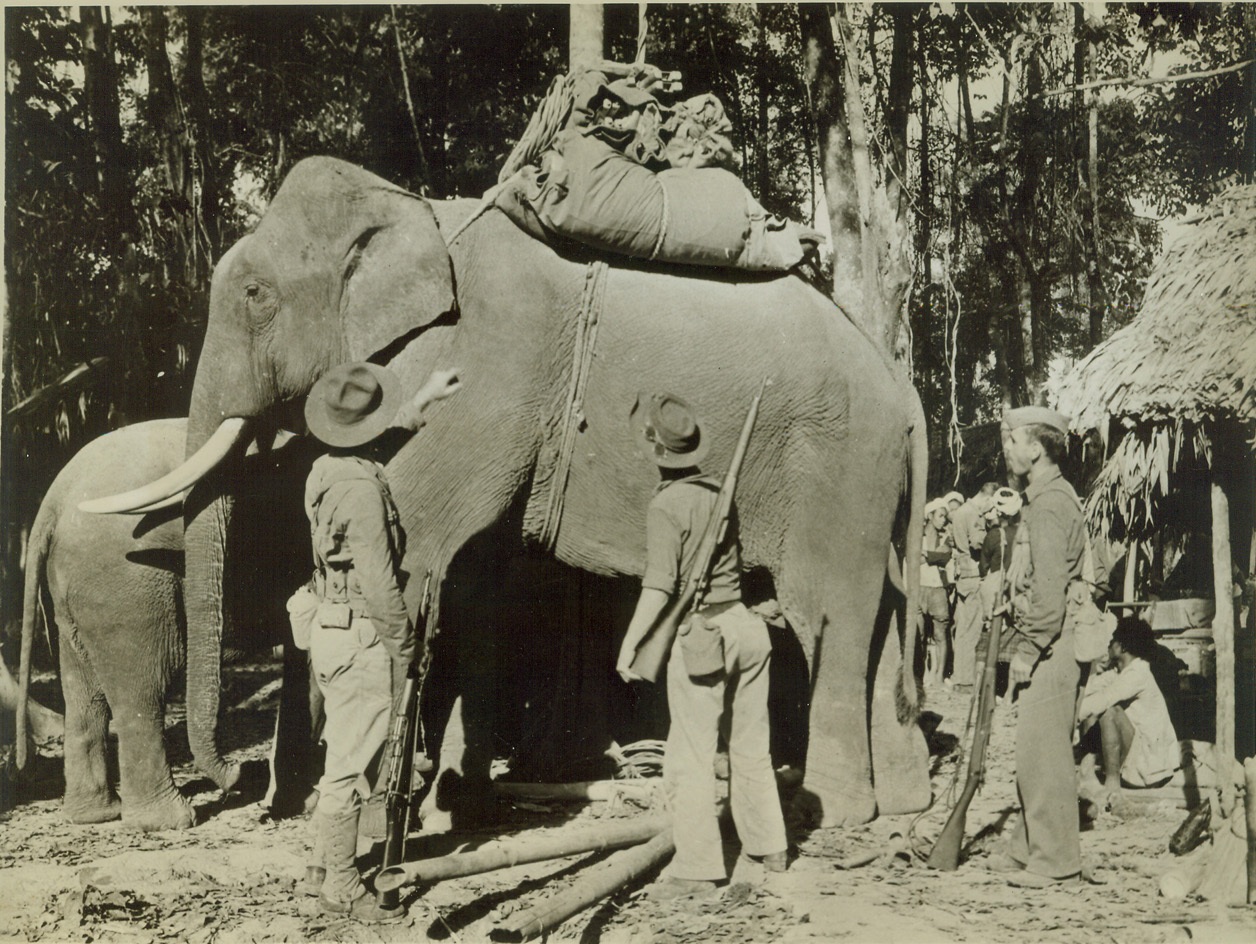
HE DOESN’T FORGET, BUT –, 2/19/1943. SOMEWHERE IN INDIA – Three U.S. soldiers hail the appearance of the elephant who carries their bedding. (Left to right) Corp. Darrall McAfee, Sedan, Kansas; Pvt. Jimmie M. Bartlett, Silver City, New Mexico; and Pvt. Raymond H. Hohn, San Francisco, hunt for their blankets before making camp after a day’s hike in India. The elephant, who leaves after the soldiers start on the march, never forgets the bedding, but being partly wild, often takes roundabout shortcuts to turn in at a later hour. As a result, Nagas are now toting bedding instead of the irresponsible Jumbo. Credit: Official U.S. Army photo – ACME;
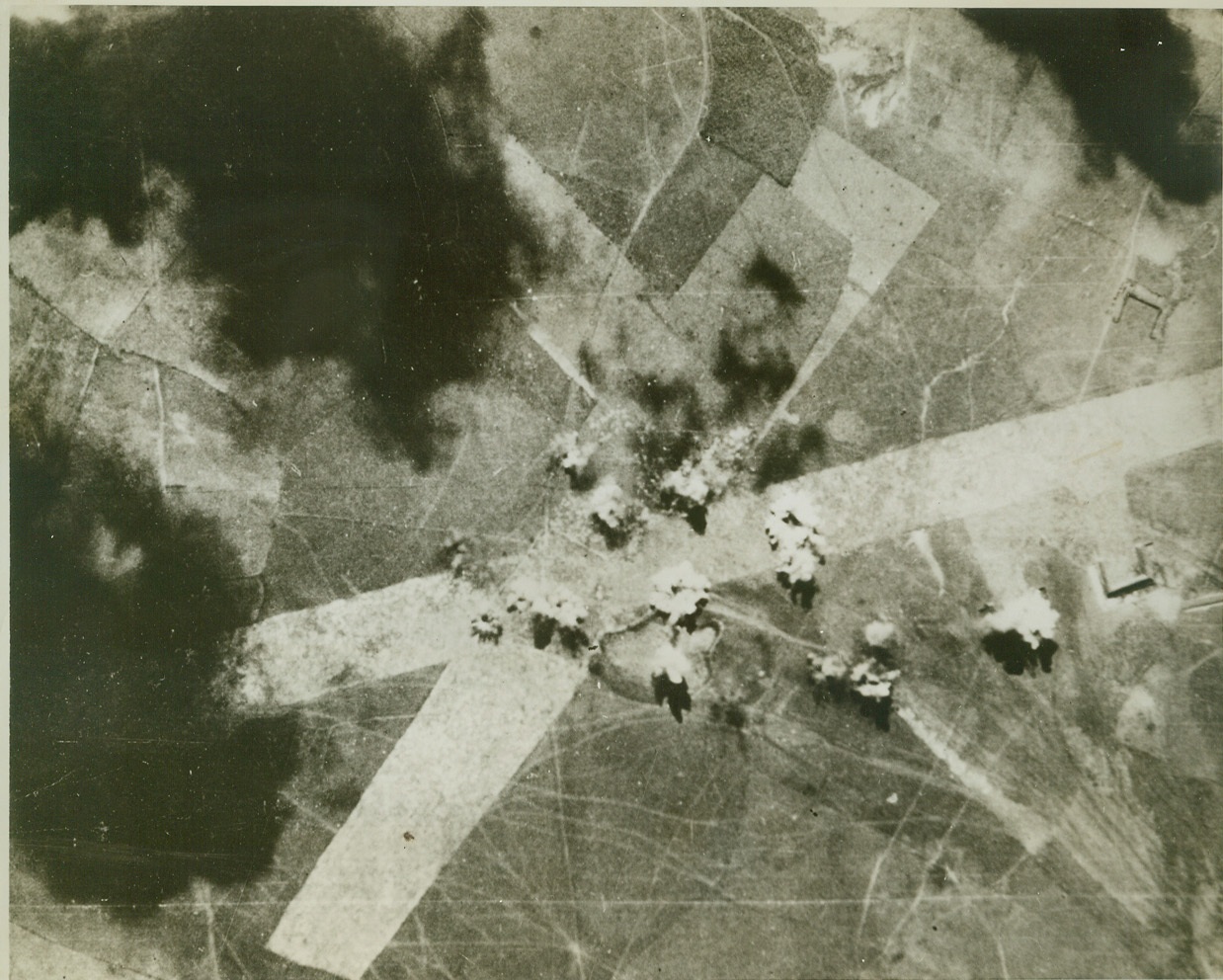
R.A.F. BLASTS JAP LANDING FIELD, 2/19/1943. BURMA- Eighteen R.A.F. bombs burst across runways on a Jap occupied airfield at Pokokku, Burma. The British bombers are hammering the Nipponese and their military installations regularly in this battle area. Most of the bursts are on runway intersections; two are on aircraft shelters. The black patches are cloud shadows. Credit: ACME;
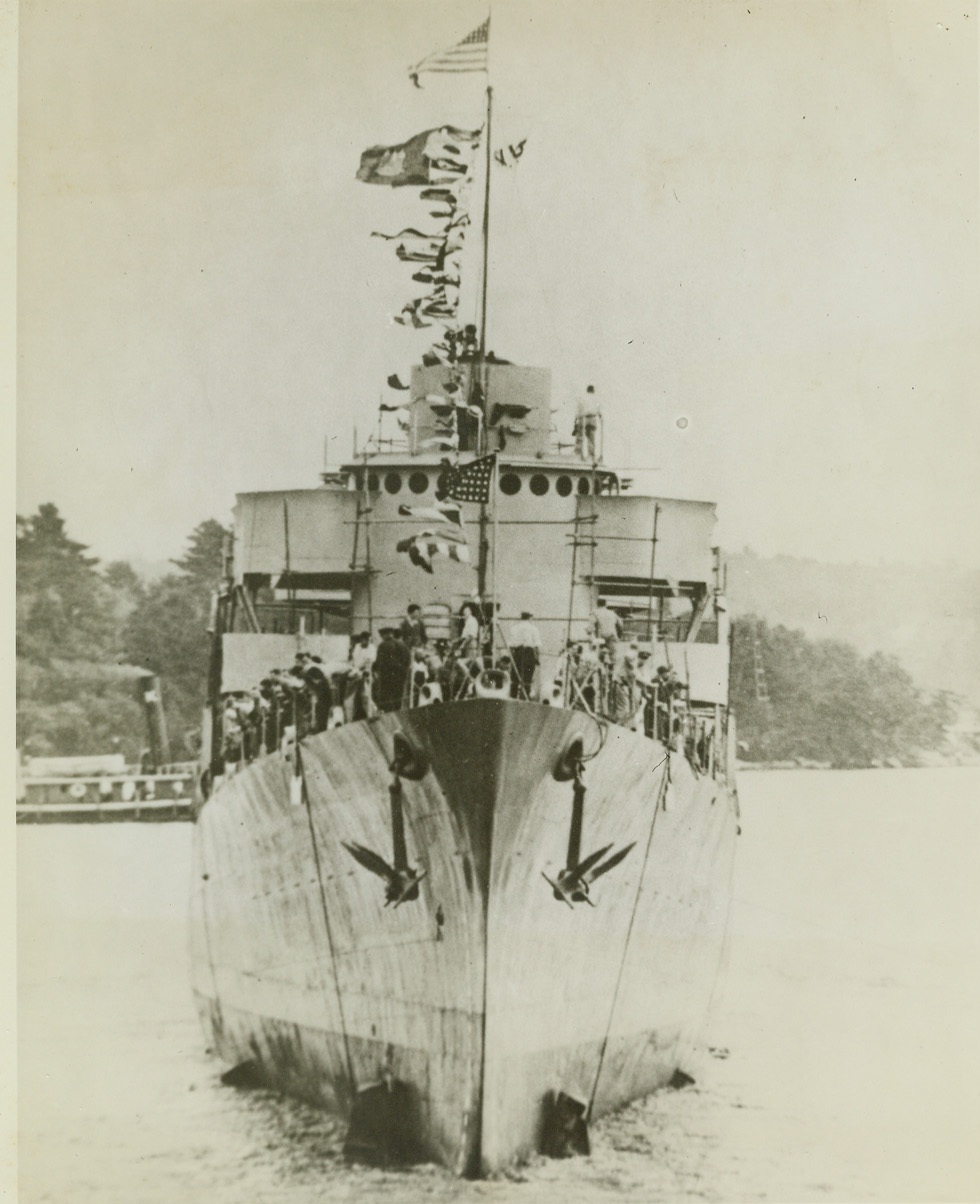
SUNK BY JAPS, 2/21/1943. Photo shows the United States Destroyer, De Haven, which was sunk February 1 during a Japanese air attack off Savo Island in the South Pacific. Credit: U.S. Navy photo via OWI Radiophoto from ACME;
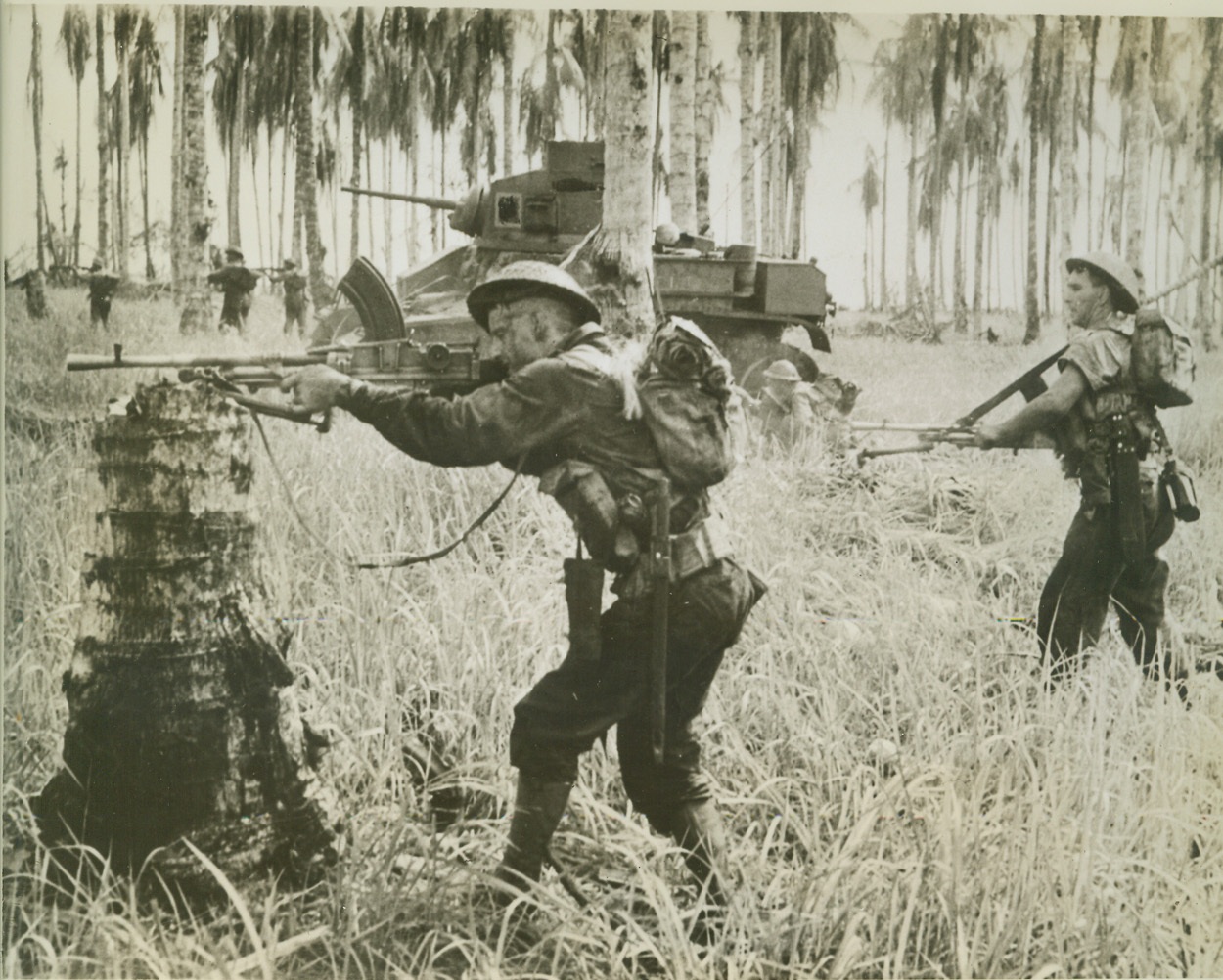
Aussies Stump Japs at Buna, 2/8/1943. New Guinea – A line of Australian troops beside a tank are firing on 25 Japs fleeing from a wrecked pillbox 150 yards away. One of the soldiers rests his gun on a tree stump to get a steadier aim. This is one of the first pictures showing the final assault on Buna. The troops exterminated Jap pillbox positions before rolling into Buna. Credit: (ACME);
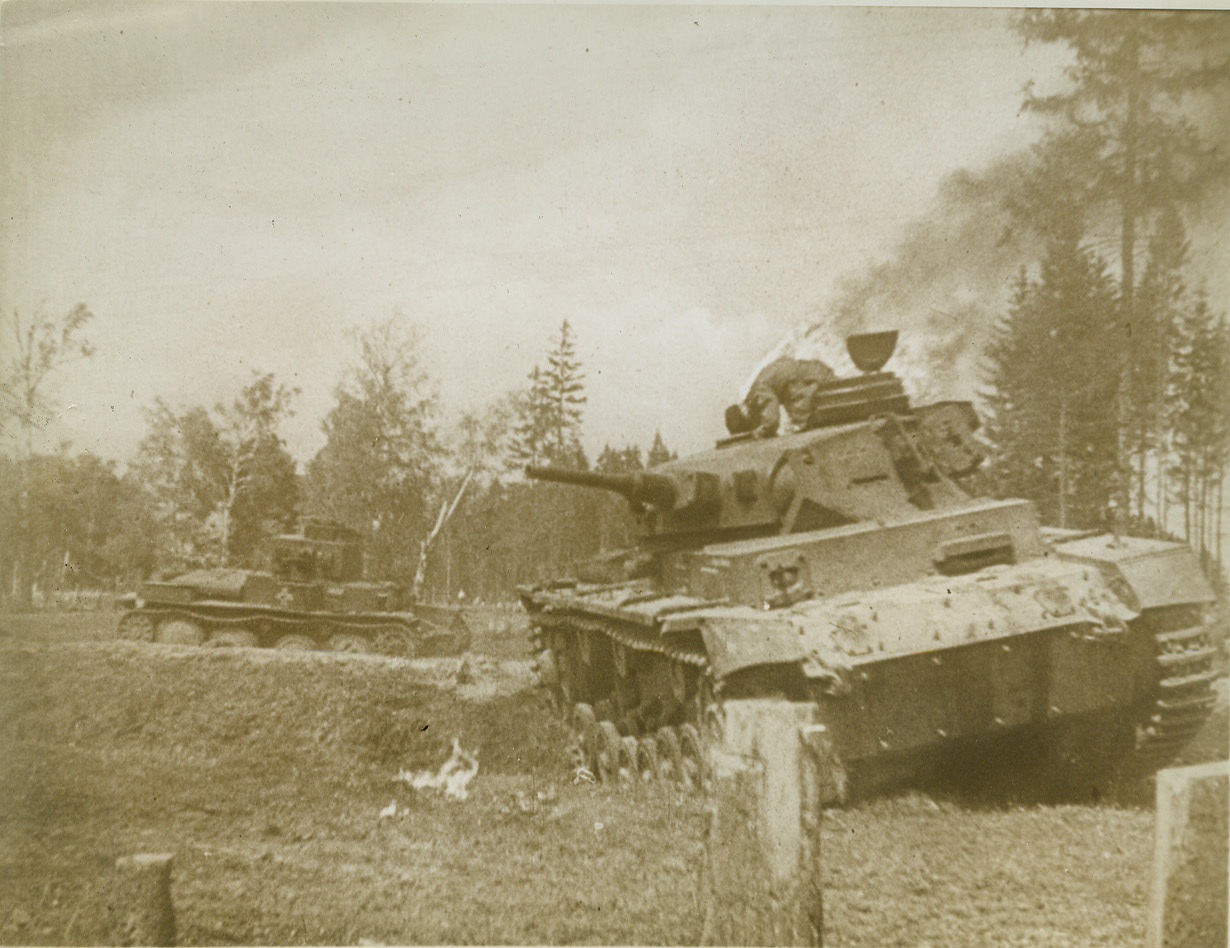
Nazi in Flames, 2/10/1943. ON THE RUSSIAN FRONT -- With flames licking at his uniform, a Nazi soldier tries to crawl from his knocked-out tank somewhere on the Russian front. Recent dispatches from Moscow reveal that the Red Army has taken Belgorod with a smashing blow that perils the chief Nazi base at Kharkov, east of the Dnieper River. Credit (Copyright March of Time Photo from ACME);
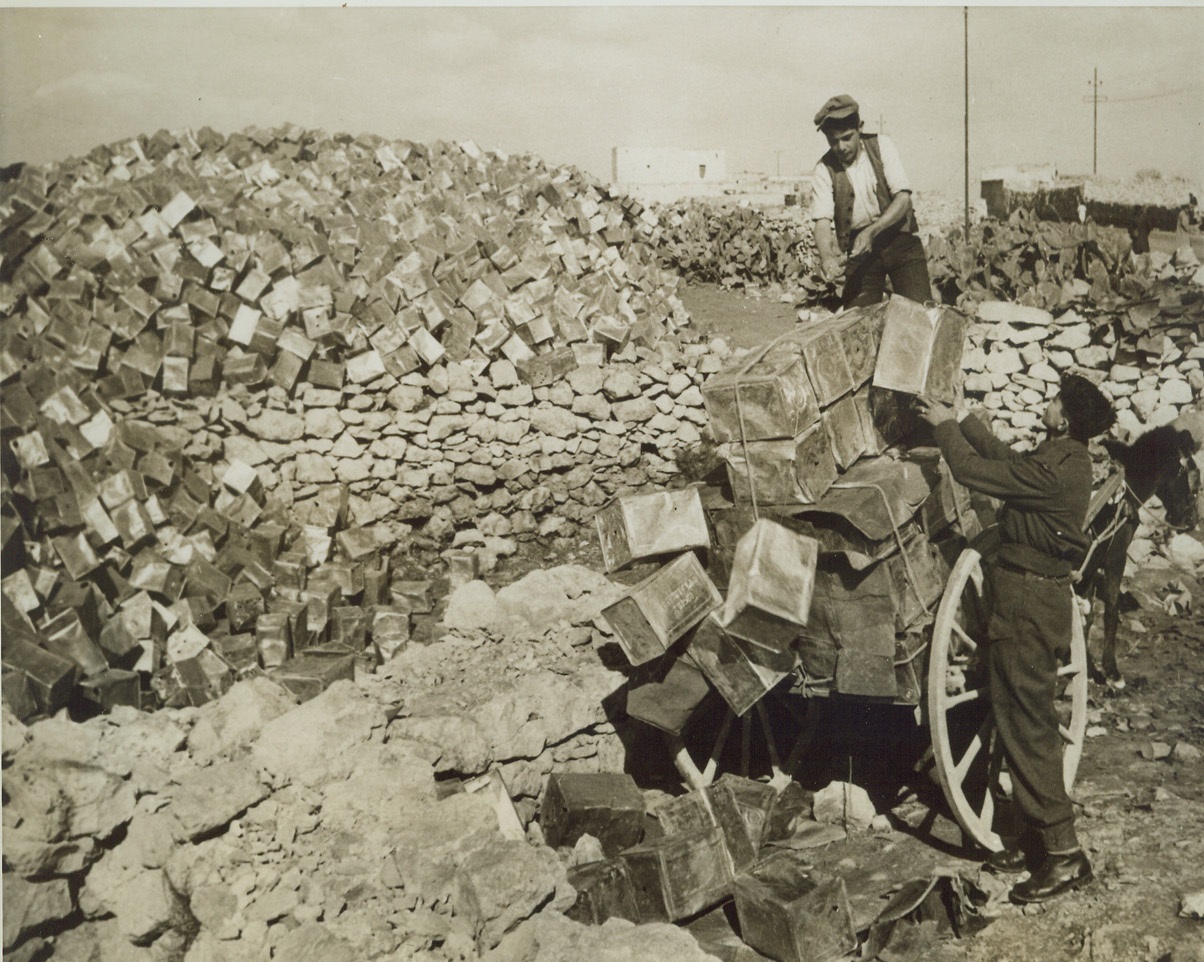
SALVAGE BIN, 2/17/1943. MALTA—When you take a look at these empty gasoline tins, piled along the edges of Malta’s farms, it’s easy to see that it takes an awful lot of the precious liquid to keep British planes in the air. The empty cans come from nearby airfields and are kept here pending future salvage. Credit: Acme;
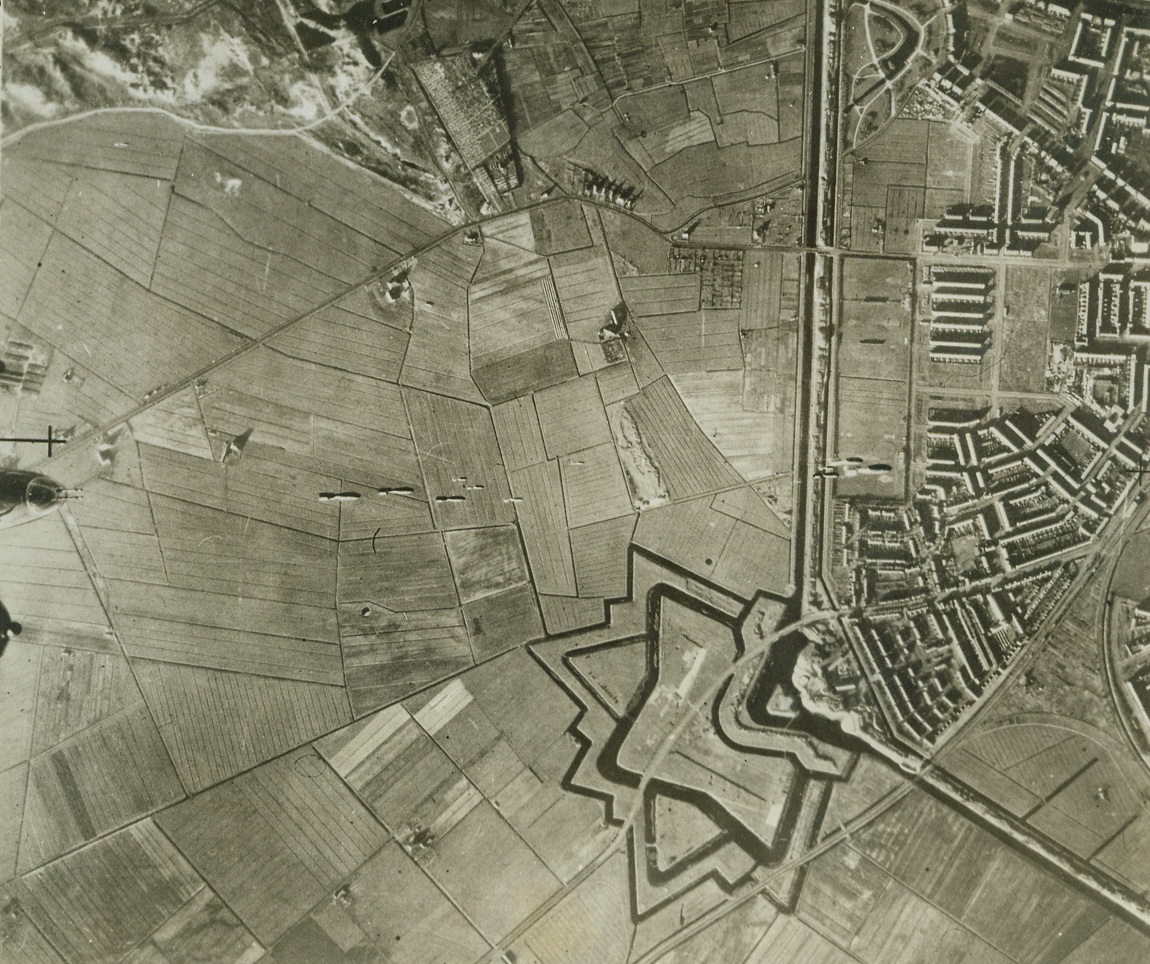
WARFARE—OLD AND NEW, 2/8/1943. HOLLAND—This aerial photo show R.A.F. bombs falling towards the docks at Den Helder in Holland. The nose of one of the attacking planes can be seen at the very bottom of the picture. The star-like pattern at the right is part of the ancient outer fortifications of Den Helder, which were the type used from the 16th century until Napoleon’s time. Credit: Acme;
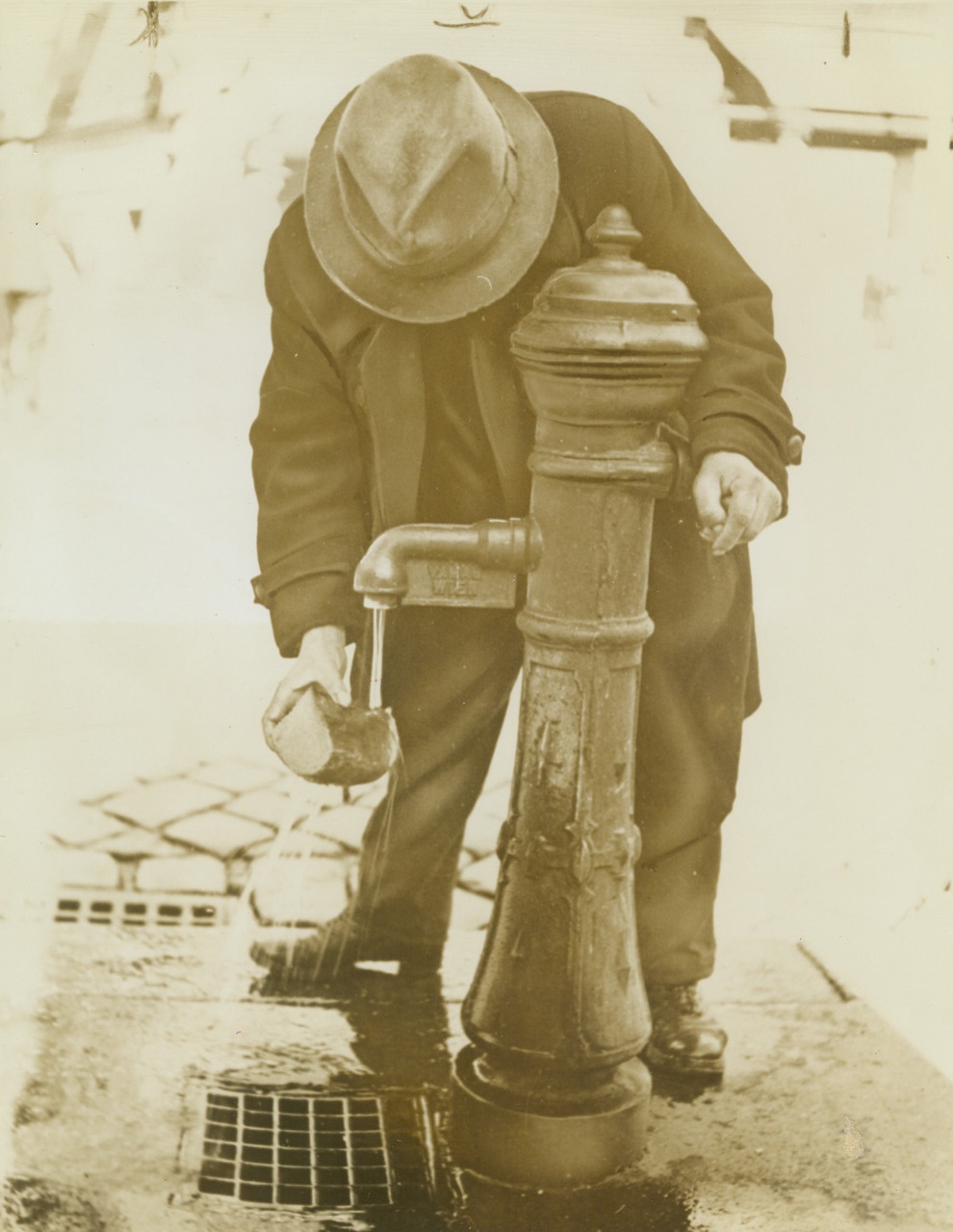
THE EUROPE THAT GERMANY MADE, 2/8/1943. When Hitler brought the New Order, its Gestapo, and its Storm Troopers to Europe, he taught the people of each country he occupied the true meaning of fear—and of hate. Those that resisted him, he killed ruthlessly—those that suffered his rule, were broken in spirit. Stout hearted, upright, and healthy souls and bodies were taught to cringe in the presence of the “Master Race.” It was a picture of this Europe that Hitler made, that is shown in this series of dramatic photos, which were taken by Roman Vishniac, and are on exhibition at Teachers College in New York City. The quotations used in the captions are Mr. Vishniac’s. NEW YORK BUREAU “The bread was old and he held it under the pump until it was soft again.” Credit: Acm;
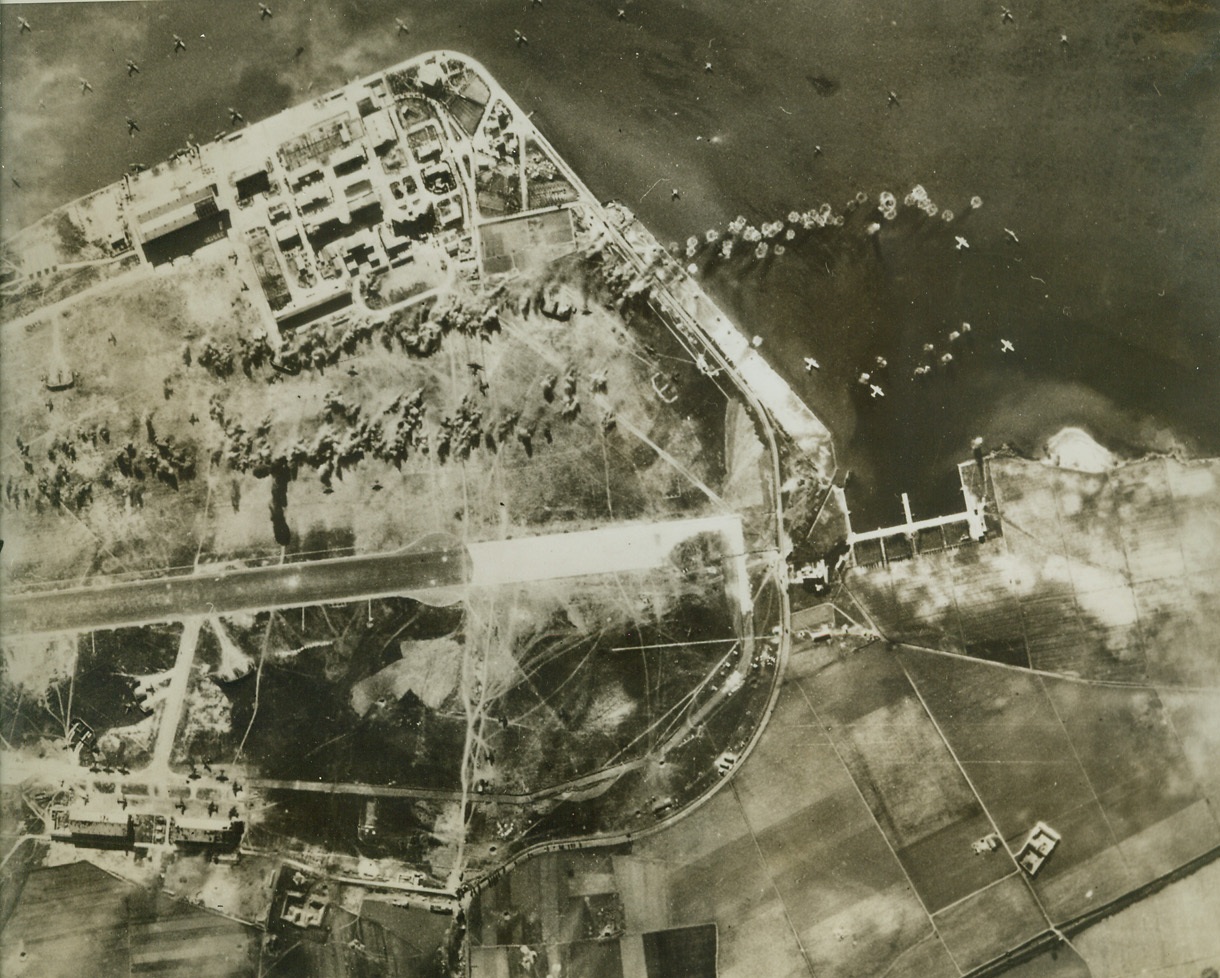
AMERICAN BOMBERS RAID SARDINIA, 2/24/1943. CAGLIARI, SARDINIA—Two strings of bombs from Flying Fortresses and Martin Marauder bombers of the U.S. Army Air Forces fall on the airdrome at Cagliari, damaging Axis sea and land planes, during a daylight attack. All of our bombers, protected by Lockheed Lightning Fighters, returned from the raid safely. Credit: U.S. Army Air Force photo from Acme;
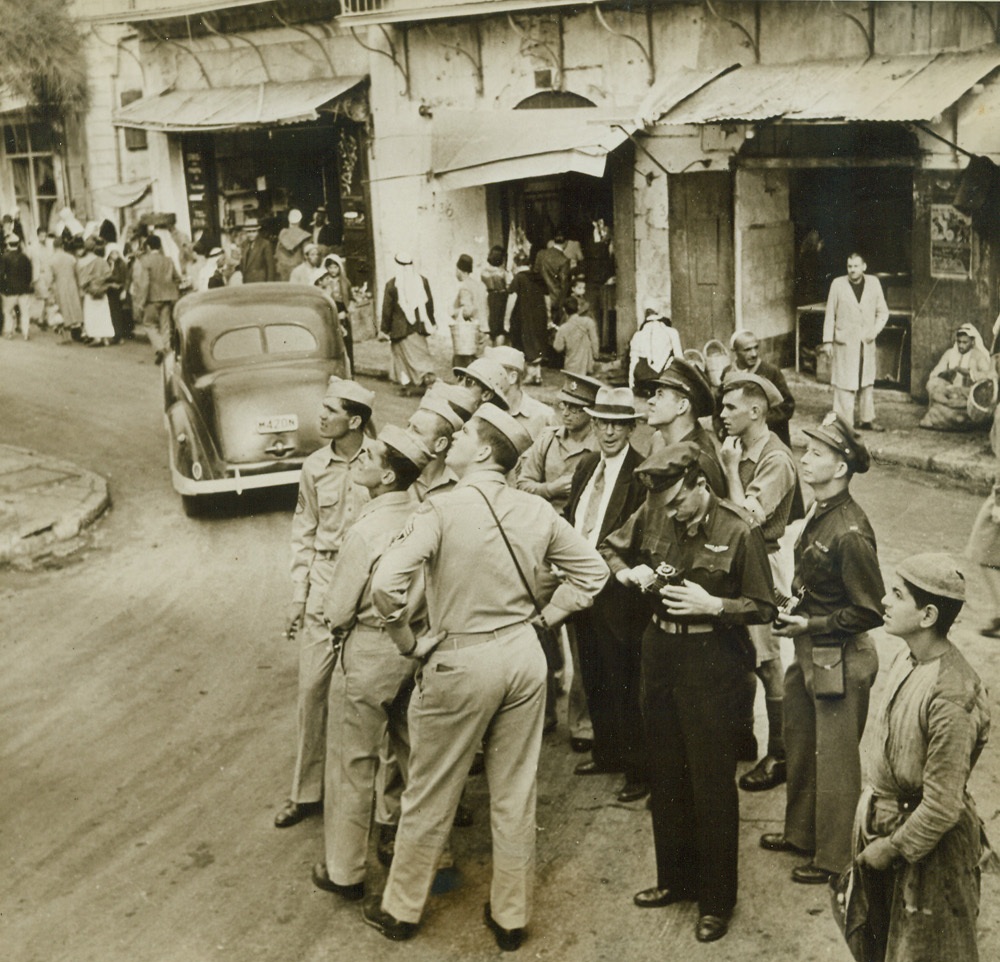
No Title, 2/2/1943. Recently the crew of a Liberator bomber of the U.S. Army Air Forces, which had been stationed in the Middle East and had seen action against the enemy, was given a short holiday. They decided to visit Jerusalem. Under the guidance of an American minister named Adams, they saw the many interesting sights in the Old and New Cities, their trip being planned for them by the YMCA. In this series of photos, which has just been released, the American fliers are shown during their visit. NEW YORK BUREAU Members of the crew gaze up at David’s Tower as Mr. Adams (center of group) explains its history. One of the Americans gets his camera set for a picture of the scene. Credit: Acm;
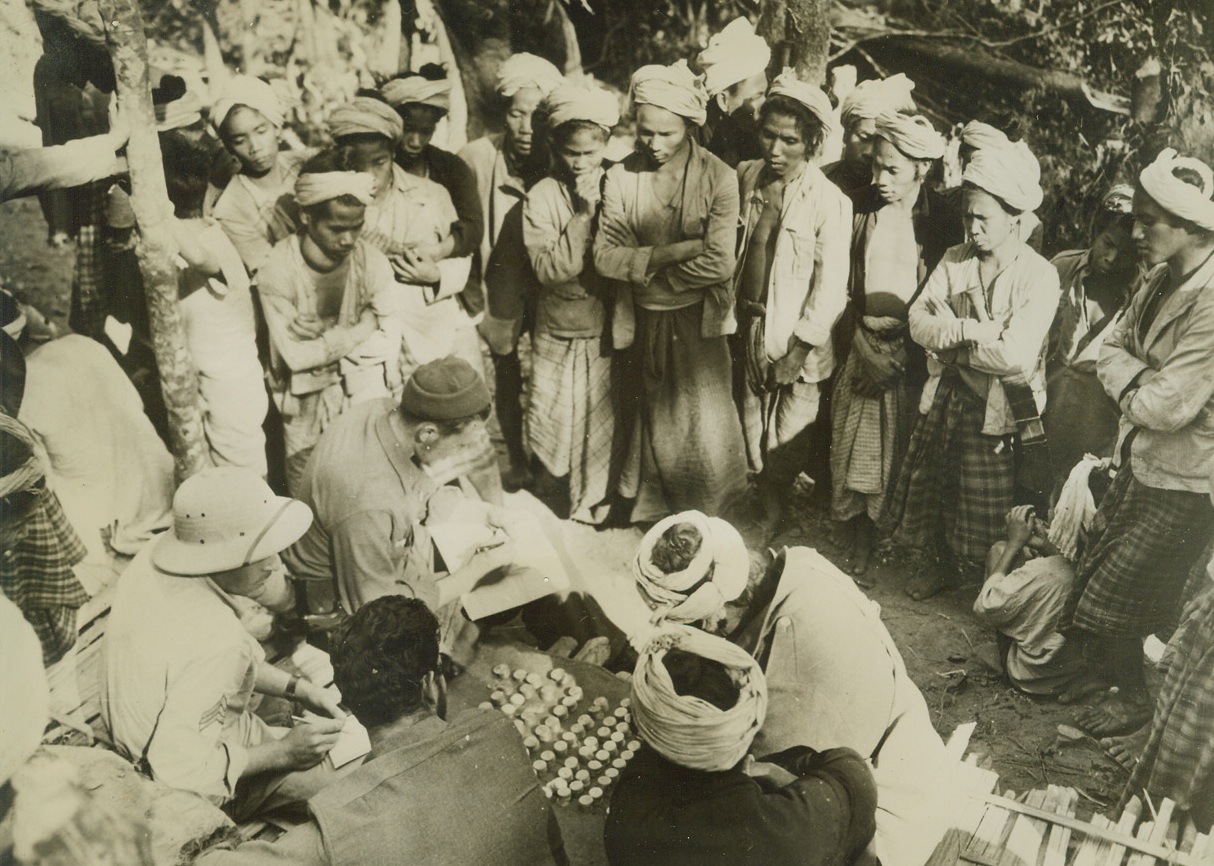
NAGA PAY DAY, 2/10/1943. SOMEWHERE IN INDIA—Nagas eagerly crowd around the stacks of silver rupees in which they are paid for their work assisting the U.S. troops in India. The Naga chief and his assistant sign regular U.S. Army pay vouchers by inked thumb prints. These natives, who move supplies, refuse paper money. Watching the dark-skinned workers get their coin are Pfc. Richard Maccio, East Rochester, N.Y. (foreground, back turned); Sgt. Milton F. Elkins, Haskell, Texas (sun helmet left) and Sgt. Wm. L. Dean, San Francisco (sun helmet), who works on the pay vouchers. Credit: Official U.S. Army photo from Acme;
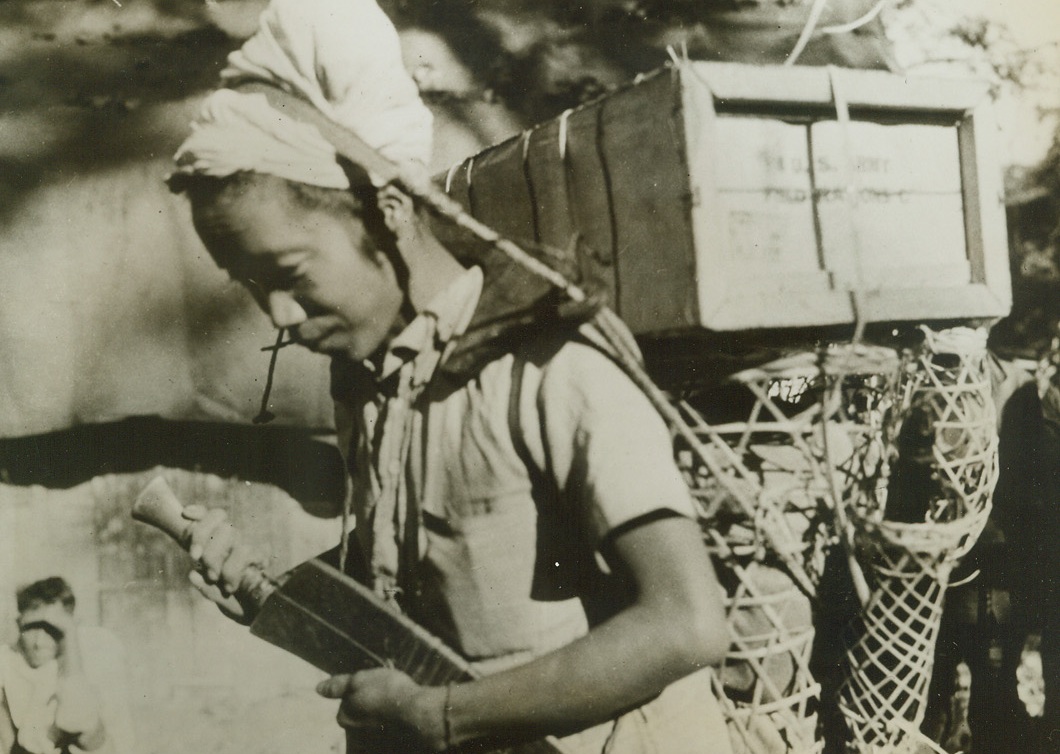
NAGAS DO PORTER DUTY IN INDIA, 2/19/1943. SOMEWHERE IN INDIA—A typical Naga, the type of Indian native who is carries supplies for U.S. troops in India, all set and ready for the hike. The pack harness has a wooden yoke for his shoulders and the basket contains rice and other coolie rations. On top of the basket is a case of U.S. Army field rations “C” which weighs about 40 pounds. The little Nagas usually carry 60-pound loads. Credit: Official U.S. Army photo from Acme;
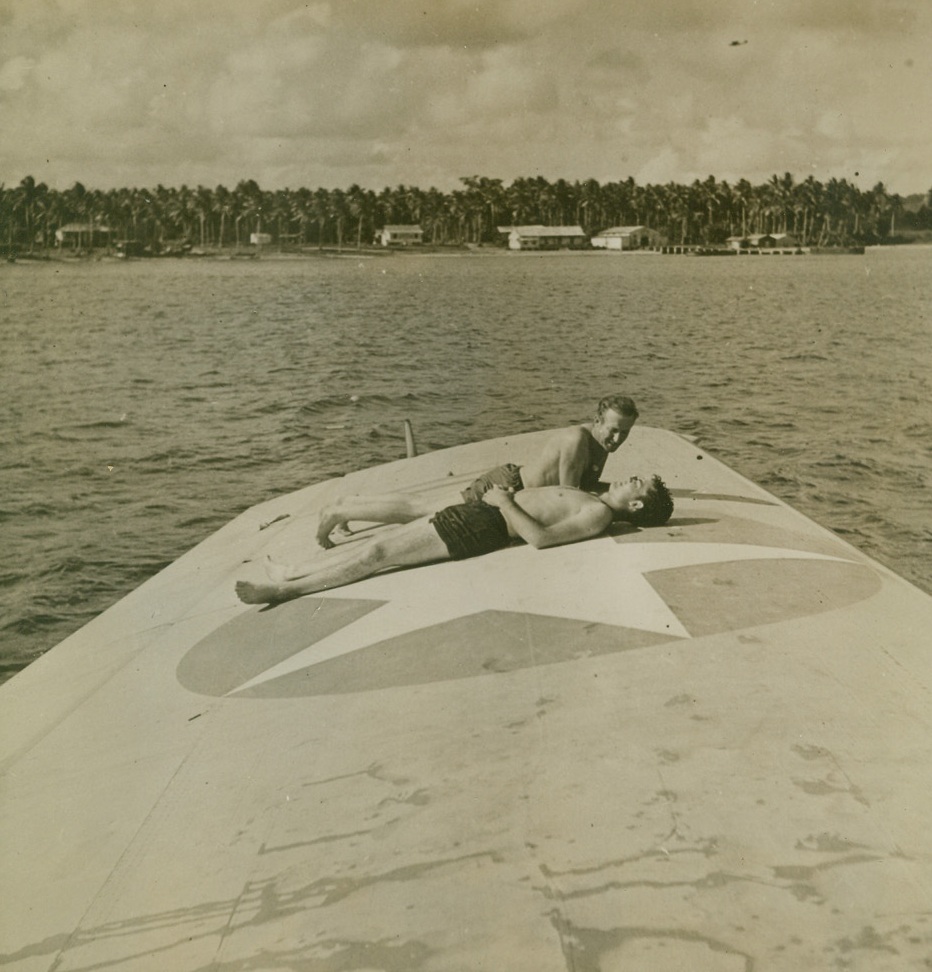
HO-HUM, 2/12/1943. SOUTH PACIFIC—Two American fighters, based aboard “The Seaplane Tender,” stretch out on the wing of a plane and lap up a little South Pacific sun. Their plane is one of many on the giant floating repair station which has shops and equipment for the complete overhauling of aircraft. Pilots and crews live aboard the sea-based garage and do might well, too, for the ship has a barber shop, canteen, soda fountain and even a laundry. Credit Line (ACME);
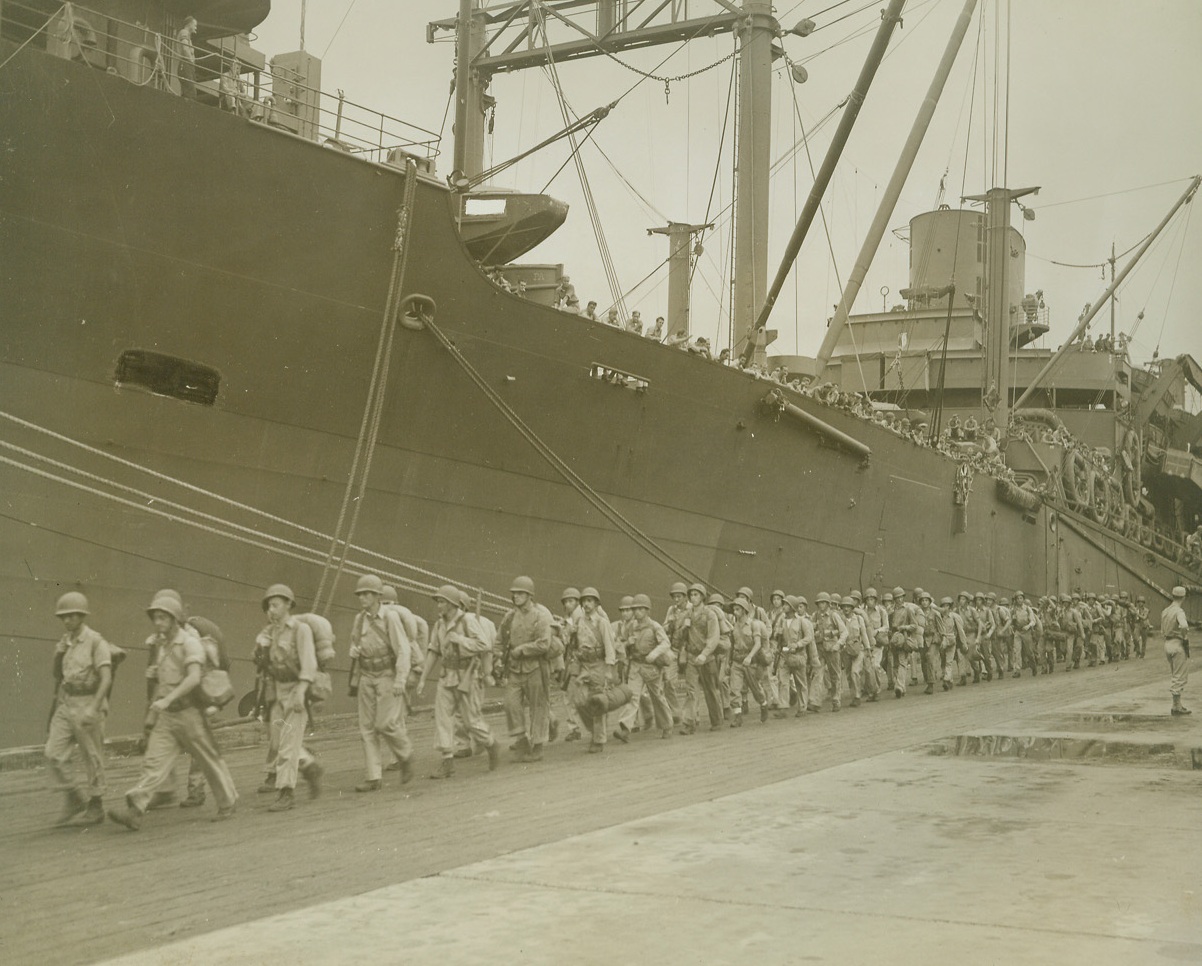
…GUADALCANAL, 2/11/1943. …U.S. Marines leave the troop…that brought them from Guadalcanal…to trucks that will take them to …at a South Pacific base. The hardy Leathernecks left a record which the U.S. Army fighters, who relieved them, will have a hard time equaling. Credit Line (ACME);
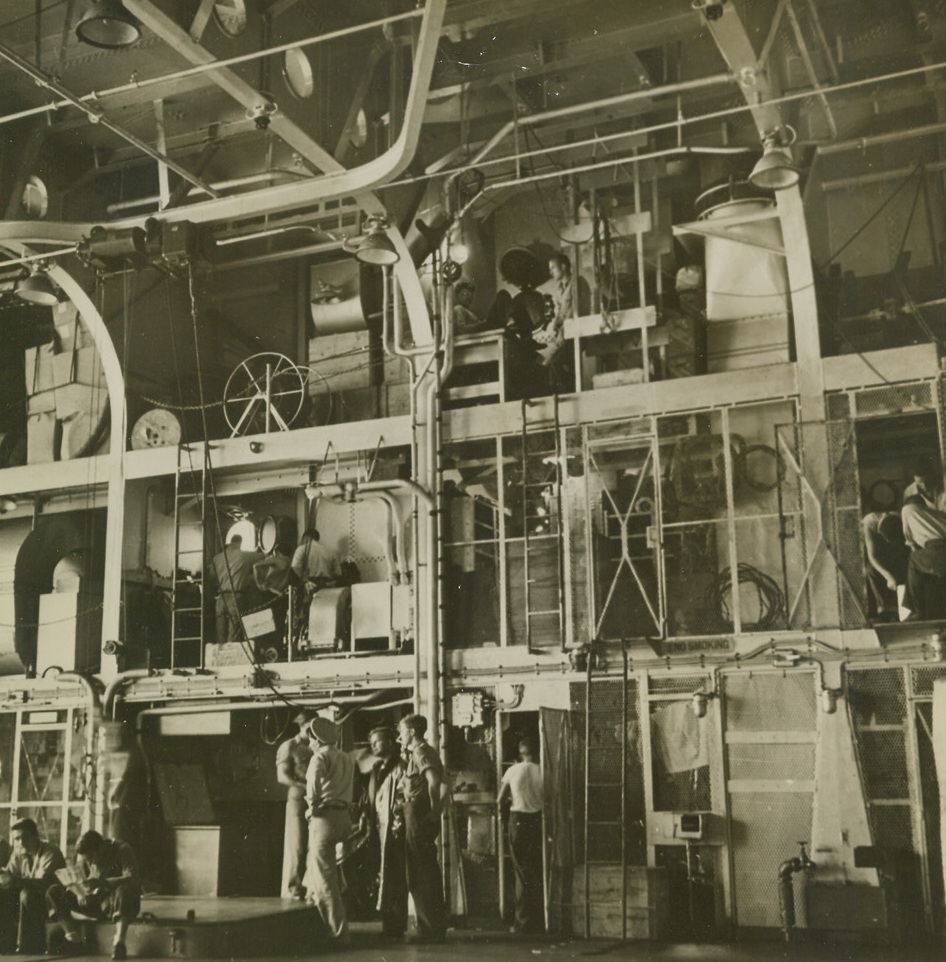
FLOATING REPAIR BASE, 2/12/1943. SOUTH PACIFIC—The side walls of the hangars on “The Seaplane Tender” – a floating U.S. plane repair station – contain storage space and every inch is utilized. The ship which is based in the South Pacific and operating in Solomons’ battles, has shops and equipment for the complete repair and overhaul of PBY’s. These are the Navy planes which have been used to search enemy waters, do anti-sub patrols, make night bomb and torpedo attacks against enemy surface craft and scout enemy task forces. The seaplane tender even has a barber shop, laundry and soda fountain. Credit Line (ACME);
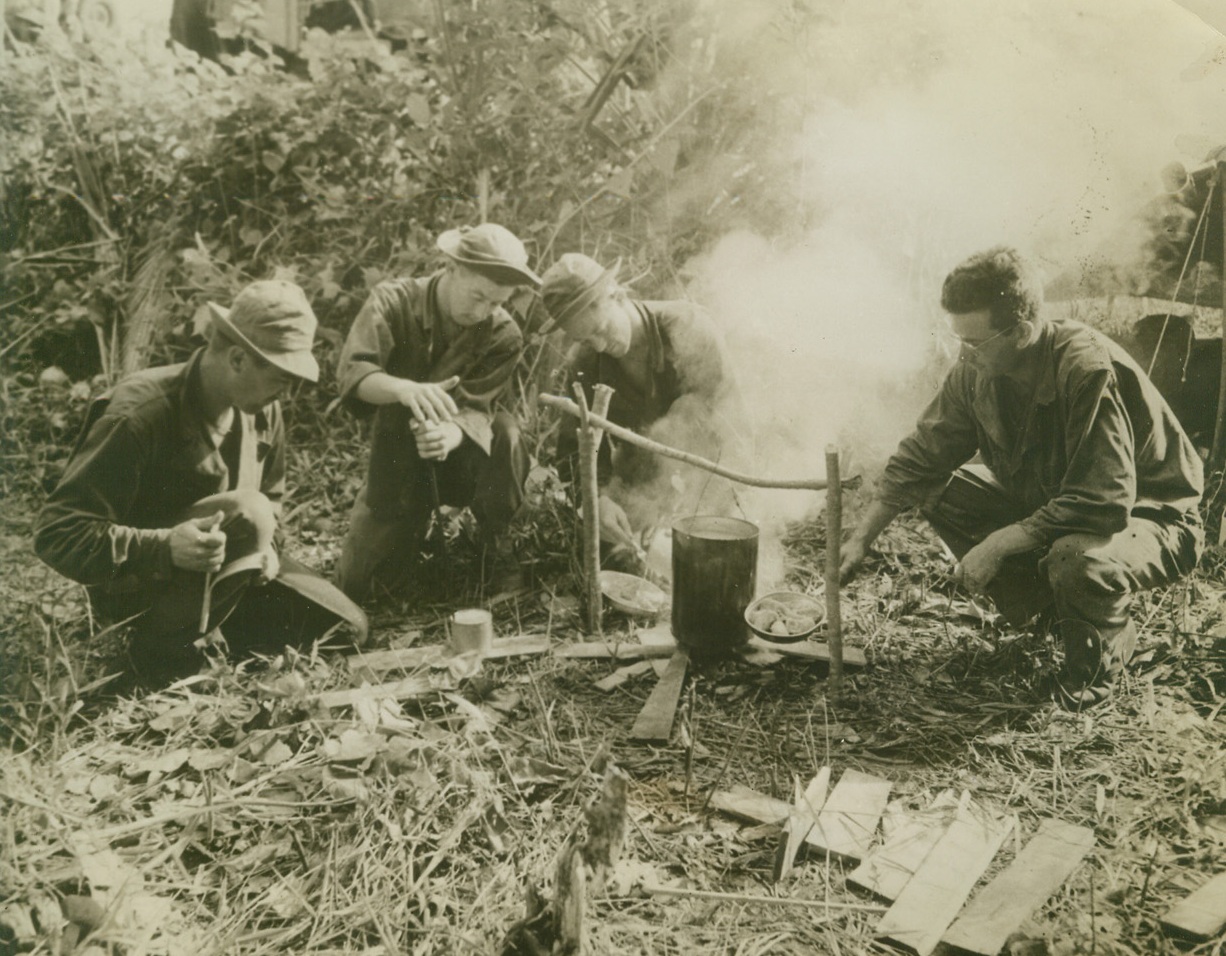
CHOW FOR YANKS IN BUNA, 2/10/1943. BUNA, NEW GUINEA—Soldiers of the 32nd United States Division, take time out from fighting Japs in the Buna sector, to attack their field rations, which they heat over a small fire. Left to Right, are: Pvt. Joseph F. Bitner, of Garwood, Texas; Pfc. Richard J. Leddy, of Detroit, Mich.; Pvt. Lewis M. Hawes, Aberdeen, Idaho, (who was later reported missing) and Pvt. Rodney F. Corter, Tucson, Ariz. Since this photo, which was released in Washington today, was taken, American and Australian forces have cleaned the Japs out of Buna, killing some 15,000 of them. Yesterday, Tokyo finally admitted that the Japanese had “withdrawn” from Buna. Credit Line (U.S. Army Photo from ACME);
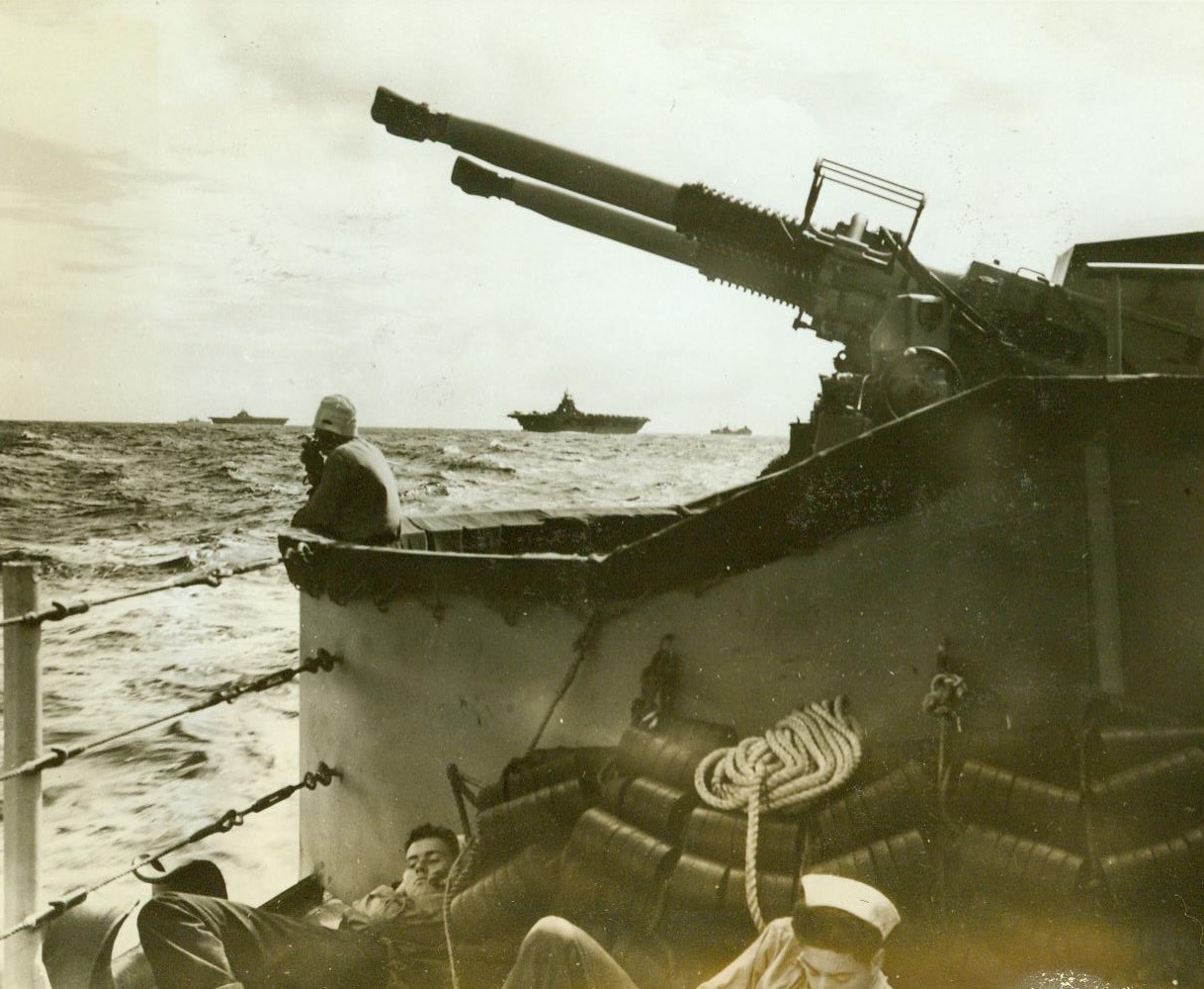
Navy’s Hard-Hitting Carrier Forces, 2/14/1943. Beneath a warship’s dual purpose guns, a pair of carriers of the 25,000 – ton Essex class steam toward Wake Island in one of the first combat photos of the new flat-tops. Starting with a blow at Marcus Island on Sept. 1, they have followed up with attacks on Wake Island, October 5-6; Rabaul, November 5 and 11; Makin and Tarawa, November 20, and are presently engaged in assaults on the Marshalls and Nauru. 12/14/43 Credit (Official U.S. Navy Photo From ACME);
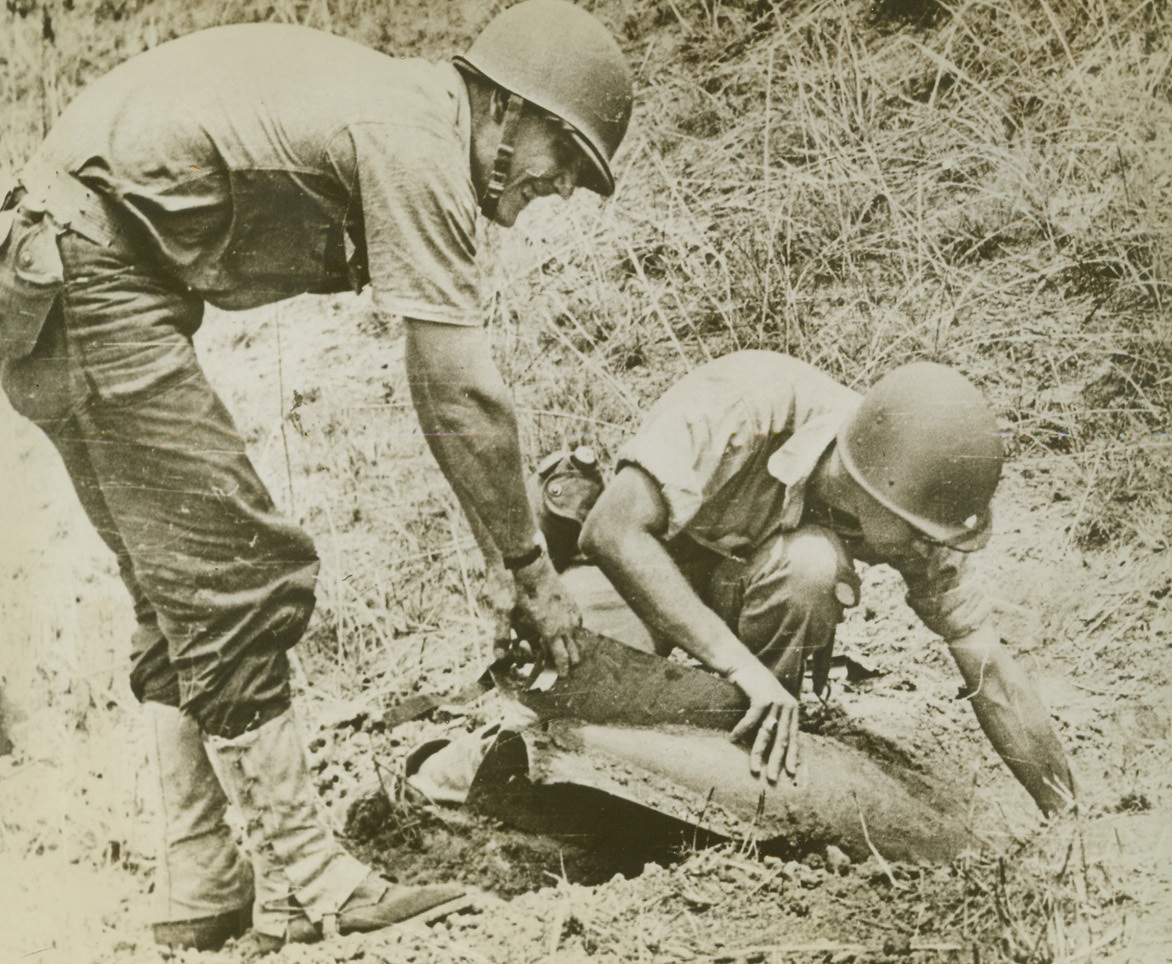
Ticklish Job, 2/5/1943. Guadalcanal, S.I. – U.S. Marines remove a Jap bomb from the ground on Guadalcanal, using extreme care in excavating the dirt around the bomb, for the least jar sometimes sets the bomb off. After being removed, the bomb is taken apart - - another ticklish job that calls for high technical skill.Credit (U.S. Marine Corps photo from ACME);
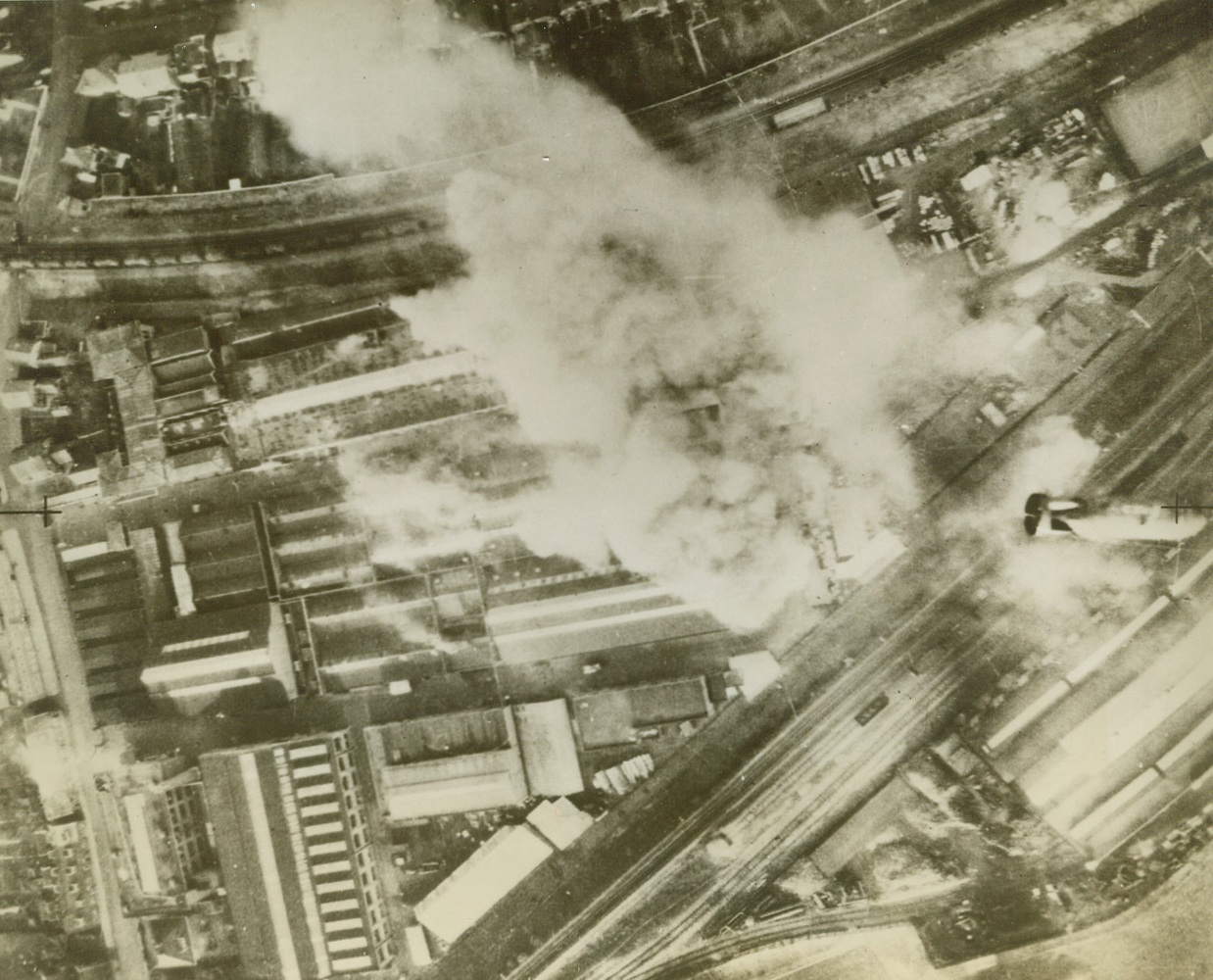
MOSQUITOS STING STORK, 2/5/1943. HENGELO, HOLLAND—As a bomb (lower center) from a Mosquito aircraft of the R.A.F. Bomber Command heads for the target, smoke from another direct hit pours from the south end of the Stork Engineering and Diesel Engine Works at Hengelo, Holland. This successful blow against Nazi U-boat production was struck in a daylight raid, January 20. Credit Line (ACME);
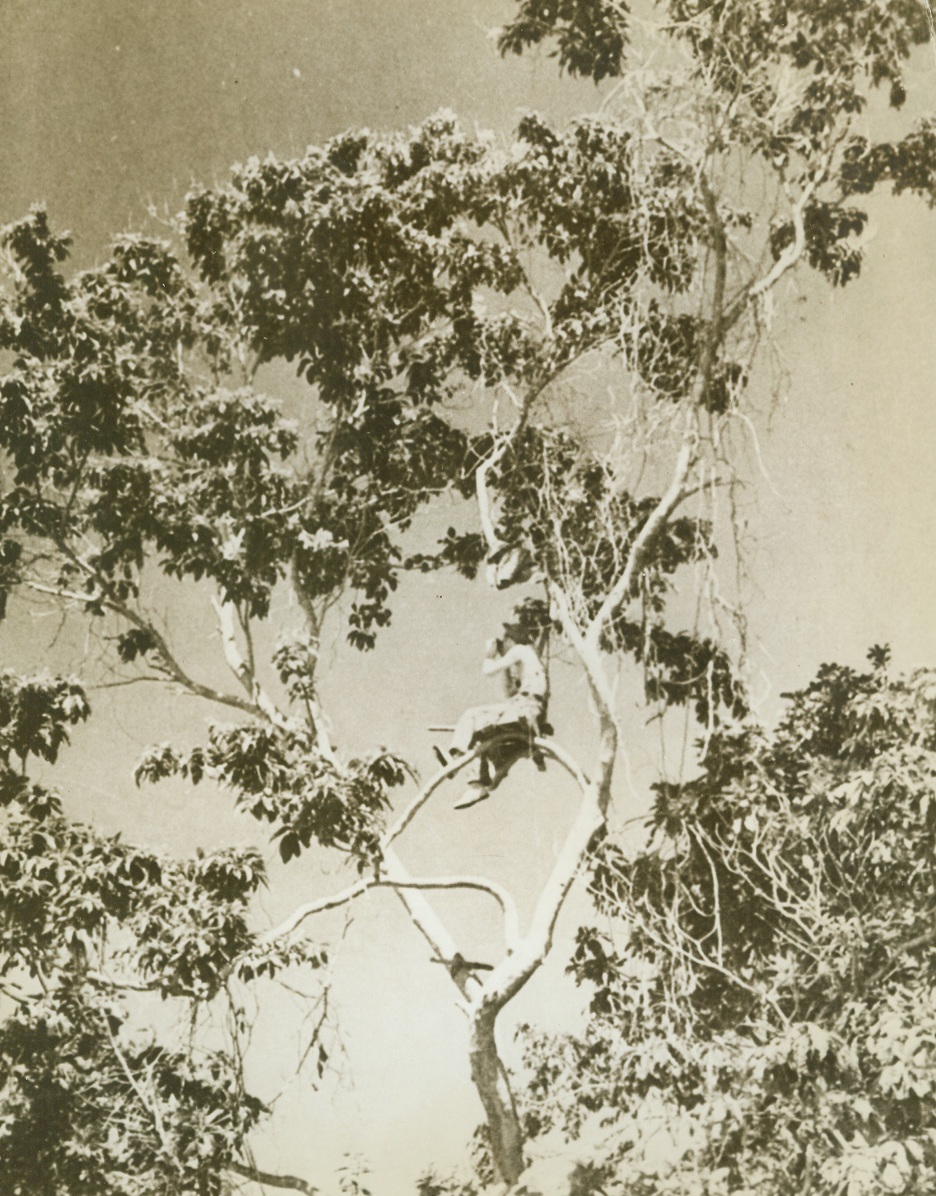
Best Camouflage is No Camouflage, 2/5/1943. Guadalcanal, S.I. - - The best camouflage for Marines doing this type of observation work on Guadalcanal is no camouflage at all. This Marine’s shirtless back and light colored pants blend well with the whitened tree trunk against the sky. Latest dispatches from the Solomons indicate that the Japs are stepping up their air attacks on American bases on Guadalcanal.Credit Line (U.S. Marine Corps photo from ACME);
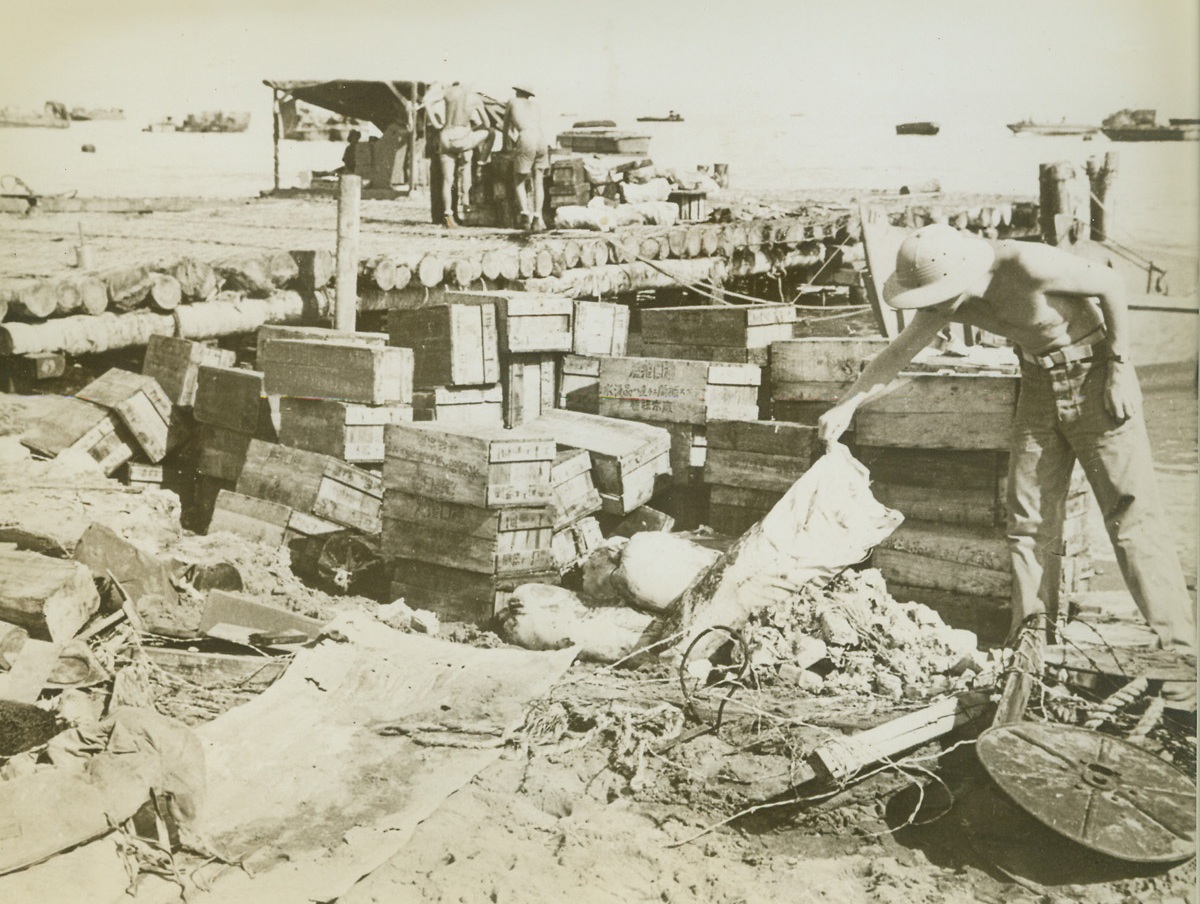
Right Street - - Wrong House, 2/5/1943. Guadalcanal – A U.S. soldier curiously inspects a bag of food among the Jap provisions thrown overboard by enemy destroyers and picked up by our ships off Guadalcanl. The Nips have had a difficult time supplying their hard-pressed fighters on the South Pacific island.Credit Line (ACME);
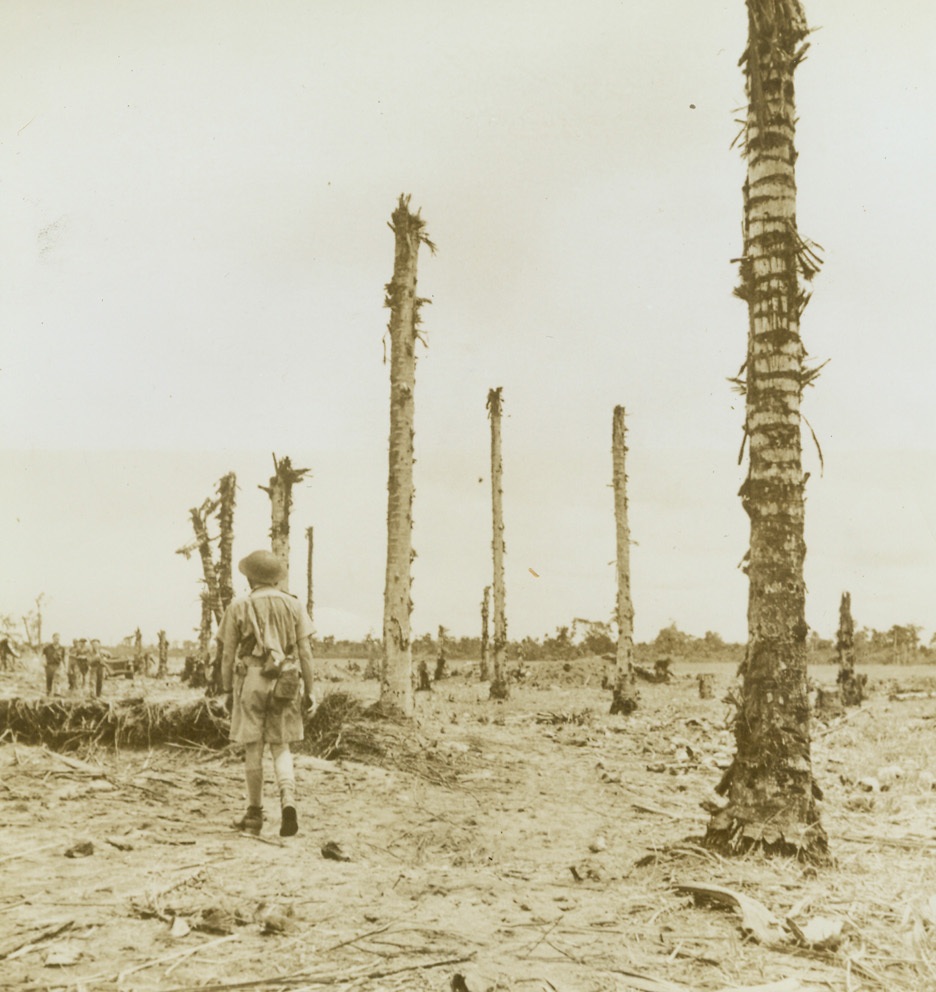
Cocoanut Grove, 2/6/1943. New Guinea – Stripped of their bark, their fruit and their foliage, these bare cocoanut trees stand as grim reminders of the fierce fighting that took place at this end of Old Air strip during the Buna campaign. Australian 25 pounders and artillery fire wrecked the graceful trees as well as the Japs. Latest reports received indicate that the Japs have been routed from Papua and are now being subjected to heavy pounding from Allied aircraft at Lae.;
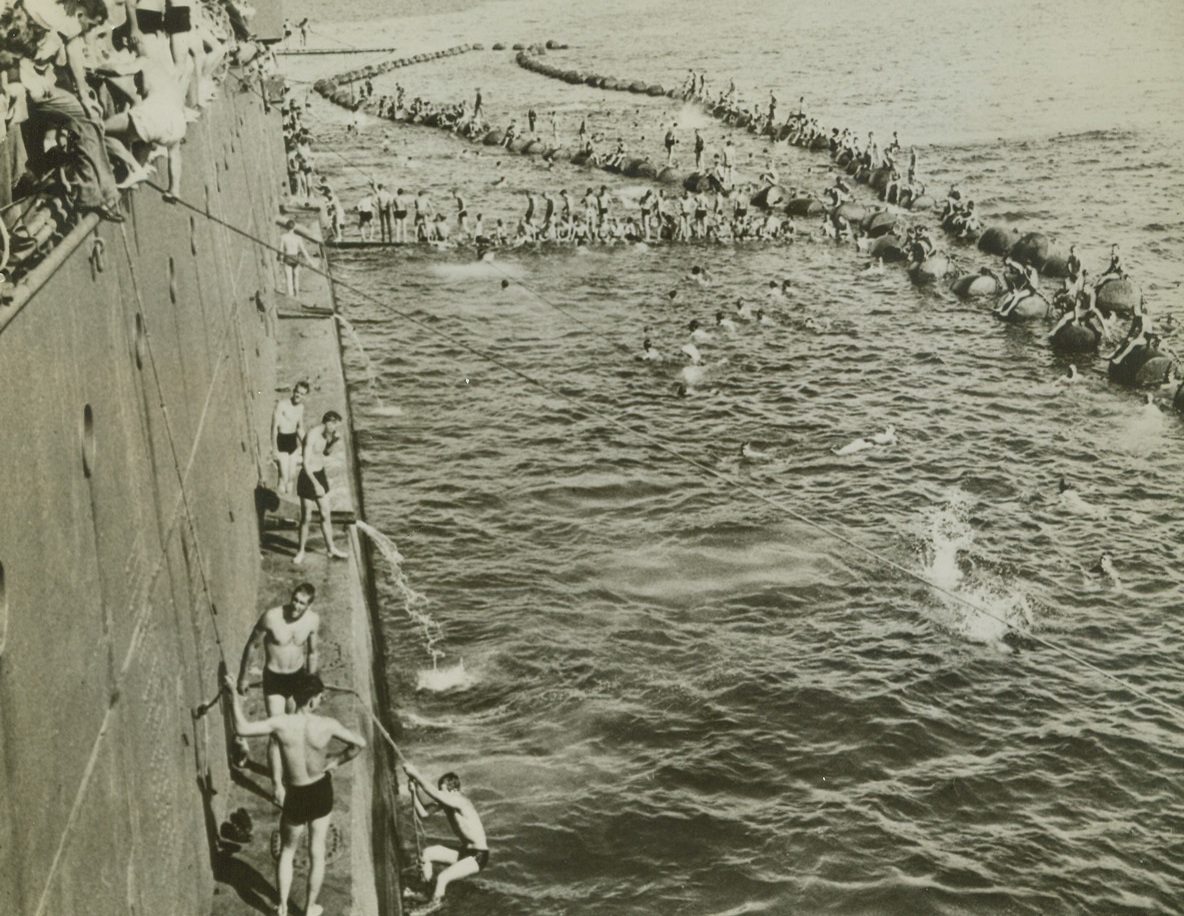
First Day “Ashore”, 2/12/1943. South Pacific – The minute their transport ship anchored, after a long and tedious convoy trip to a South Pacific island, all U.S. fighters aboard “abandoned ship” for a swim in the warm water. Here, they take high dives, clamber aboard buoys, and thrash around in the water. War, for the moment, is forgotten.Credit Line (ACME);
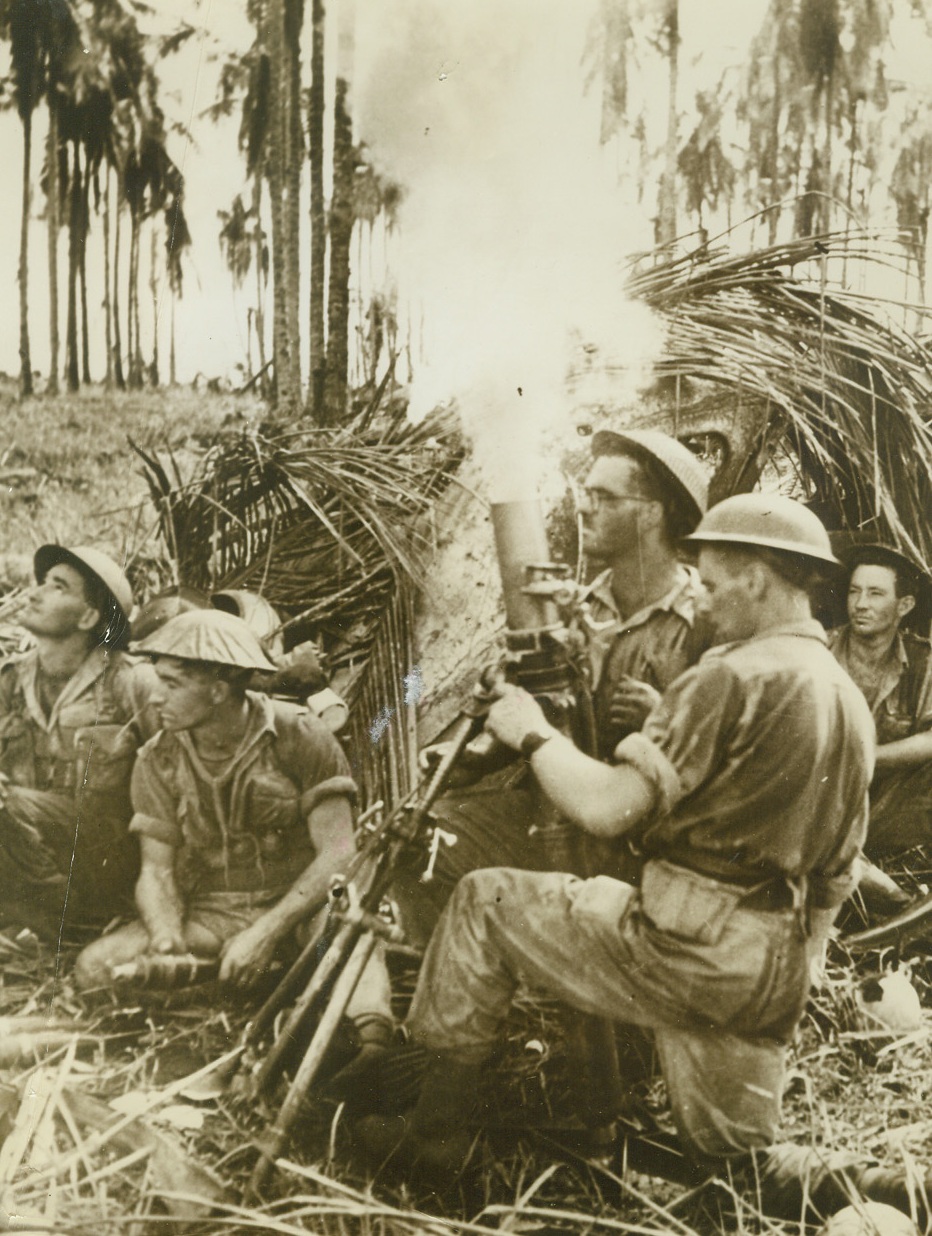
Nipping the Japs, 2/8/1943. New Guinea – An Australian mortar crew lays down a barrage at the Japs near Buna. Note that the guns are almost pointing straight up – showing the nearness of the enemy. This is one of the first pictures showing the final assault on the port of Buna in New Guinea.Credit Line (ACME);
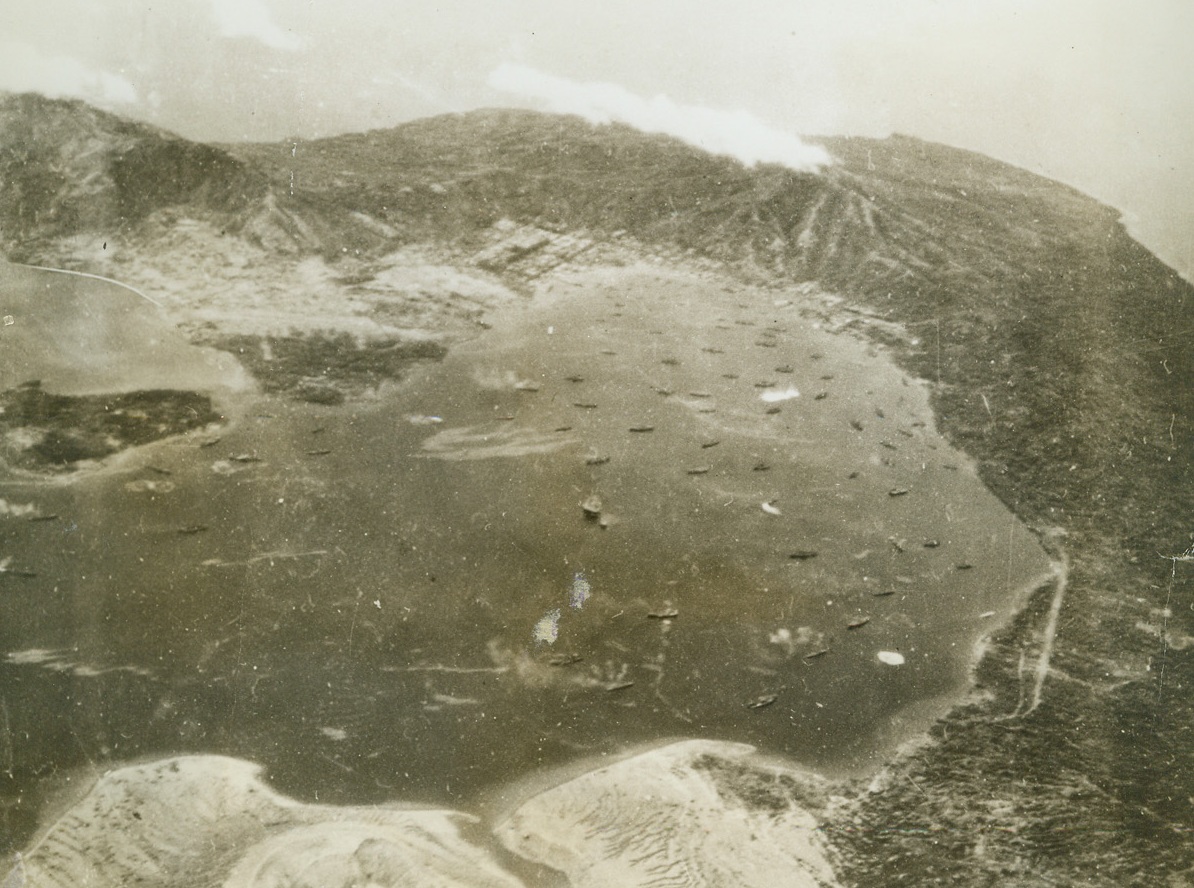
U.S. Bombers Blast Rabaul Harbor, 2/9/1943. United States Army Air Forces heavy bombers recently surprised and dispersed a heavy concentration of Japanese vessels at Rabaul, New Britain. This photo, made from one of the raiding planes and released in Washington today, was made as American bombs began to fall amongst Jap ships in Rabaul Harbor. Two bomb explosions (white spots) can be seen; (1), just to the right of center of photo, and, (2), lower right in photo. It was announced in both Washington and in Tokyo, today, that Jap forces had withdrawn from Guadalcanal and Buna.Credit Line (U.S. Army Air Forces from ACME);
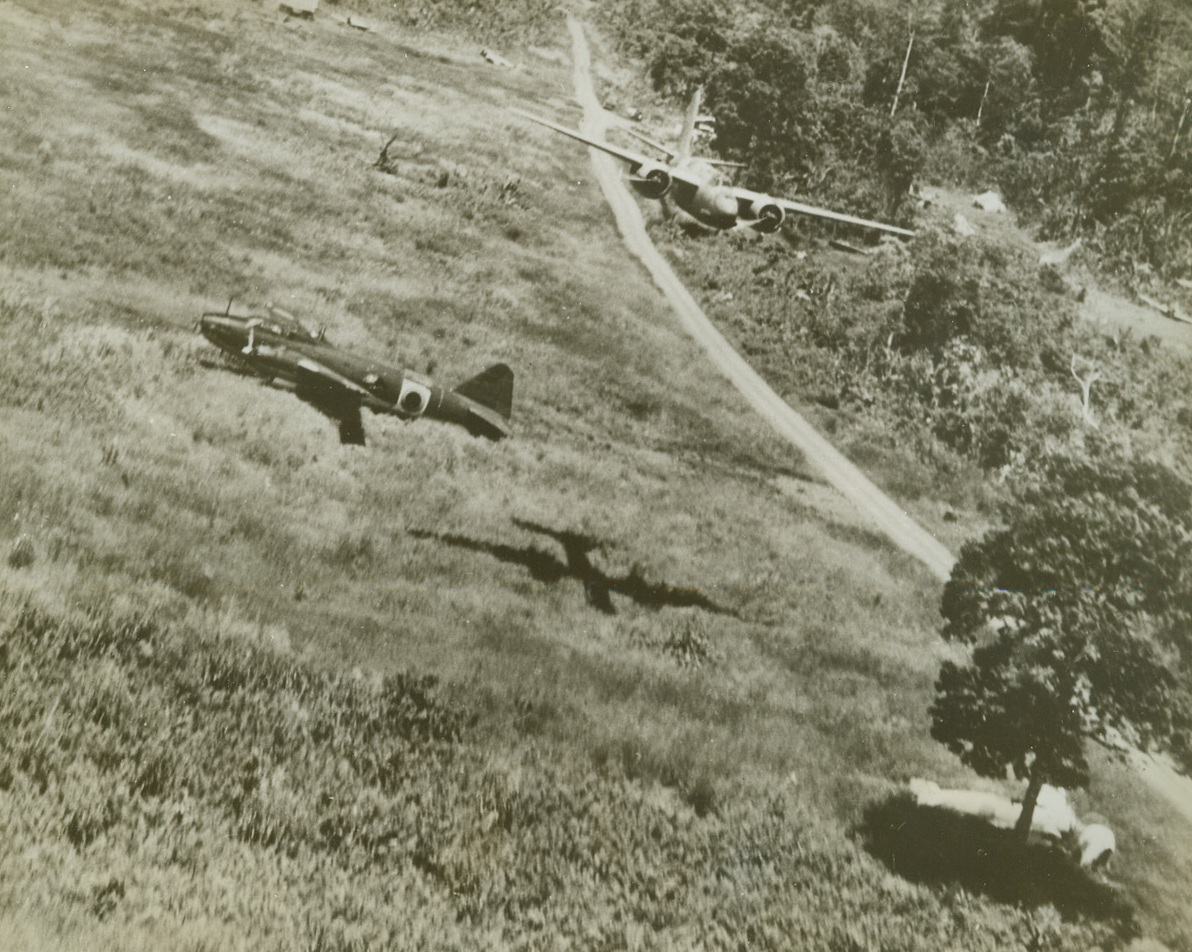
American Bomber Wallops Jap Planes, 2/2/1943. New Guinea – An American A-20 skims mere 100 feet above the ground at Lae, New Guinea, in a strafing attack on Jap planes. It is passing over a disabled enemy bomber that will never fly again. Under the tree (right), rests a Jap zero which has received its quota of American lead while another zero (edge of clearing, upper right) also will never see action again. Two more enemy aircraft are near house (top center).Credit (U.S. Army Air Corps photo – ACME);
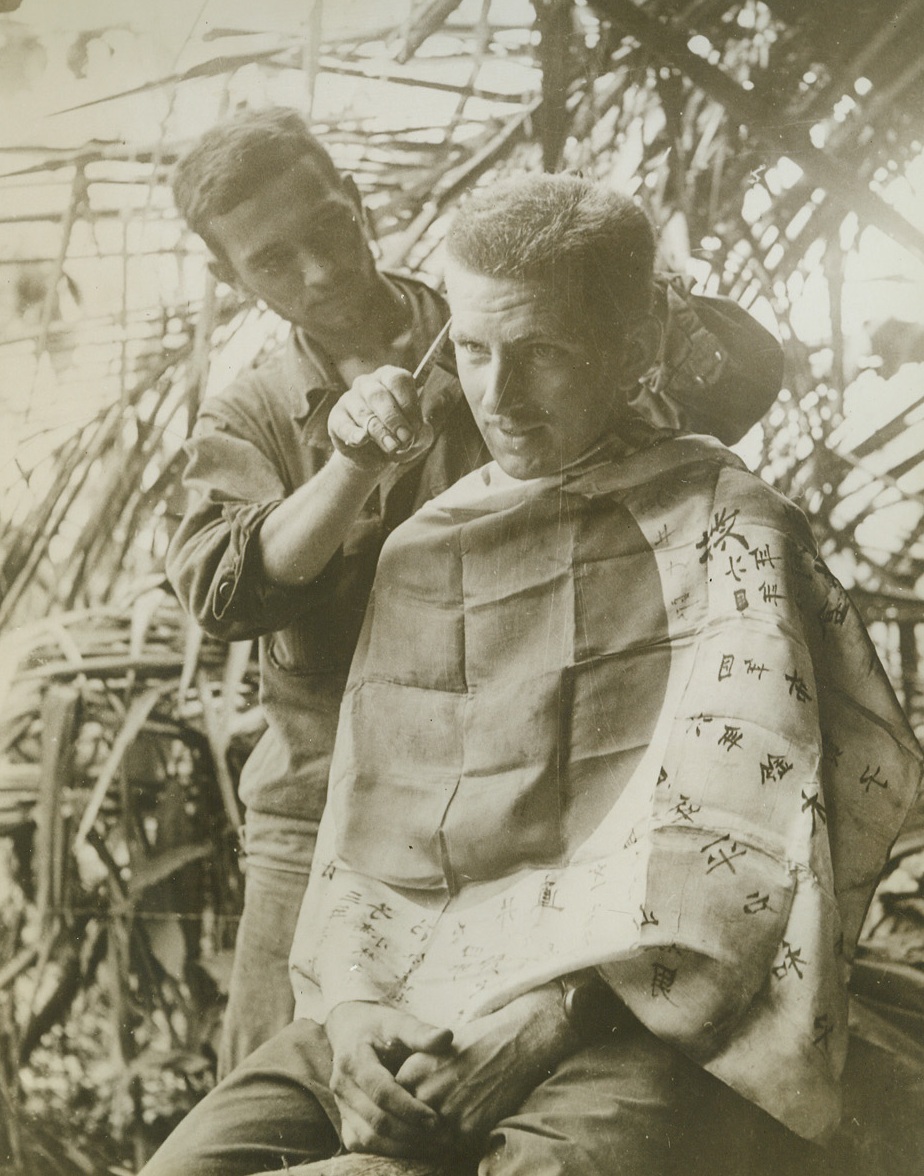
LET THE HAIRS FALL WHERE THEY MAY, 2/6/1943. NEW GUINEA—This soldier by isn’t proud. He’ll use any old rag for a barber’s apron while he gets his hair cut—and so he drapes a Jap flag about his shoulders to catch the falling hairs. Photo was made during the Buna campaign. Recent reports from New Guinea indicate that Allied forces have routed the Japs from Papua and are now pounding Jap positions at Lae. Credit: ACME.;
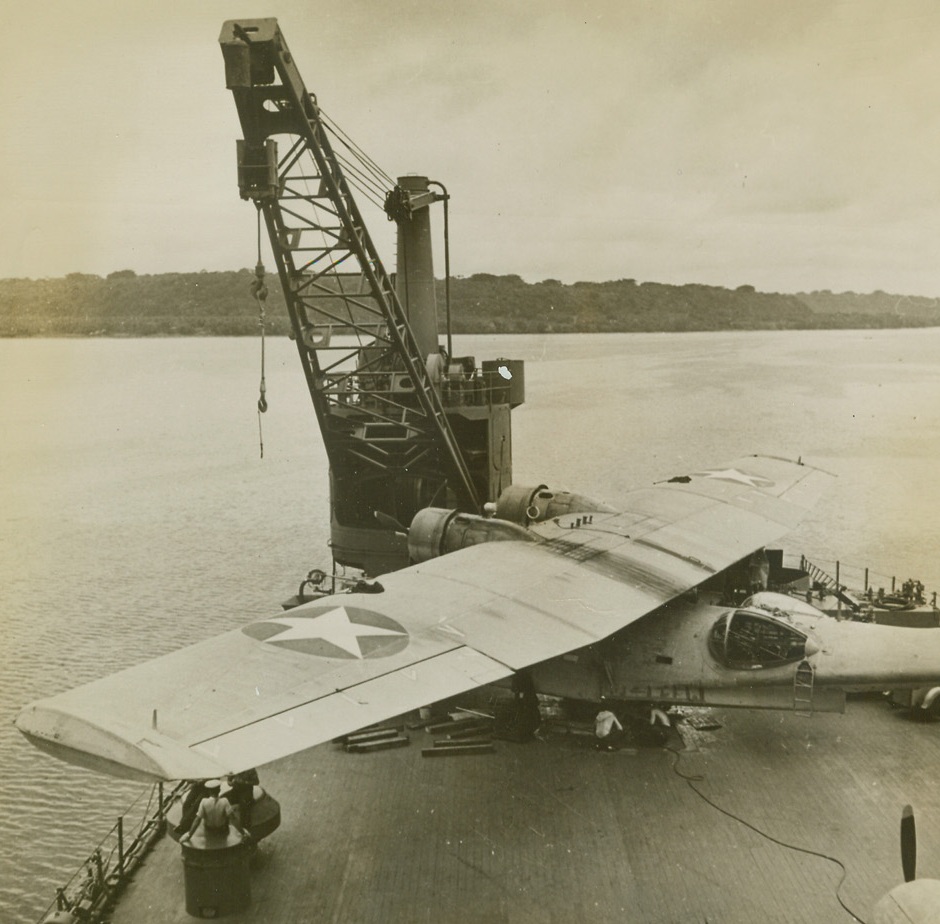
U.S. AIRCRAFT GARAGE AT SEA, 2/12/1943. SOUTH PACIFIC—Expert repair crews aboard “The Seaplane Tender” go to work on a PBY which has just been lowered to the after deck. The huge vessel, based in the South Pacific, contains hangars, shops, and equipment for the complete overhaul of the PBY’s which are used to search enemy waters, bomb or torpedo enemy surface ships, scout Jap task forces, or patrol our bases for enemy subs. Pilots and crews live aboard the vessel which boasts a barber shop, soda fountain, canteen and laundry. Credit: ACME.;
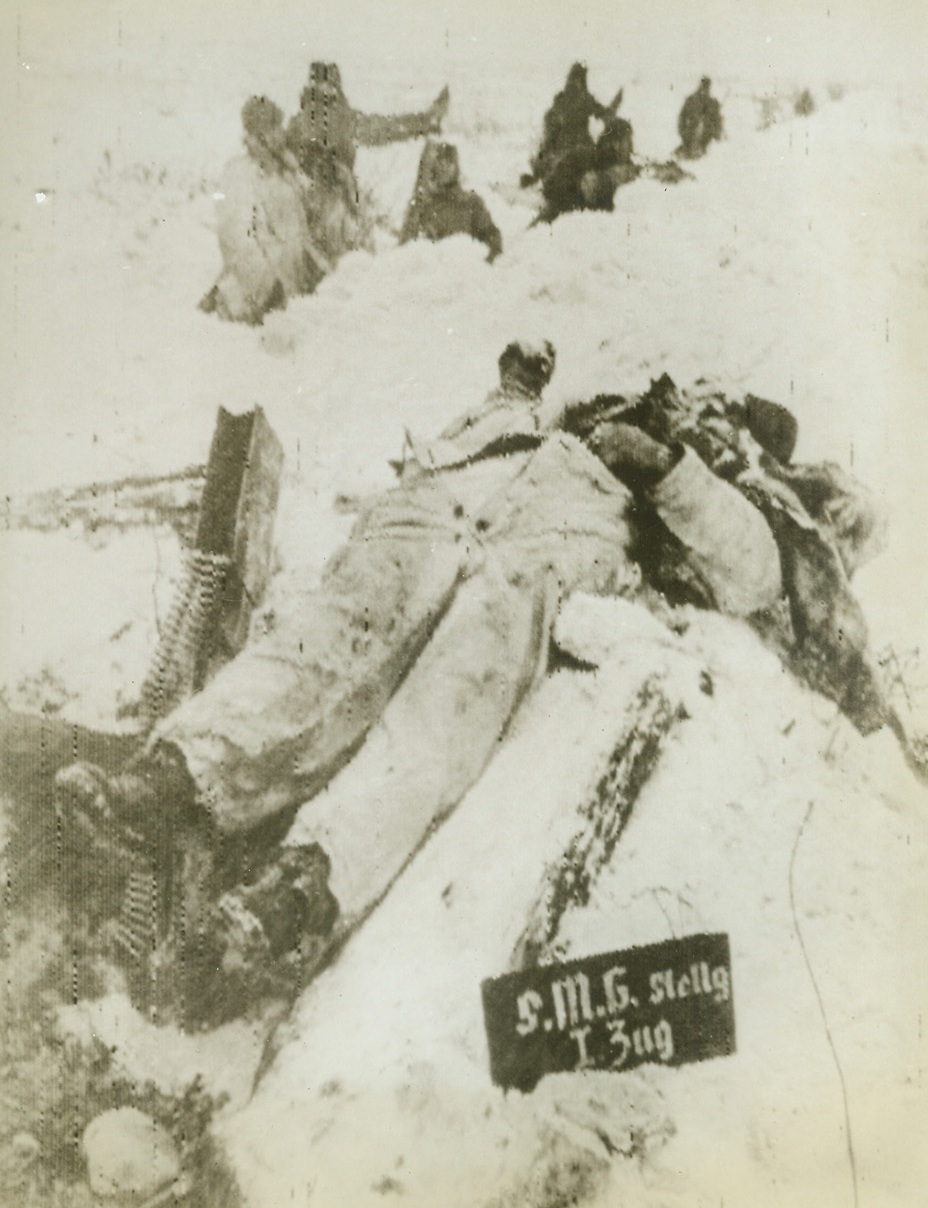
SILENCED FOREVER, 2/5/1943. ON THE RUSSIAN FRONT—This enemy machine gun will never again spit bullets at Red Army men. The Nazi gunner lies on a mound of snow as Red Army machine gunners fire at retreating Germans in the background. Latest reports from the Soviet front indicate that Russian troops, smashing westward in the Caucasus, have split German forces, pinning one body against the sea and pressing another back toward Rostov. Credit: ACME RADIOPHOTO.;
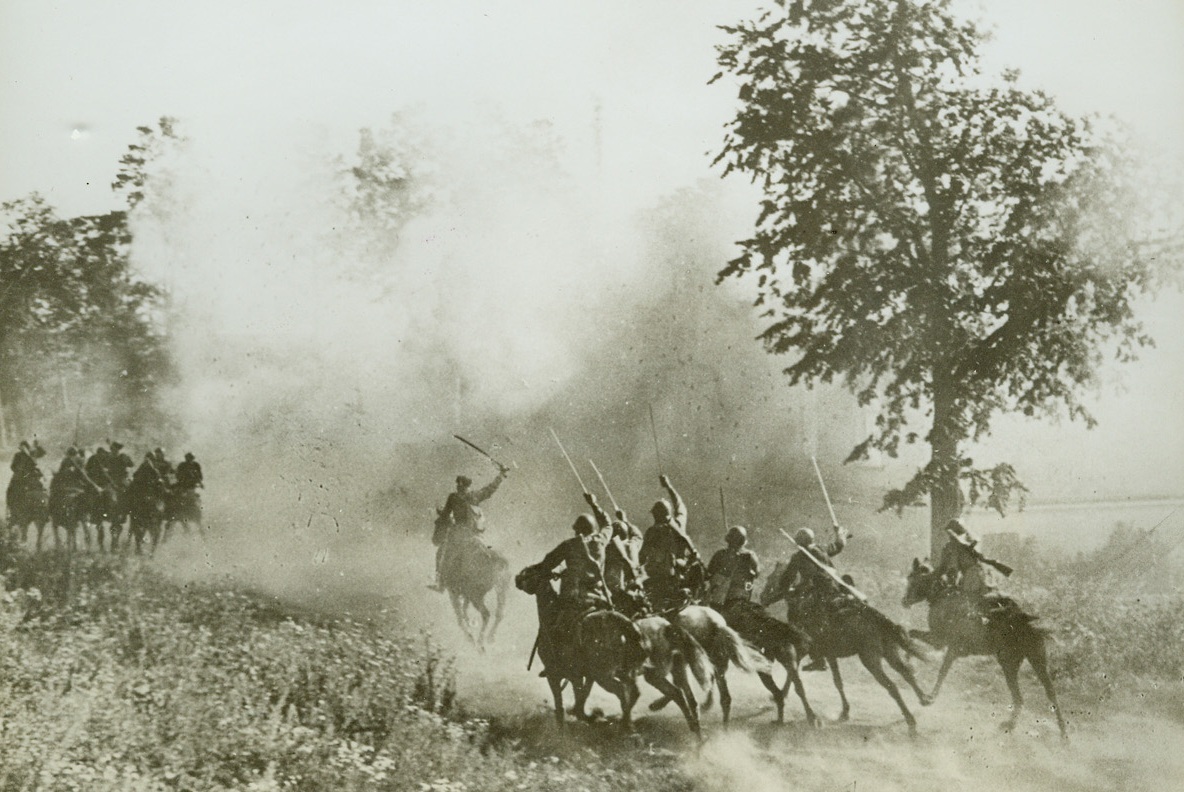
COSSACKS-RUSSIAN’S OLDEST AND FIERCEST, 2/2/1943. SOMEWHERE IN RUSSIA—A unit of Cossacks advance upon a village in the Don valley, occupied by enemy forces. With battle cries of old and weapons of 1943, the famous cavalrymen are among the fiercest of the Red fighters who are turning back the Nazis on all fronts.Credit: ACME.;
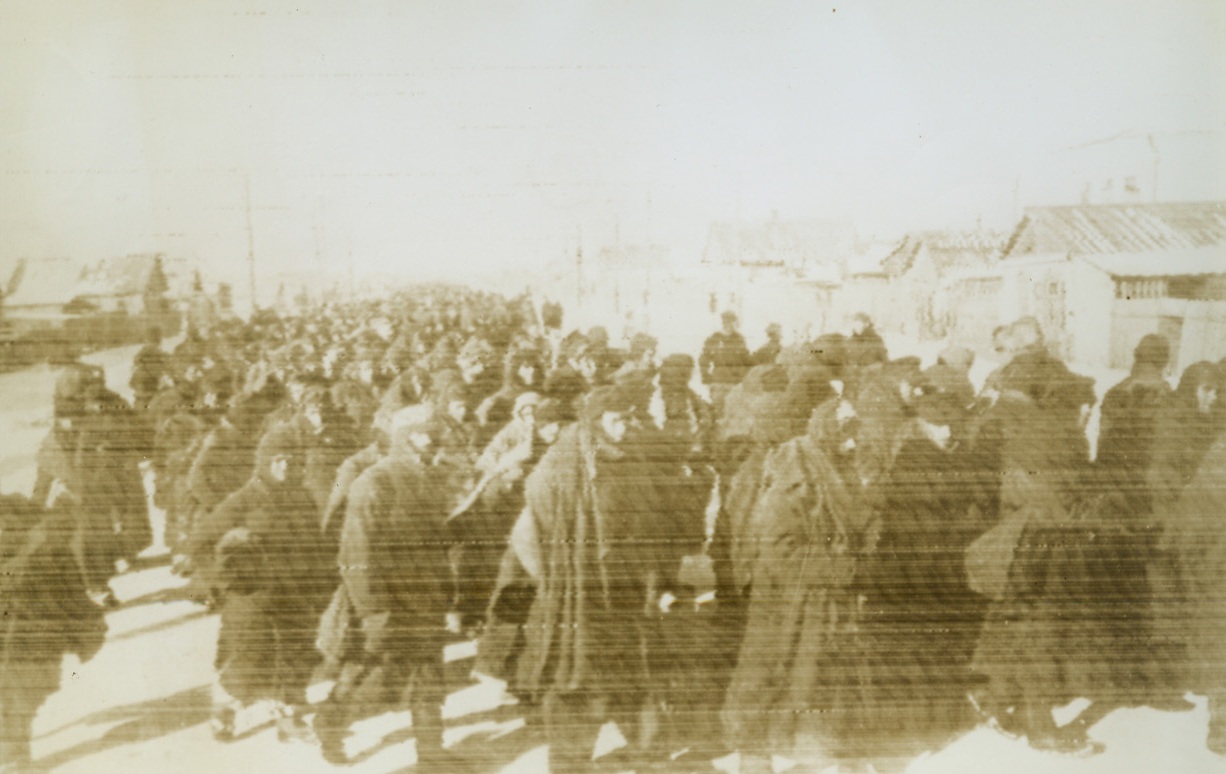
Crowd of Nazi Prisoners, 2/6/1943. Stalingrad, U.S.S.R. – A huge column of German prisoners marches down the street of a village in the Stalingrad area. These are some of the thousands of Nazis who were captured during the final days of the Stalingrad battle of annihilation. Latest reports from the Russian front indicate that Soviet troops are within 15 miles of Rostov. Passed by censors. Credit: ACME Radiophoto;
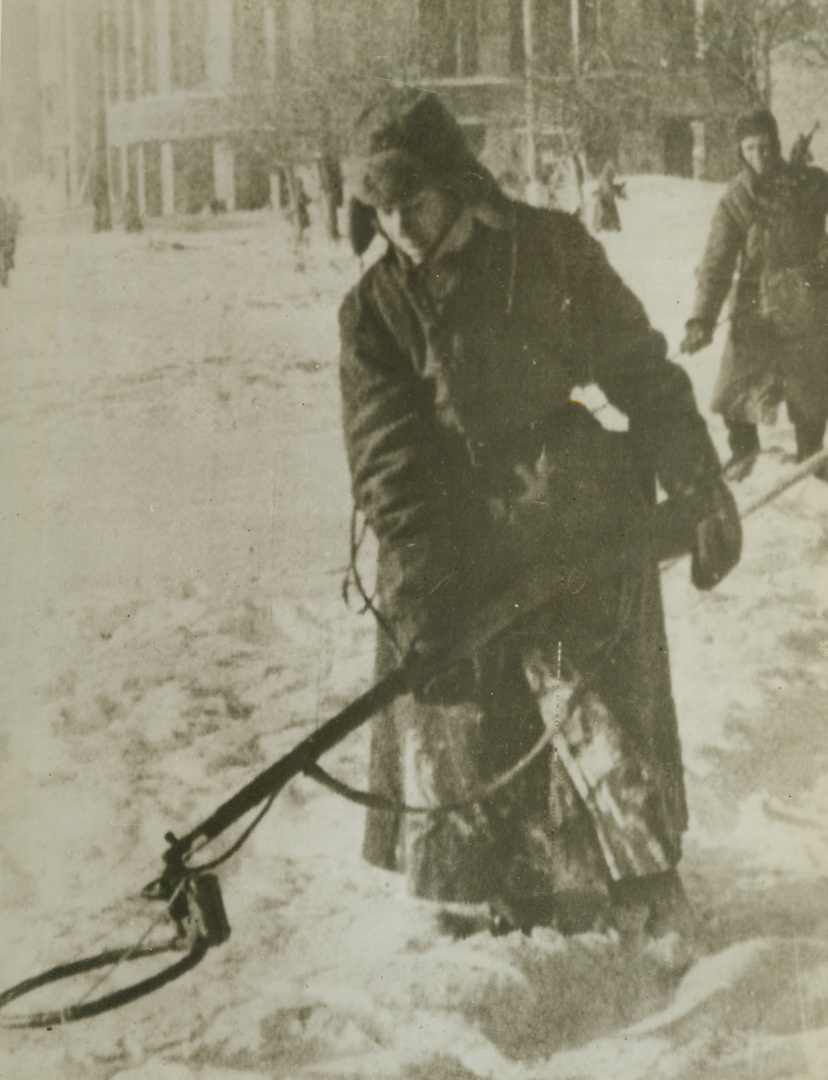
Wary Street Cleaner, 2/19/1943. Voronezh, Russia – A Russian Sapper proceeds cautiously along a street in Voronezh, hunting for Nazi mines buried beneath the snow in the industrial center recaptured by the Reds. Land mines represent a ticklish proposition for the sappers when there is a heavy snow. This one holds his detecting device far from his person. Credit: ACME;
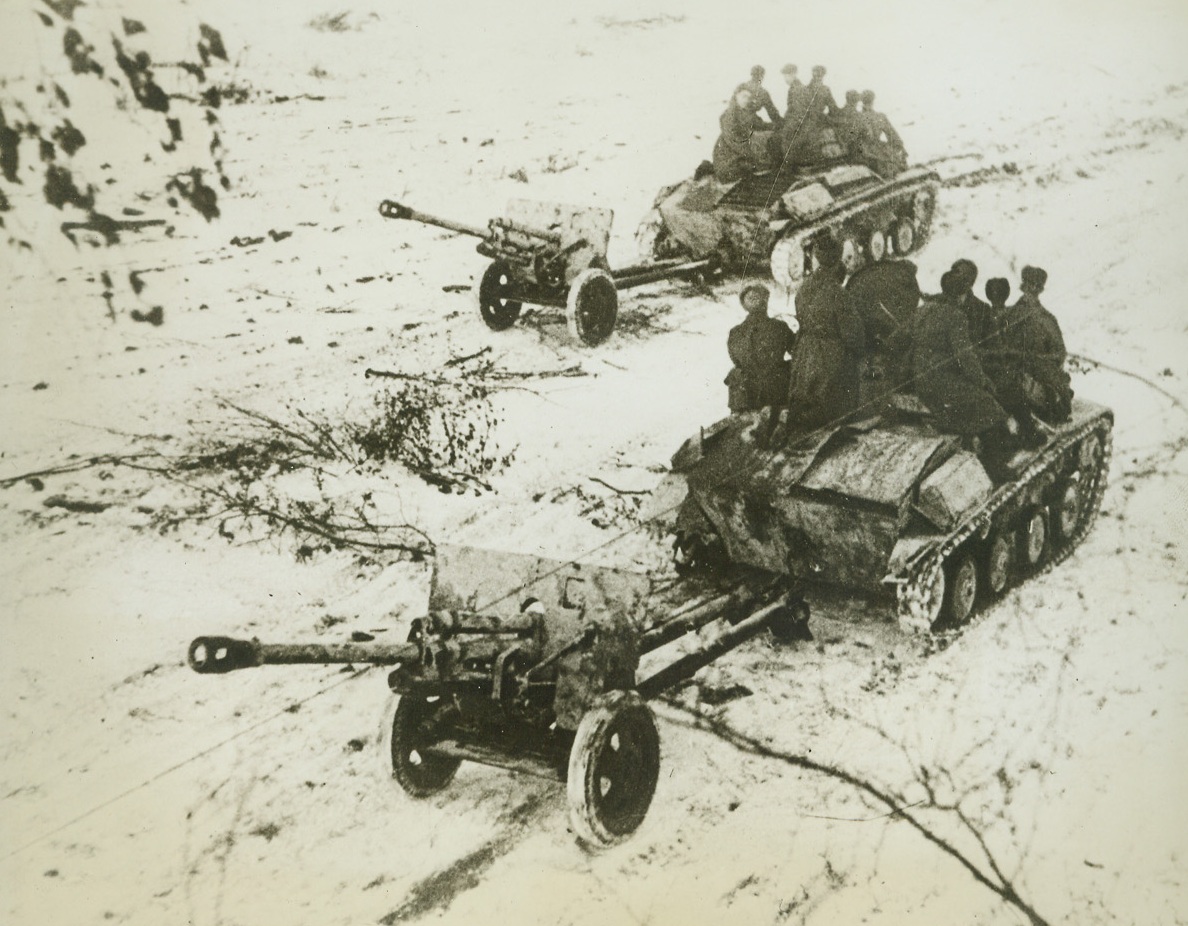
Death Approaches Nazi Tanks, 2/19/1943. Central Front, Russia – Soviet Anti-Tank Guns, accompanying Tanks, move up on the Central Front to reinforce the rapidly advancing Red troops. Even the Russian Infantry is now using “tank tactics” as it virtually rolls over floundering Nazis. Credit: ACME;
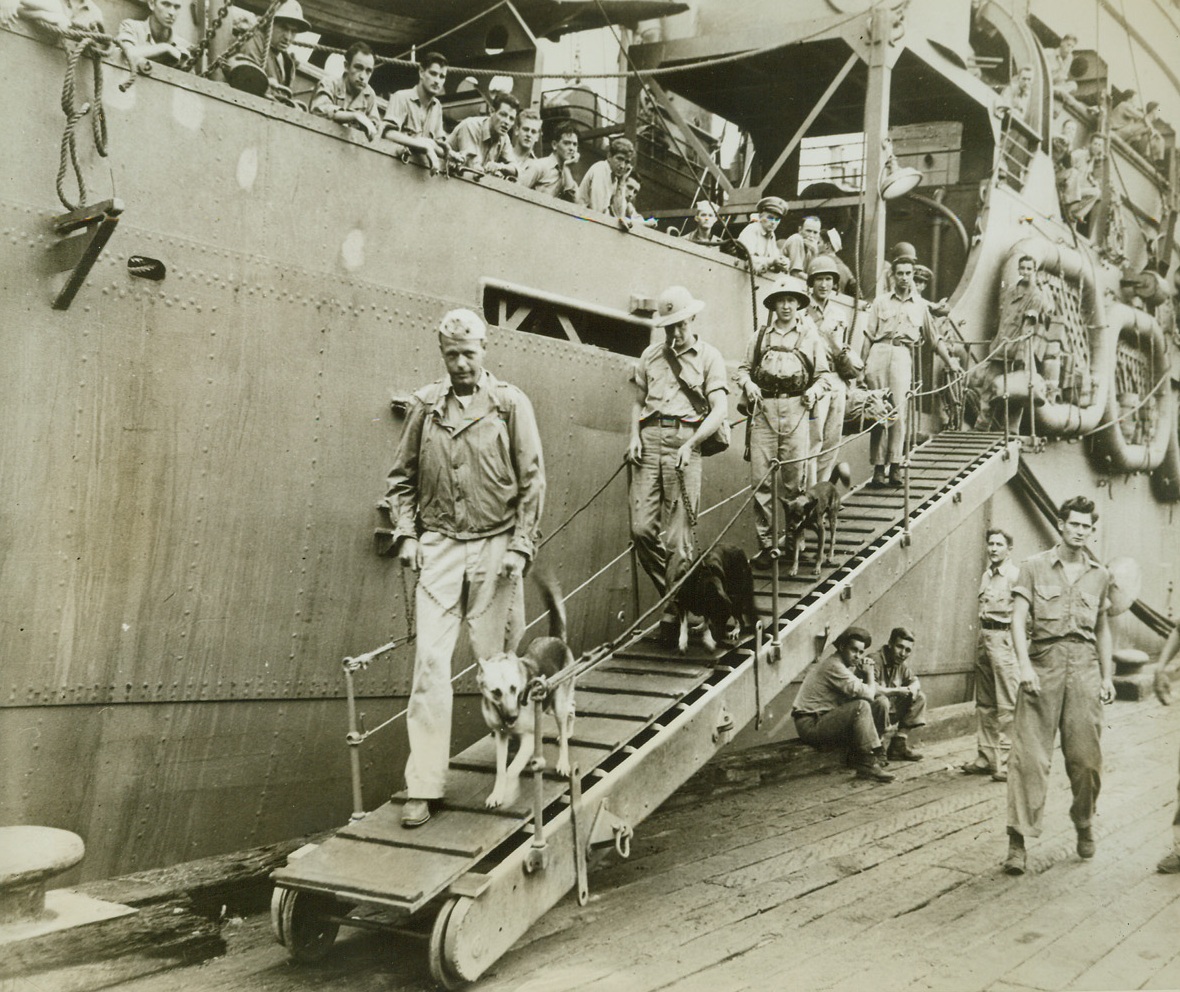
Marines Relieved After Guadalcanal Fighting, 2/13/1943. Weary after months of bitter fighting on Guadalcanal, these U.S. Marines are shown as they arrived at a South Pacific port, heading for a welcome rest. Even the dogs some of the men are leading down the gangplank will get a much needed rest. Credit: Marines Corps photo from ACME;
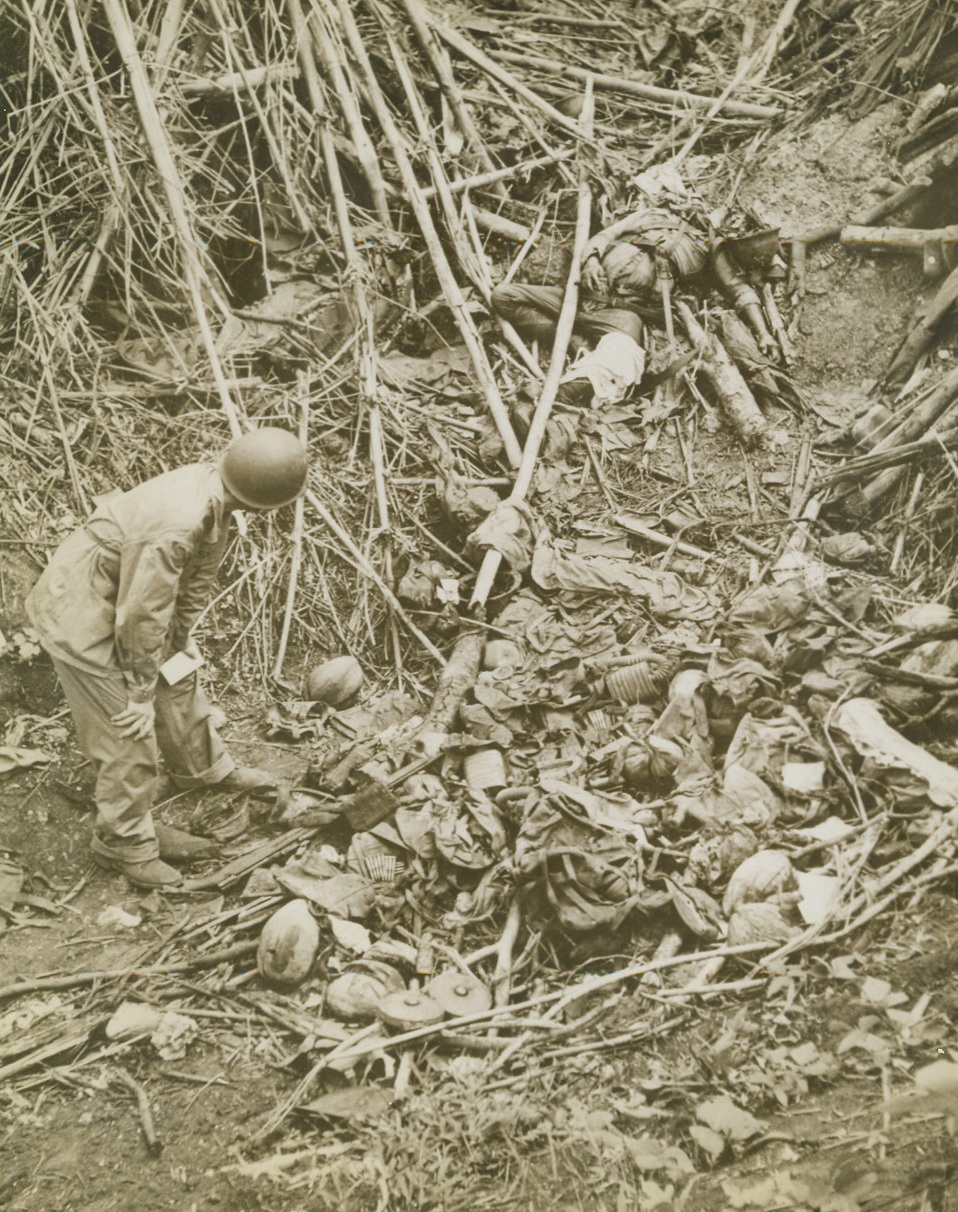
Jap Blasted in Dugout, 2/16/1943. Guadalcanal – A U.S. soldier inspects a blown-up enemy dugout which contains a beheaded Jap (upper right), scattered equipment, and many cocoanut husks which indicate that the Japanese were hard-pressed for food during their last stand on Guadalcanal. The weakened condition of the enemy troops taken prisoner on the island indicate that hunger, as well as American bullets, broke their resistance. Credit: ACME;
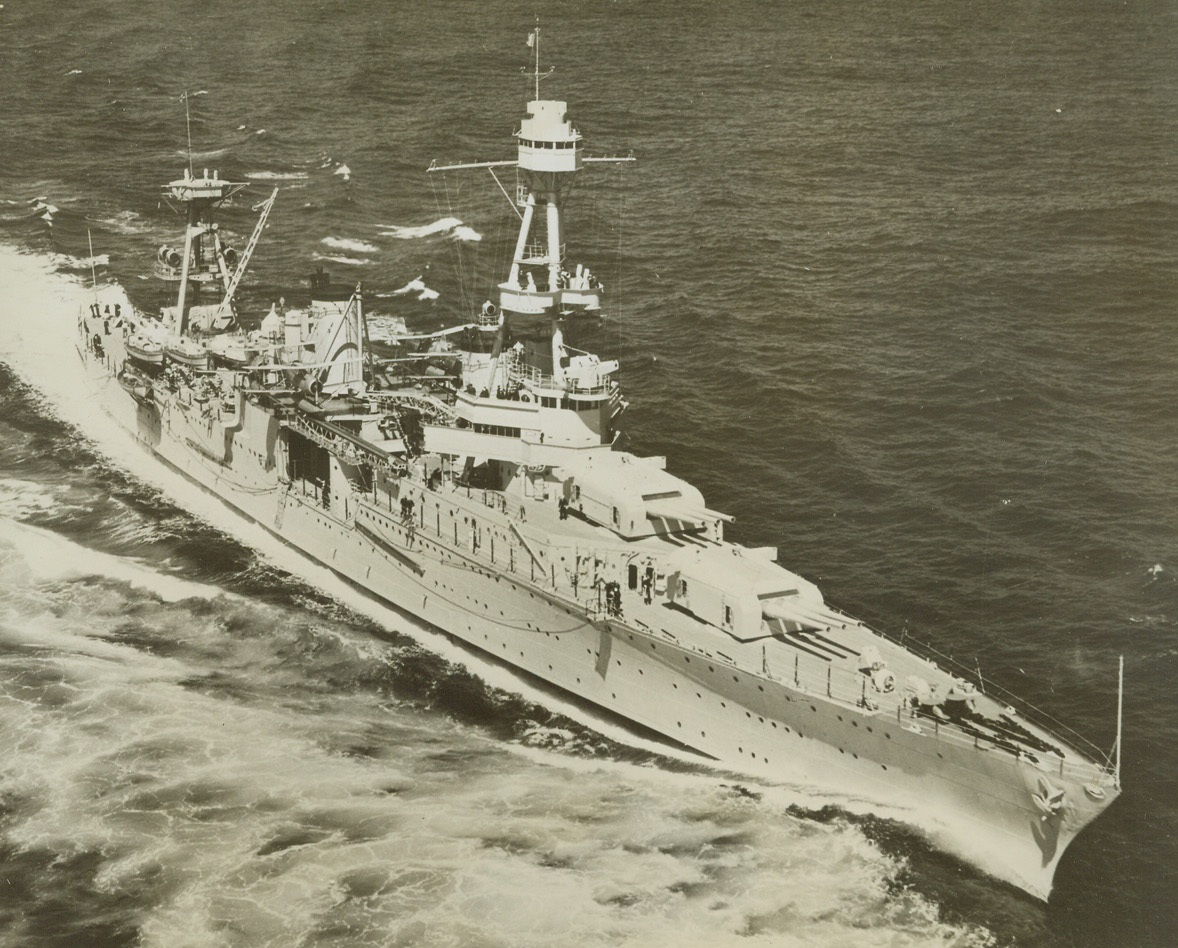
Lost in Solomons Area, 2/16/1943.The heavy cruiser Chicago was lost in a week-long series of air and naval engagements in the Solomons area, according to a Navy announcement. A U.S. destroyer, 22 American planes and three U.S. motor torpedo boats were also lost during the actions resulting from Jap attempts to evacuate men from Guadalcanal and their efforts to interfere with American reinforcements. The sea-air battles covered the period January 29 – February 4, Solomons time, inclusive. Credit line (ACME);
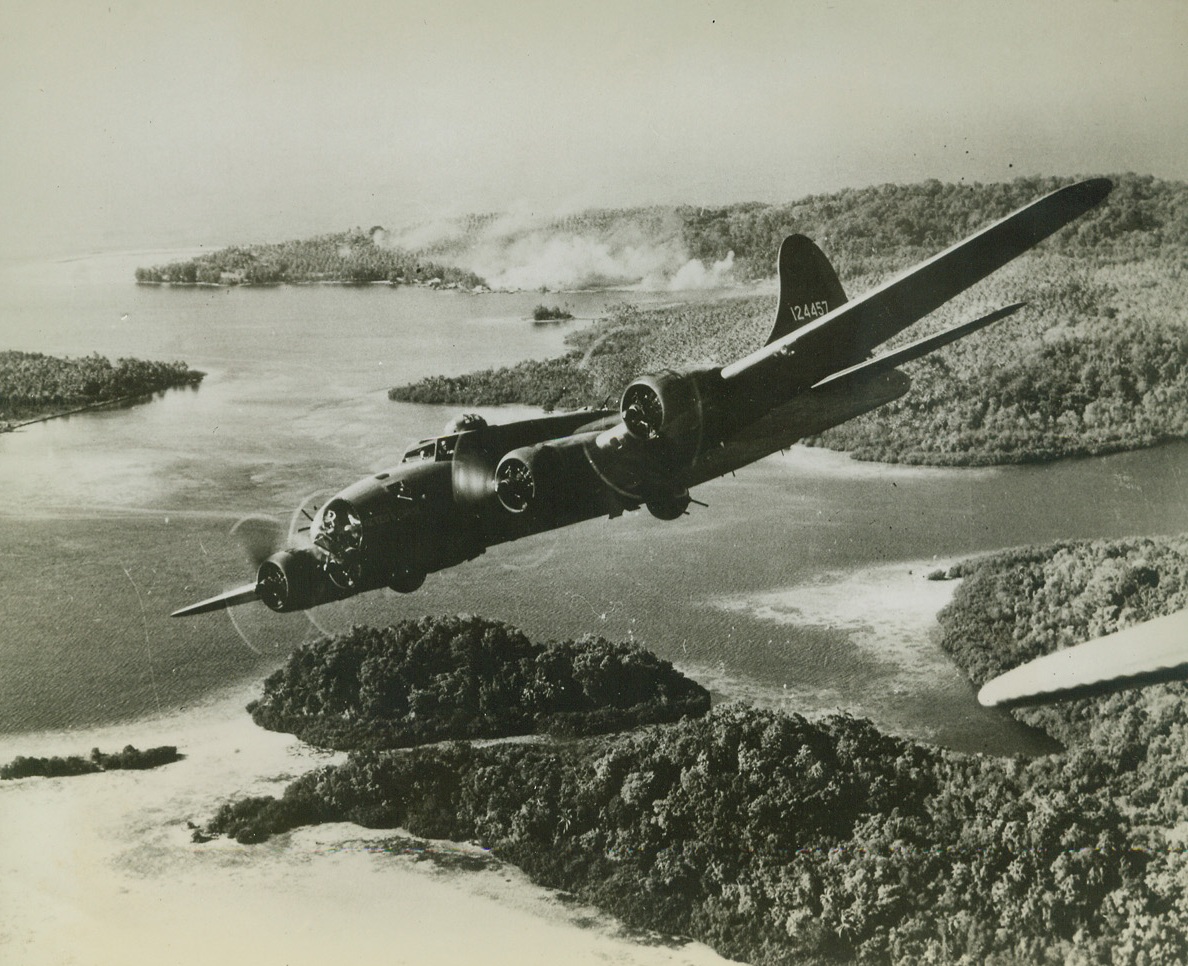
Fortress Foray in Solomons, 2/23/1943. Solomon Islands – After unleashing fire and destruction on Jap installations on Gizo island (right rear), a U.S. Flying fortress wings back toward its home base with other four-motored champions of the sky. The raid was part of a triple-pronged aerial thrust against the enemy during the fight for Guadalcanal. Credit (Official U.S. Navy photo –ACME);
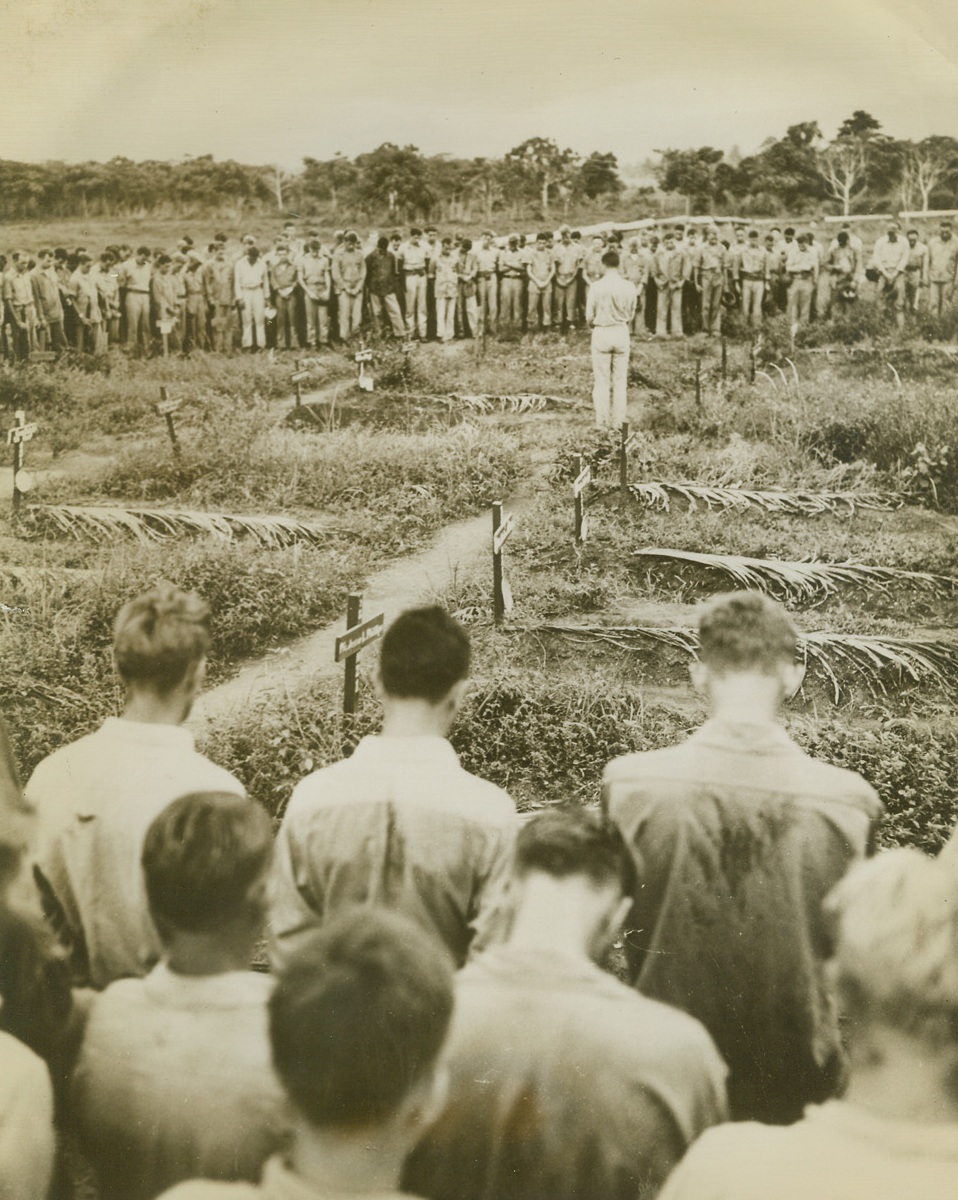
Pay Homage to Departed Comrades, 2/2/1943. Guadalcanal: - With heads bowed, American soldiers stationed on Guadalcanal, in the Solomon islands, pay their last respects to buddies who were victims of the Japs. A cross and palm leaf mark the resting places of the fallen men. Credit line (ACME);

Line Up for Attack, 2/14/1943. Tunisia – Seen from the waist gunner’s position in a sister plane, this bomber prepares to line up, wing to wing, with other flying fortresses participating in an attack on the Tunisian front, early this year. Nineteen German fighters were downed in the resulting sortie – the biggest air battle of the Tunisian front to date. Latest reports from Tunisia indicate that the British 8th Army has blasted Rommel out of his first defense line in South Tunisia. Credit line is not visible.;
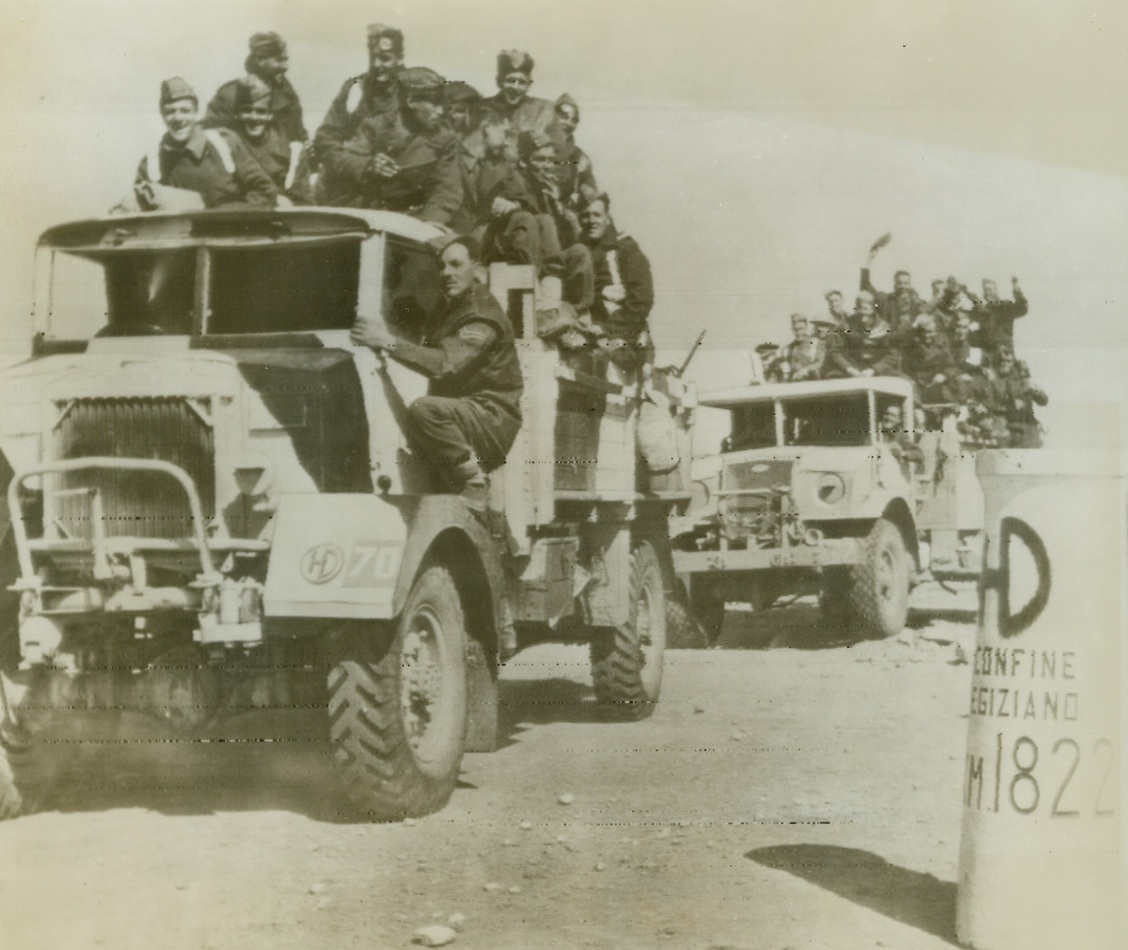
Leaving Their Tank, 2/17/1943. Tripolitania – Crossing the border between Tripolitania and Tunisia, truckloads of men of the highland division pass a signpost at the border that already bears the “HD” that identifies the highland division. Latest reports received from Tunisia indicate that veteran German tank forces, renewing their powerful drive in South Tunisia, have smashed through to the outskirts of Sbeitla. Credit line (ACME radio photo);
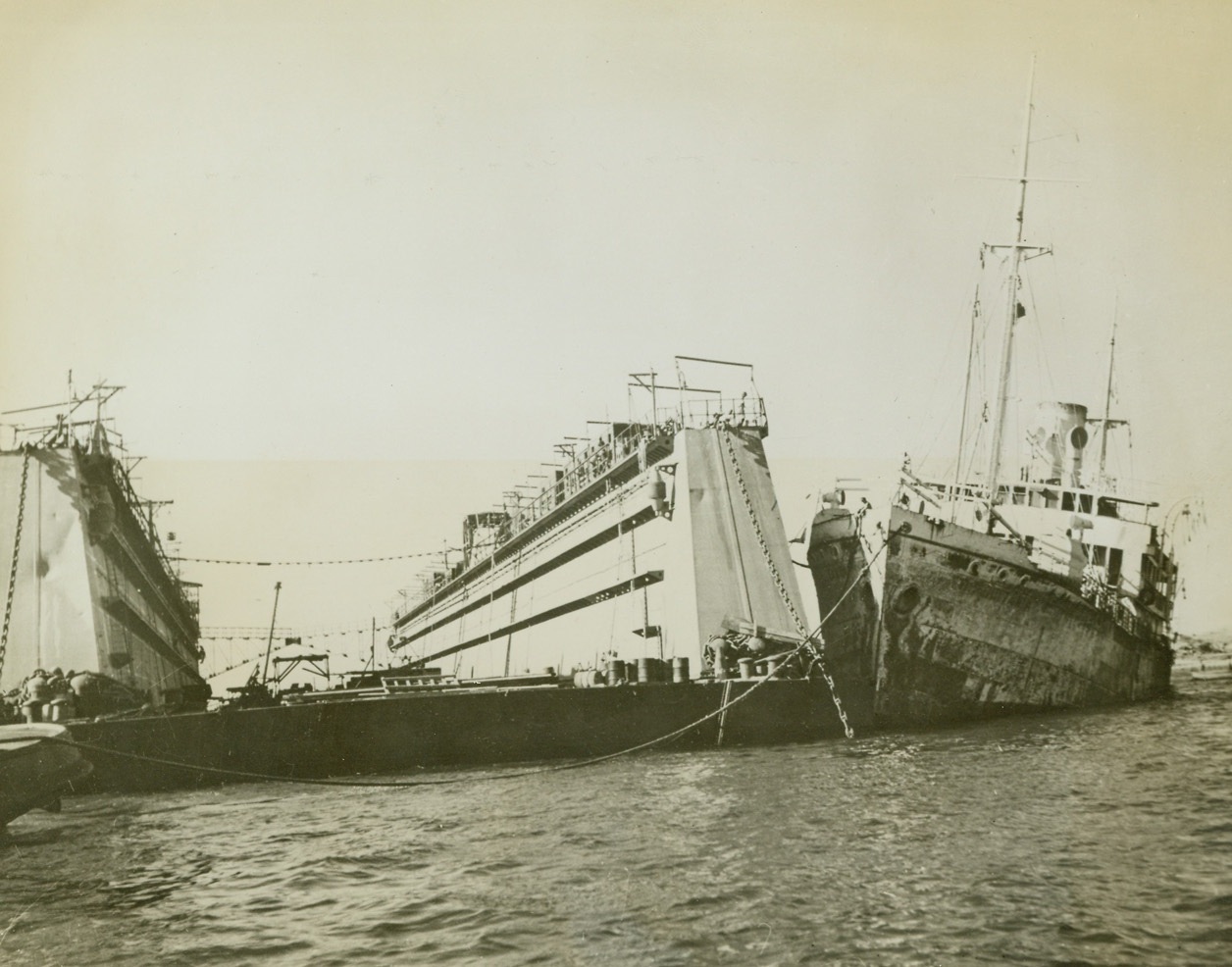
They Didn’t Think He’d Do It – But He Did!, 2/18/1943. Massaua, Eritrea – The British laughed when Captain Edward Ellsberg, famed submarine salvage expert, announced that he was going to raise the sunken drydock in Massaua harbor, scuttled by the Italians before the British took over. “Impossible – You’ll never do it,” they said. “Wanna bet?” the Captain calmly asked. The laughed again. “Put up or shut up,” the Captain said. The British did “put u” – to the tune of $2,000. Making a collection among Americans stationed at the harbor, Captain Ellsberg matched the sum and got to work. Today the drydock stands, good as new, in the harbor of Massaua – A miracle of salvage. Scuttled German and Italian ships, pulled up from the Red Sea, are rejuvenated there and pressed into United Nations service allied ships will also use the drydock as a repair station. And the Americans who backed Captain Ellsberg doubled their stakes in the venture. The following series shows American salvage chews operating in the harbor at Massaua. New York Bureau Scuttled by the Italians before they gave up the harbor, this ship is being placed in drydock after being raised from the sea by American salvage crews. Credit line (ACME);
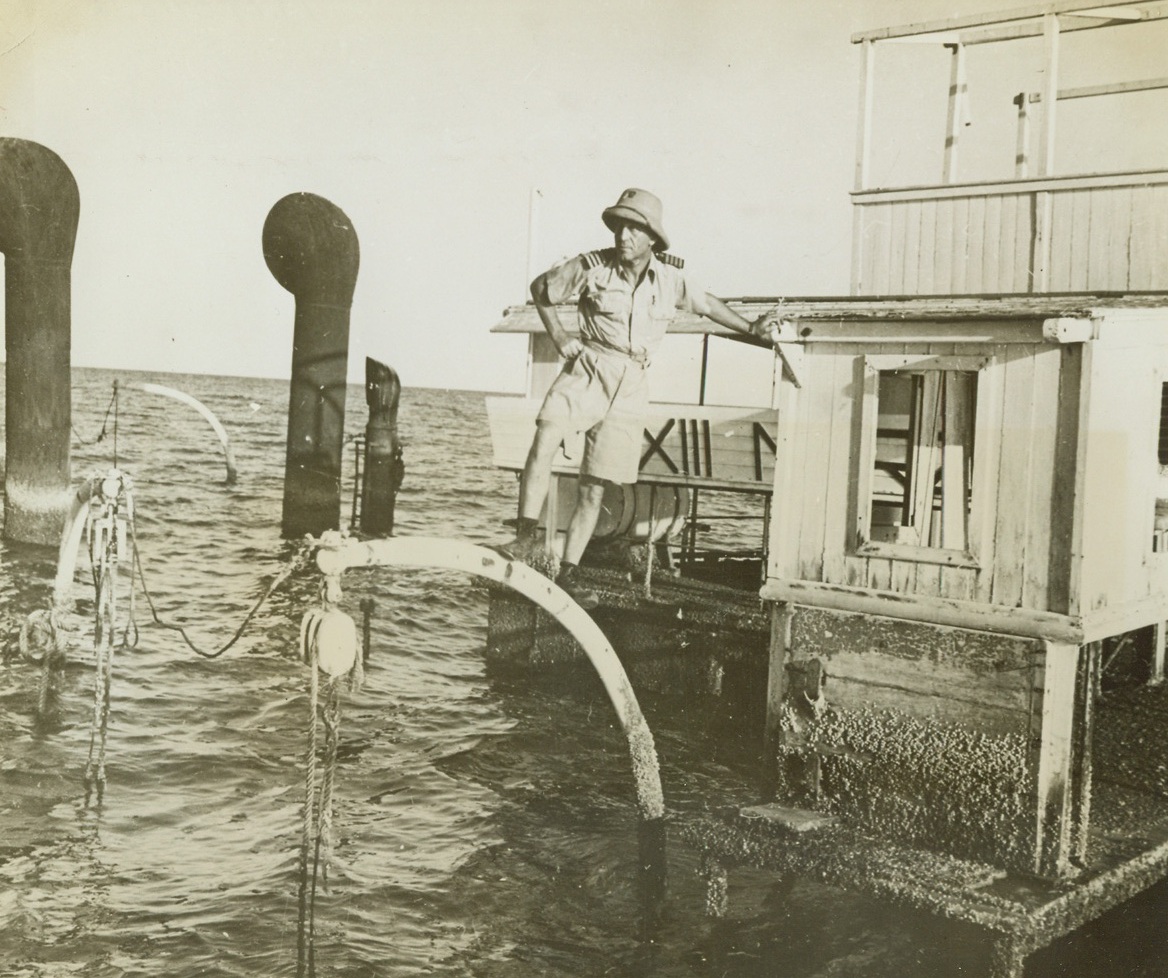
They Didn’t Think He’d Do It – But He Did!, 2/18/1943. Massaua, Eritrea - The British laughed when Captain Edward Ellsberg, famed submarine salvage expert, announced that he was going to raise the sunken drydock in Massaua harbor, scuttled by the Italians before the British took over. “Impossible – You’ll never do it,” they said. “Wanna bet?” the Captain calmly asked. The laughed again. “Put up or shut up,” the Captain said. The British did “put u” – to the tune of $2,000. Making a collection among Americans stationed at the harbor, Captain Ellsberg matched the sum and got to work. Today the drydock stands, good as new, in the harbor of Massaua – A miracle of salvage. Scuttled German and Italian ships, pulled up from the Red Sea, are rejuvenated there and pressed into United Nations service allied ships will also use the drydock as a repair station. And the Americans who backed Captain Ellsberg doubled their stakes in the venture. The following series shows American salvage chews operating in the harbor at Massaua. New York Bureau Jutting out into the water, those ventilators are a challenge to Captain Edward Ellsberg, who stands on the davit of the sunken axis ship that he’ll soon raise from the bottom. Credit line (ACME);
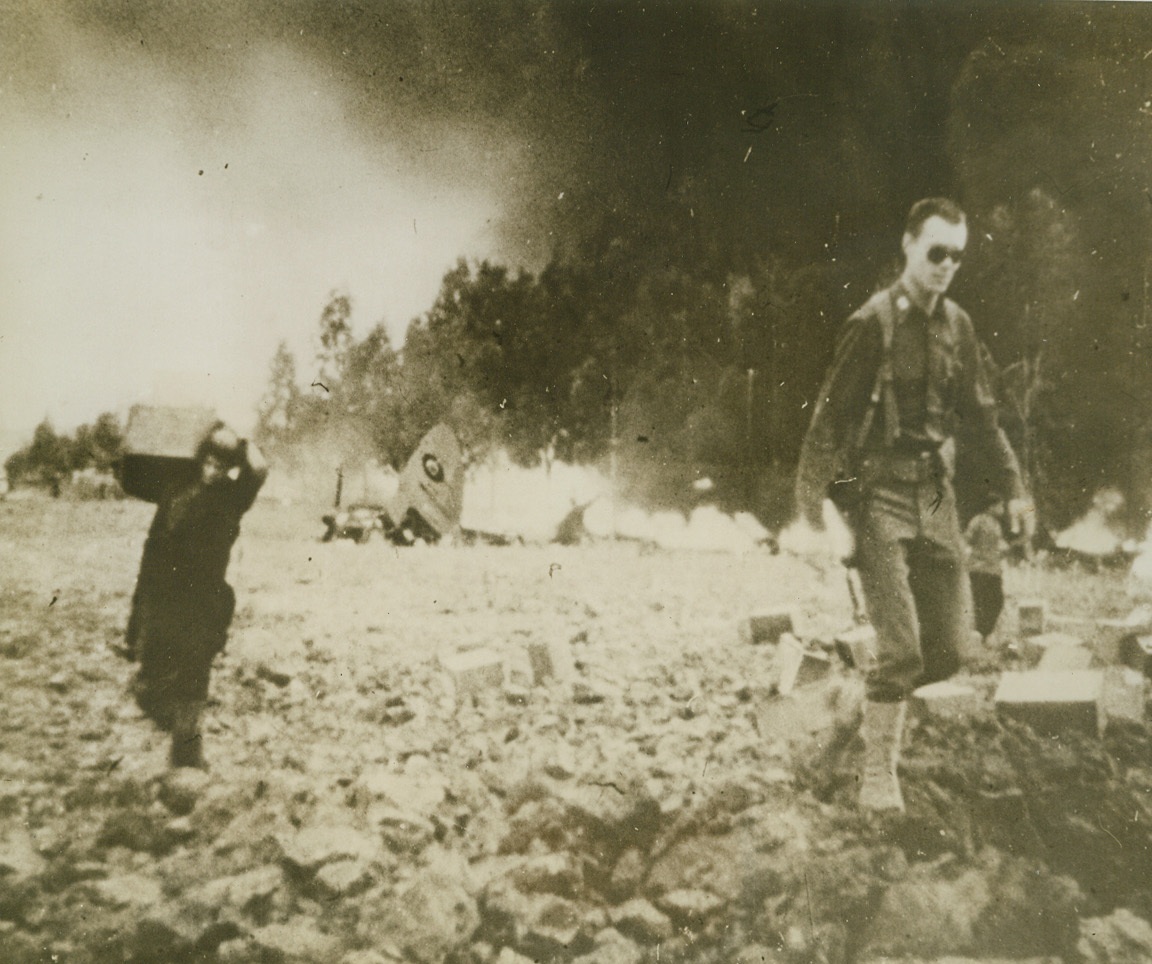
Nazis Blast Allied Air Base, 2/16/1943. Souk El Arba – Allied soldiers rush valuable supplies from the scene of Nazi bomb hits at Souk El Arba, the air base captured by allied paratroops a few days before the attack. An allied plane flames in the background. As American interceptors engaged the raiders, munitions were removed from flaming areas, and wounded and shell-shocked soldiers and civilians received emergency treatment on the field of battle. The bombs hit gas and oil supplies as well as munitions dumps at the airfield but the axis, too, lost fairly heavily. The morning following the attack, unescorted DC-3 transports brought replacement supplies and munitions to carry on the Tunisian attack.Credit (U.S. Army Signal Corps film - - ACME);
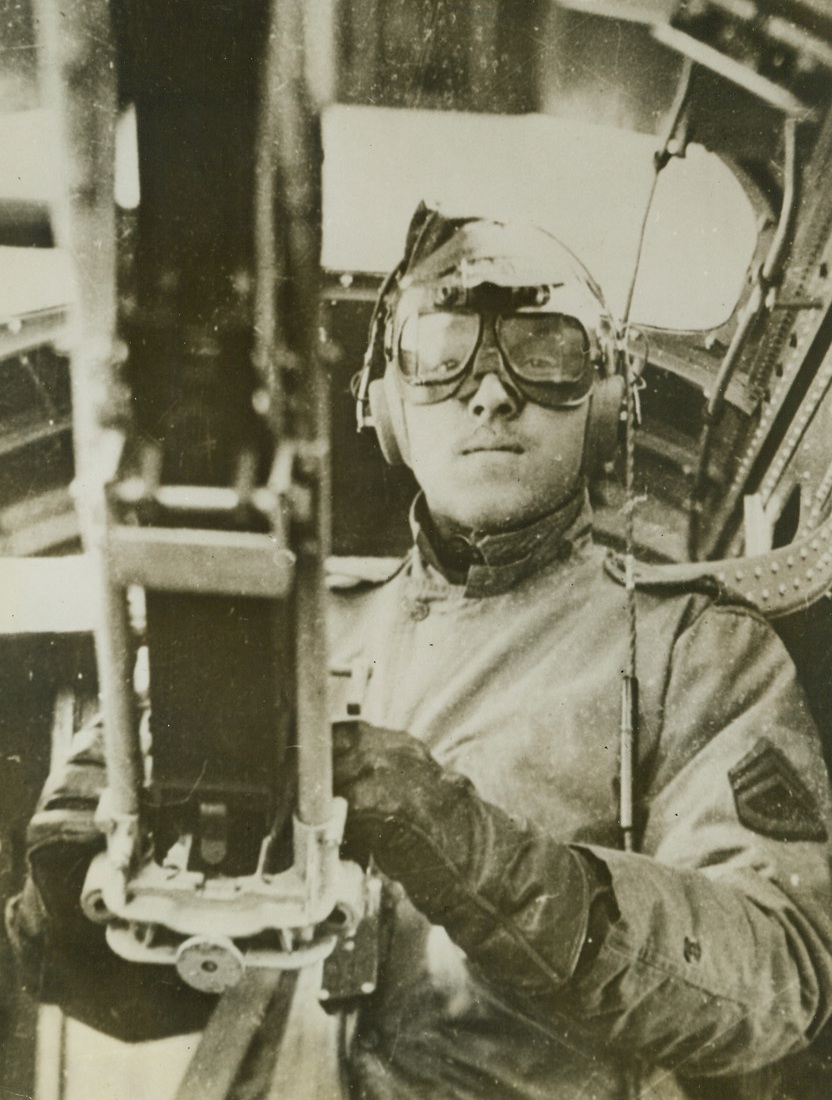
Time Out, 2/14/1943. Tunisia – With his hands still on his gun, Radio gunner William J. Garrett of Youngstown, Ohio, rests as enemy fighters attacking his fortress fall back during an allied raid on Tunisia - - the biggest air battle in that area to date – held early this year. Recent dispatches from Tunisia indicate that Rommel’s forces have been blasted out of their first line of defense in South Tunisia.Credit line (ACME);
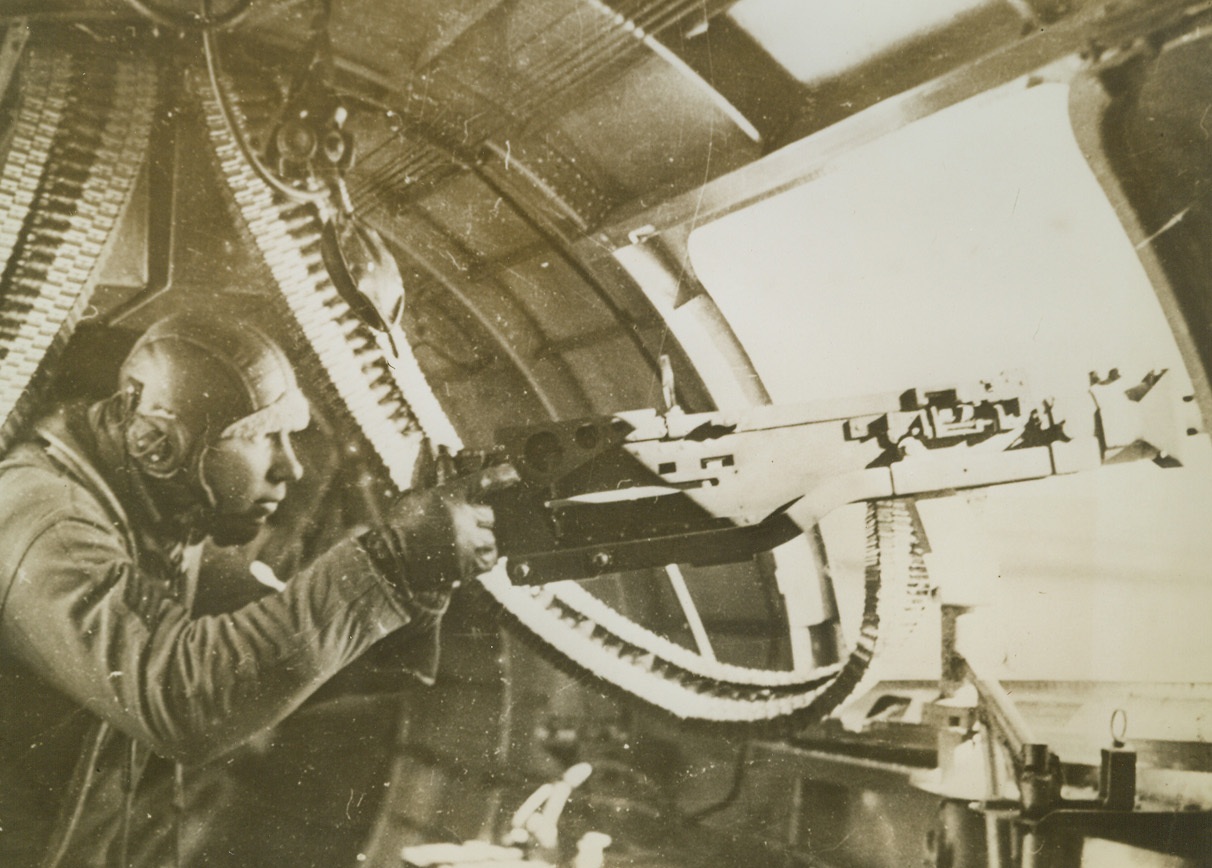
Gunner In Action, 2/14/1943. Tunisia – Waist gunner Robert L. Doremus of Henrietta, Okla., goes into action as enemy fighters approach to attack his fortress. The 20-year-old gunner was the hero of the operation during which photo was made – the biggest air battle over Tunisia to date. Gunner Doremus’ guns were going all the time, and 19 enemy fighters were sent down during the battle. Latest reports received from Tunisia indicate that the British 8th Army has blasted Rommel out of his first line of defense in South Tunisia.Credit line (ACME);
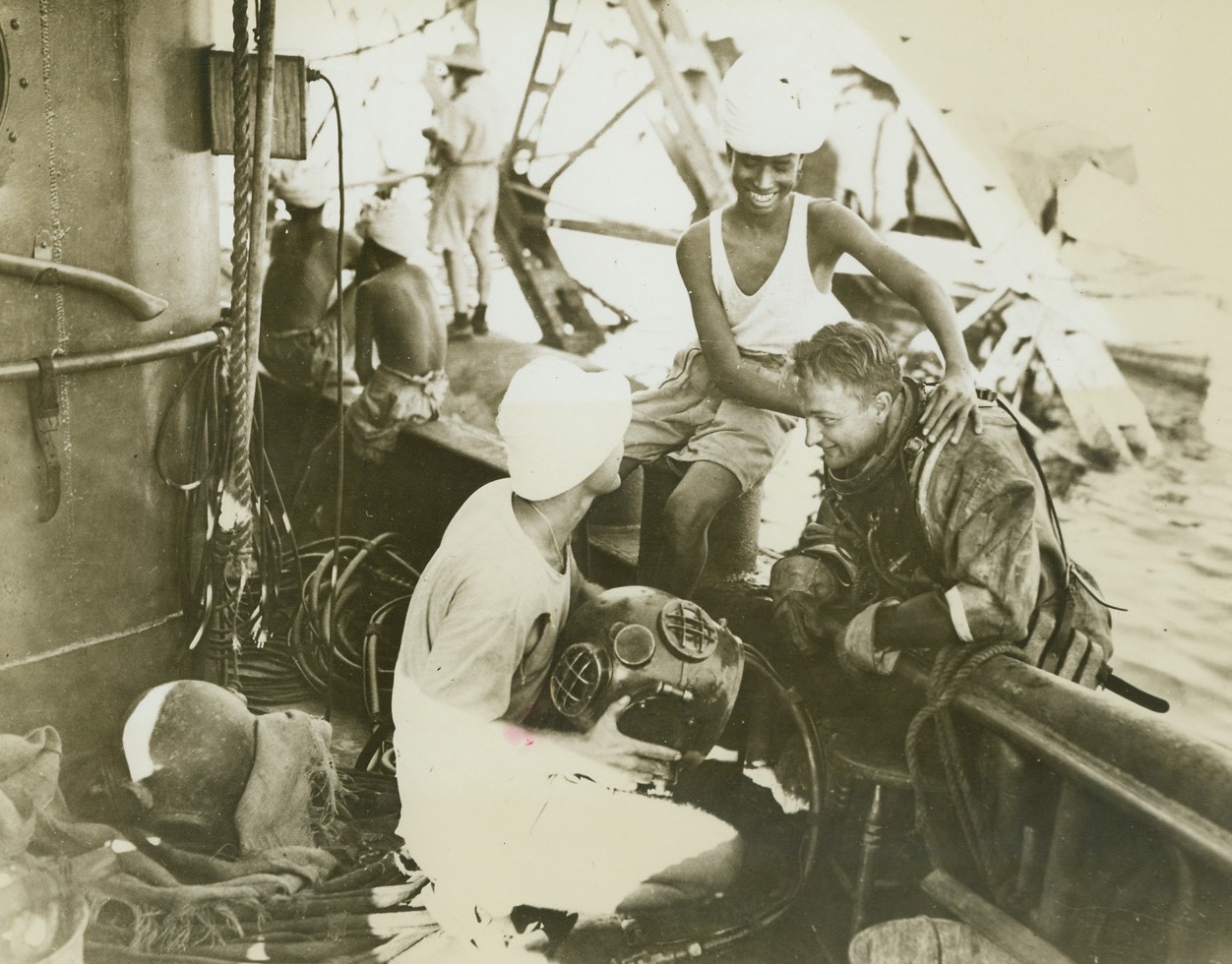
They Didn’t Think He’d Do It – But He Did!, 2/18/1943. Massaua, Eritrea – The British laughed when Captain Edward Ellsberg, famed submarine salvage expert, announced that he was going to raise the sunken drydock in Massaua harbor, scuttled by the Italians before the British took over. “Impossible – You’ll never do it,” they said. “Wanna bet?” the Captain calmly asked. The laughed again. “Put up or shut up,” the Captain said. The British did “put u” – to the tune of $2,000. Making a collection among Americans stationed at the harbor, Captain Ellsberg matched the sum and got to work. Today the drydock stands, good as new, in the harbor of Massaua – A miracle of salvage. Scuttled German and Italian ships, pulled up from the Red Sea, are rejuvenated there and pressed into United Nations service allied ships will also use the drydock as a repair station. And the Americans who backed Captain Ellsberg doubled their stakes in the venture. The following series shows American salvage chews operating in the harbor at Massaua.New York BureauRobert Koegler (left) and “Ali”, a native boy, greet diver Ervin Johnson of Chicago as he comes up from his dangerous work removing unexploded demolition bombs from the sunken craft.Credit line (ACME);
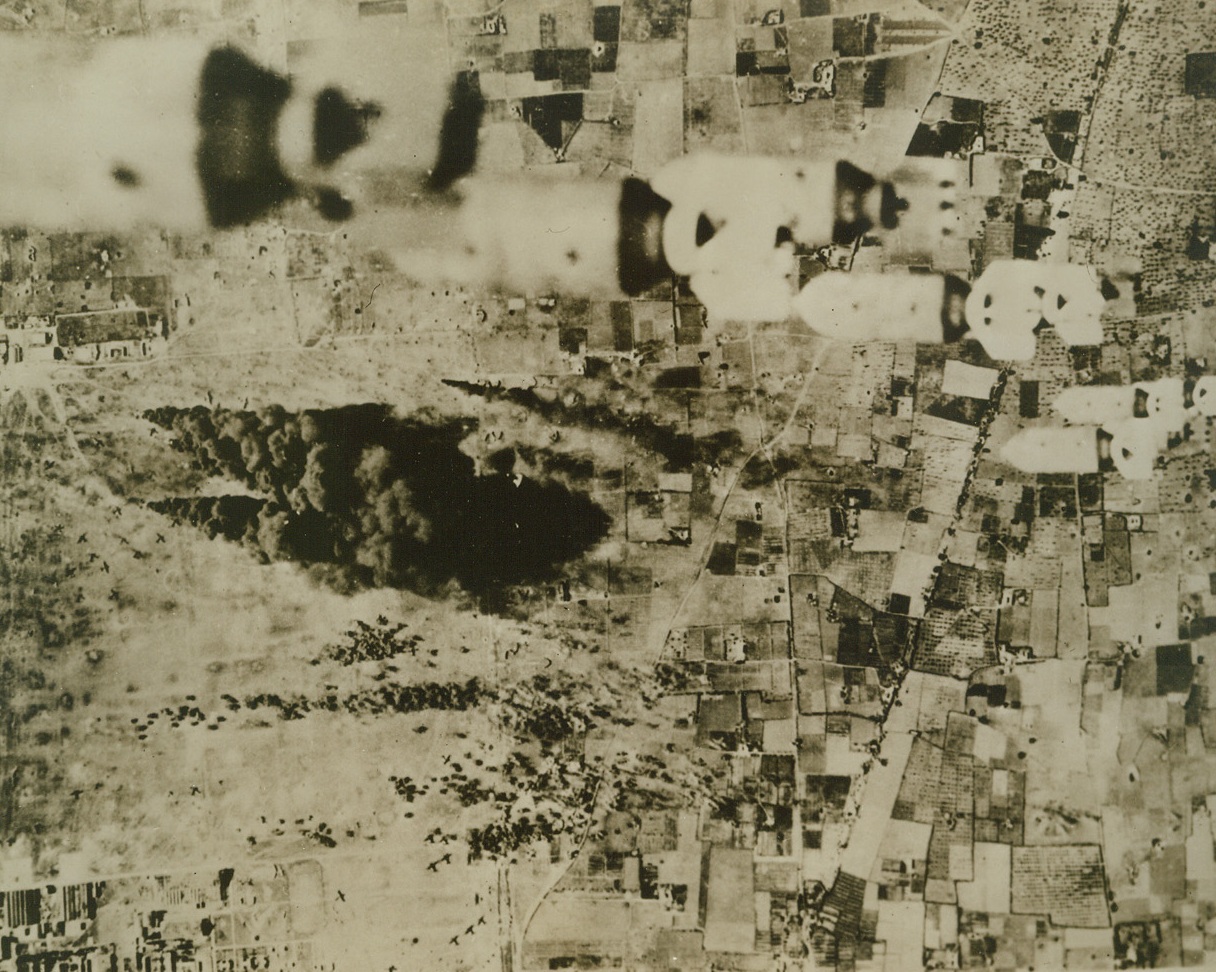
U.S. Planes Bomb Airport Near Tunisia, 2/24/1943. In this photo which has just reached the U.S., powerful bombs are shown as they dropped from a flying fortress of the United States Army Air Forces, towards the axis-held airport at El Auina, near Tunisia. Columns of black smoke mark spots on the field where bombs from other American aircraft caused fires among the axis fighters and transport planes, during the recent surprise raid. Note other axis aircraft standing on air field (lower center of photo).Credit line (ACME);
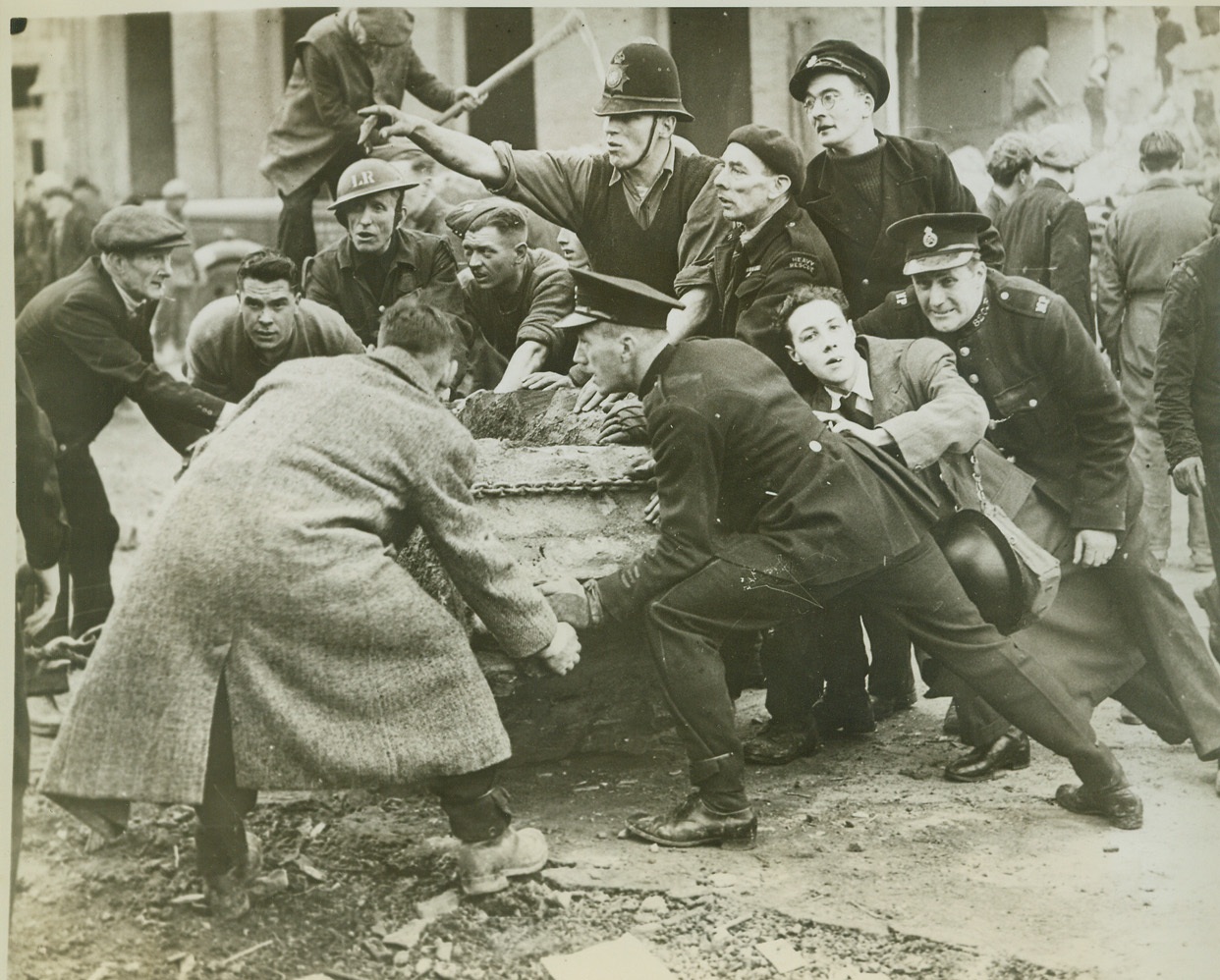
When Nazi Bombs Hit School, 2/5/1943. LONDON, ENGLAND -- Policemen, Civil Defense Workers, soldiers and civilians join in the search for survivors amid the debris of a London school bombed by the Nazis last month (January, 1943). Forty-two children and six teachers were killed and many others were injured when bombs fell on the school during a daylight raid in which many Nazi raiders flew at almost roof-top level to bomb and machine-gun the streets. Credit: (ACME);
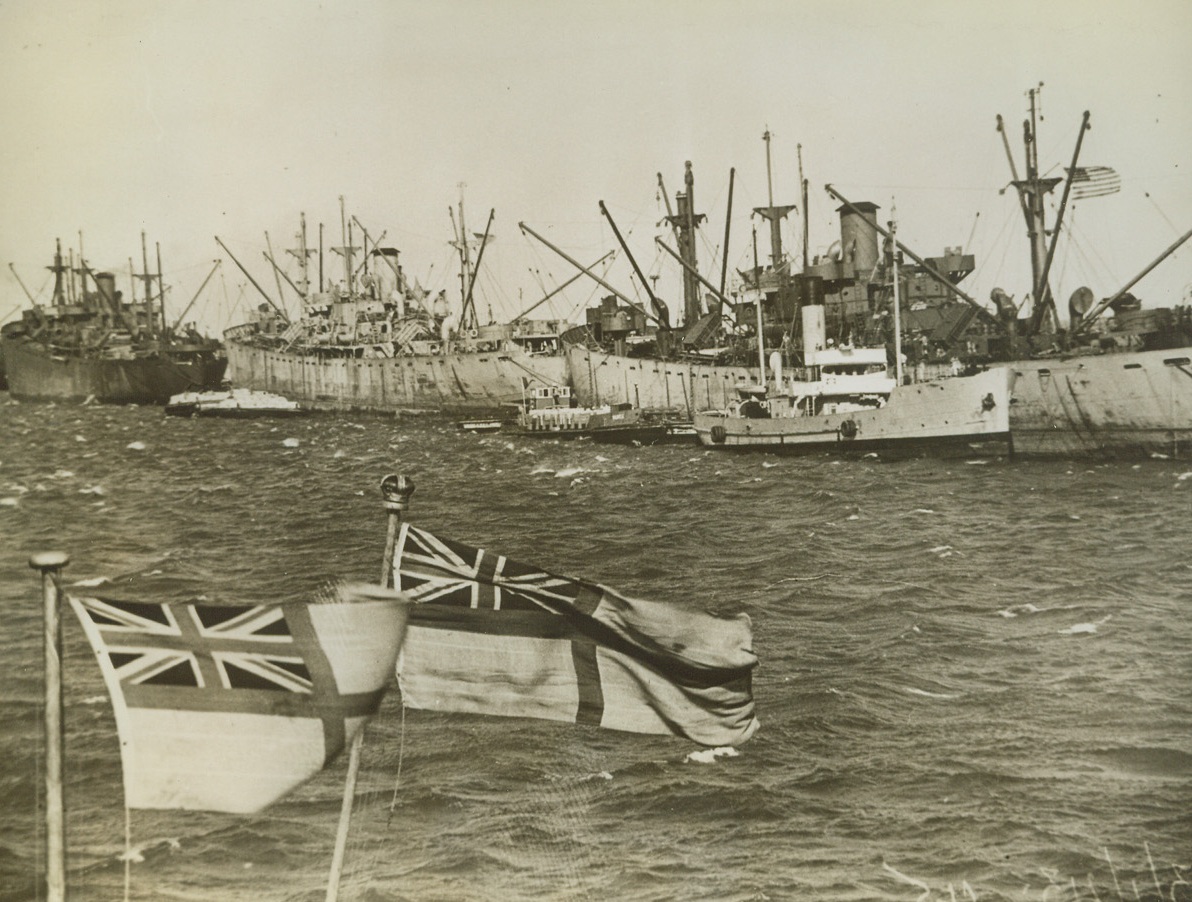
Liberty Ships Supply North African Forces, 2/13/1943. North Africa—A group of American “Liberty Ships” are pictured unloading at a North African port. In the foreground are the flags of two British destroyers. Credit: ACME.;
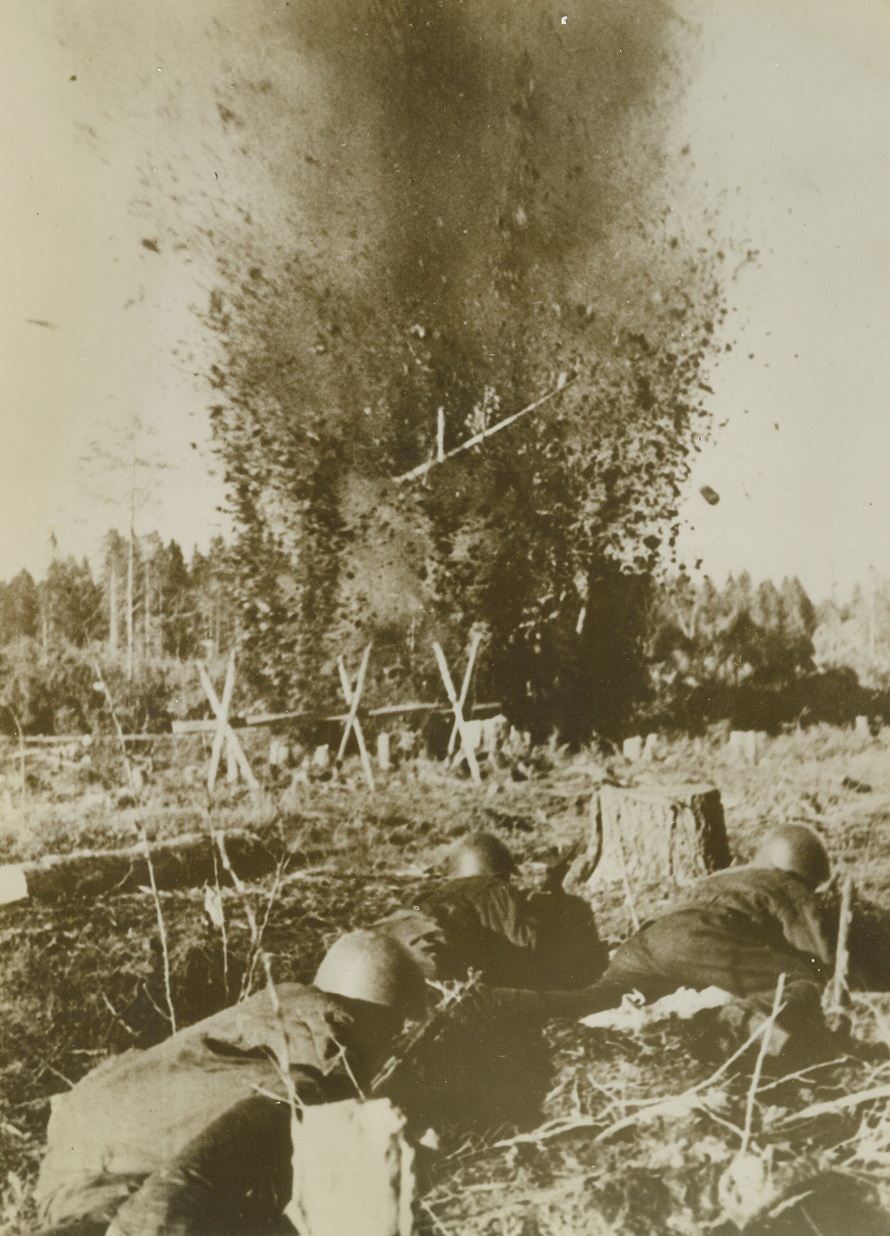
Red Sappers Prepare the Way, 2/1/1943. Southern Russian Front—An explosive charge, set by Russian sappers, (foreground), goes off making a hole in Nazi barbed-wire defenses, clearing the way for a Red advance. Along almost the entire Russian front, Nazis are being pushed back. This photo, just received in New York, was taken recently on the southern front. (Passed by censors). Credit: ACME.;
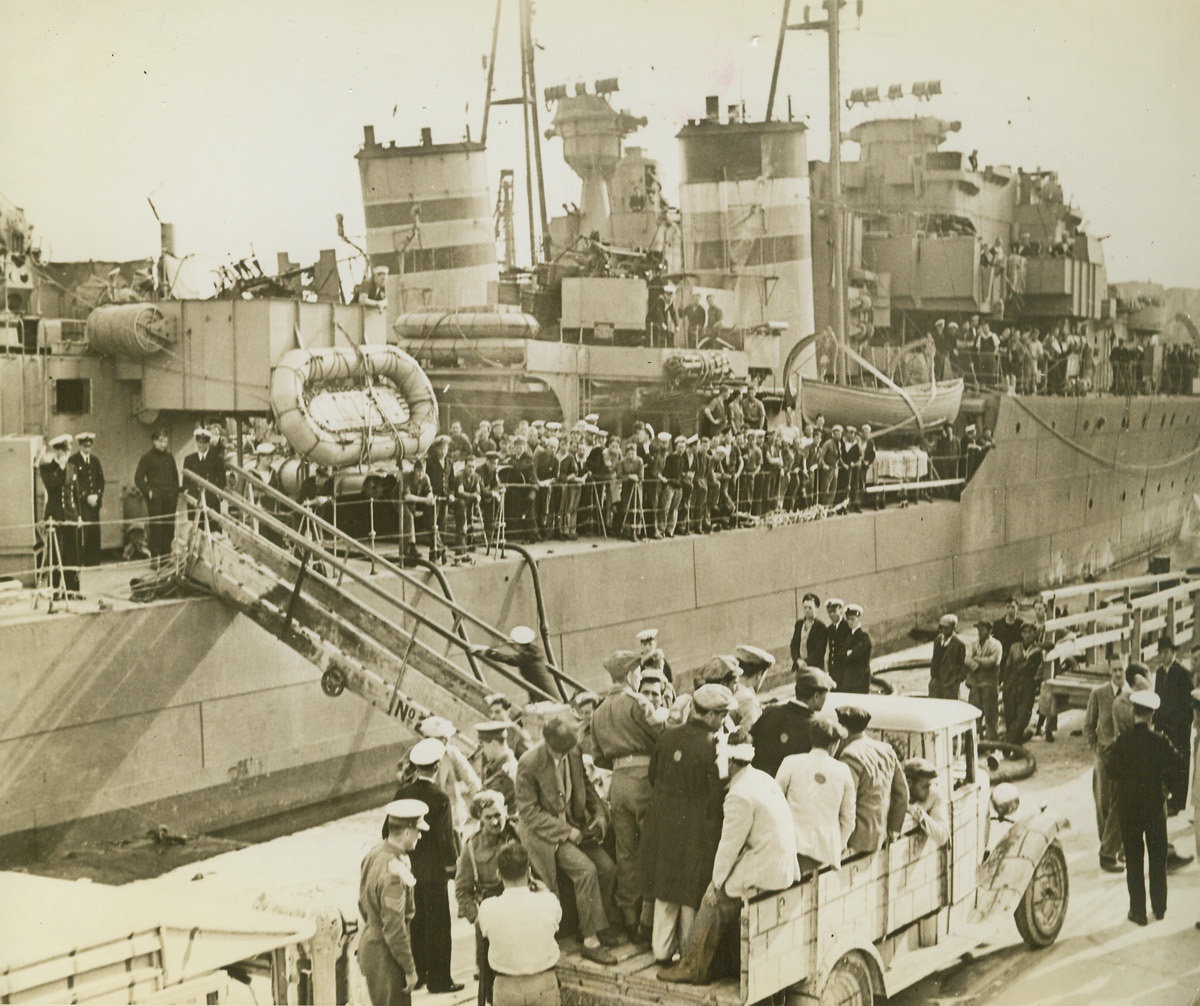
Wounded Axis Prisoners Landed at Malta, 2/2/1943. Malta—British destroyers lying alongside each other discharge prisoners of war and have come down the gangway and are loaded into lorry in foreground. British sailors line the ships’ rails watching the prisoners, who were picked up from the water after their merchant ships, running from Italy, were attacked. Credit: ACME.;
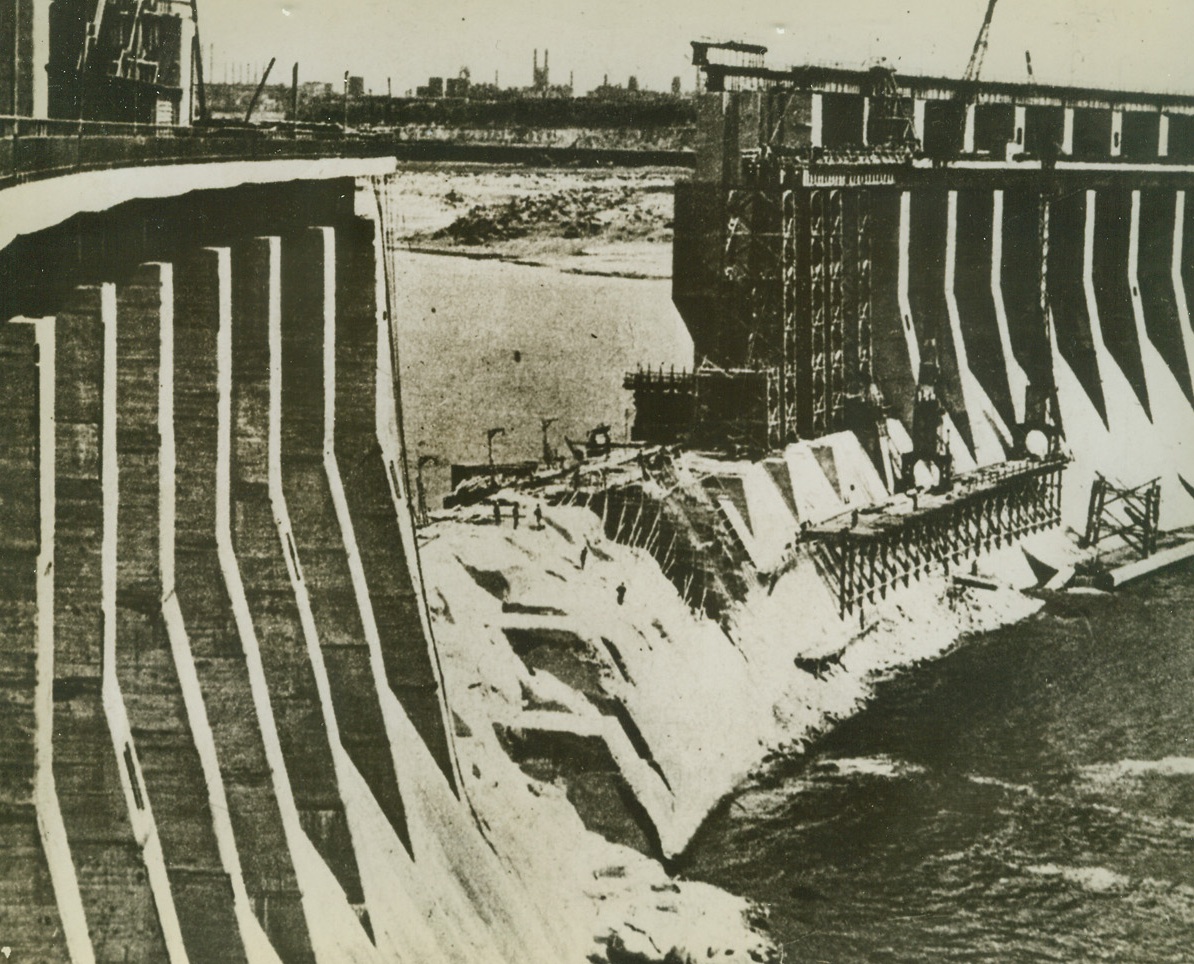
Nazis Repairing Dnieprostroi Dam, 2/13/1943. Russia—Here is a section of the Dnieprostroi Dam, which was blown up by the Russians when they left that area in August 1941 and which is now being repaired by the Nazis because the entire Central Ukraine Industrial District depends on this world’s greatest hydro-electric power works. If the present Russian advance continues at its fast pace, this Nazi repair work may come in handy as the Red Army moves southwest from Kharkov. The Germans may not have time to blow the dam up again. Credit: ACME.;
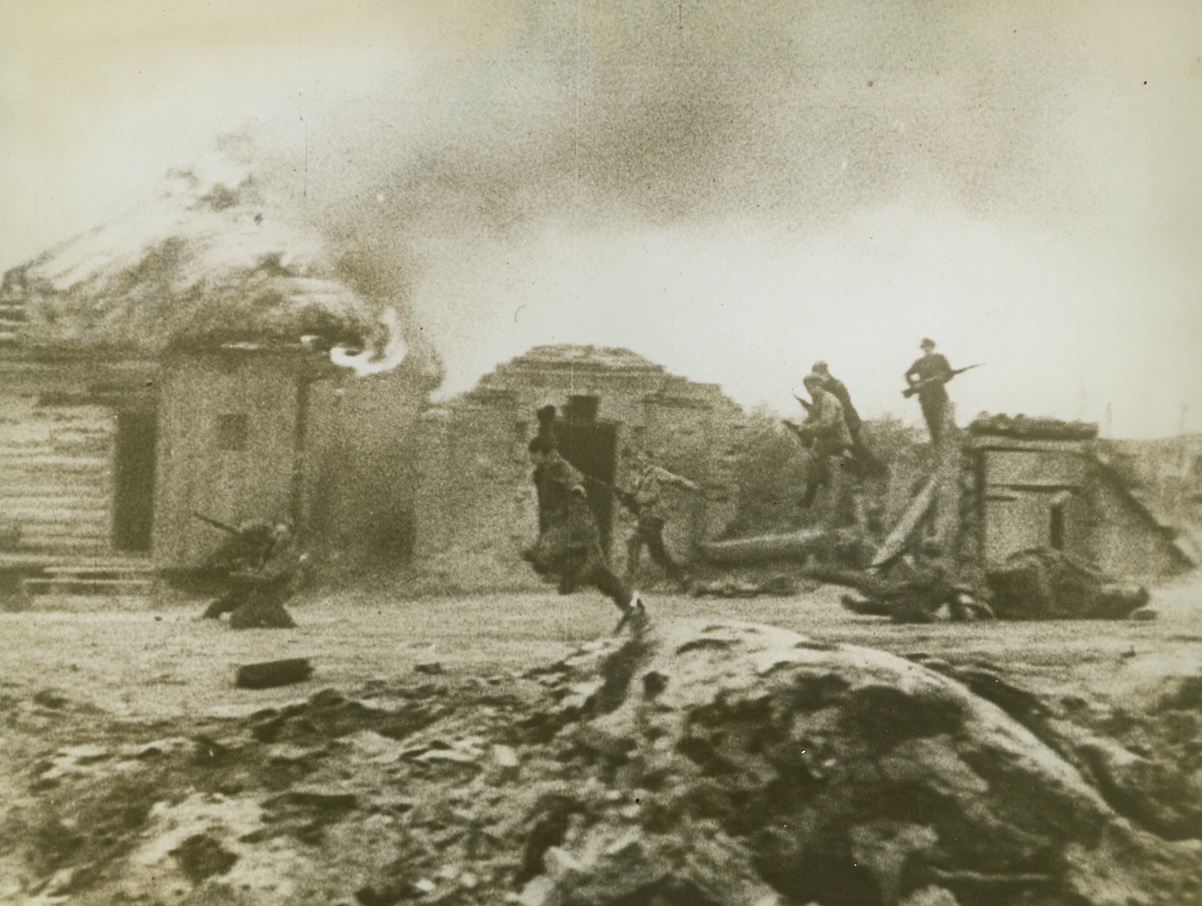
Red Guerillas, 2/10/1943. On the Russian Front—Scrambling out from behind the crude huts of a Russian village occupied by the Nazis, Red Army guerillas attack the invaders. Latest reports from the Russian front indicate that the Russians have taken the huge Nazi base and railroad center at Pelgorod. Passed by censors. Credit: Copyright March of Time Photo from ACME.;
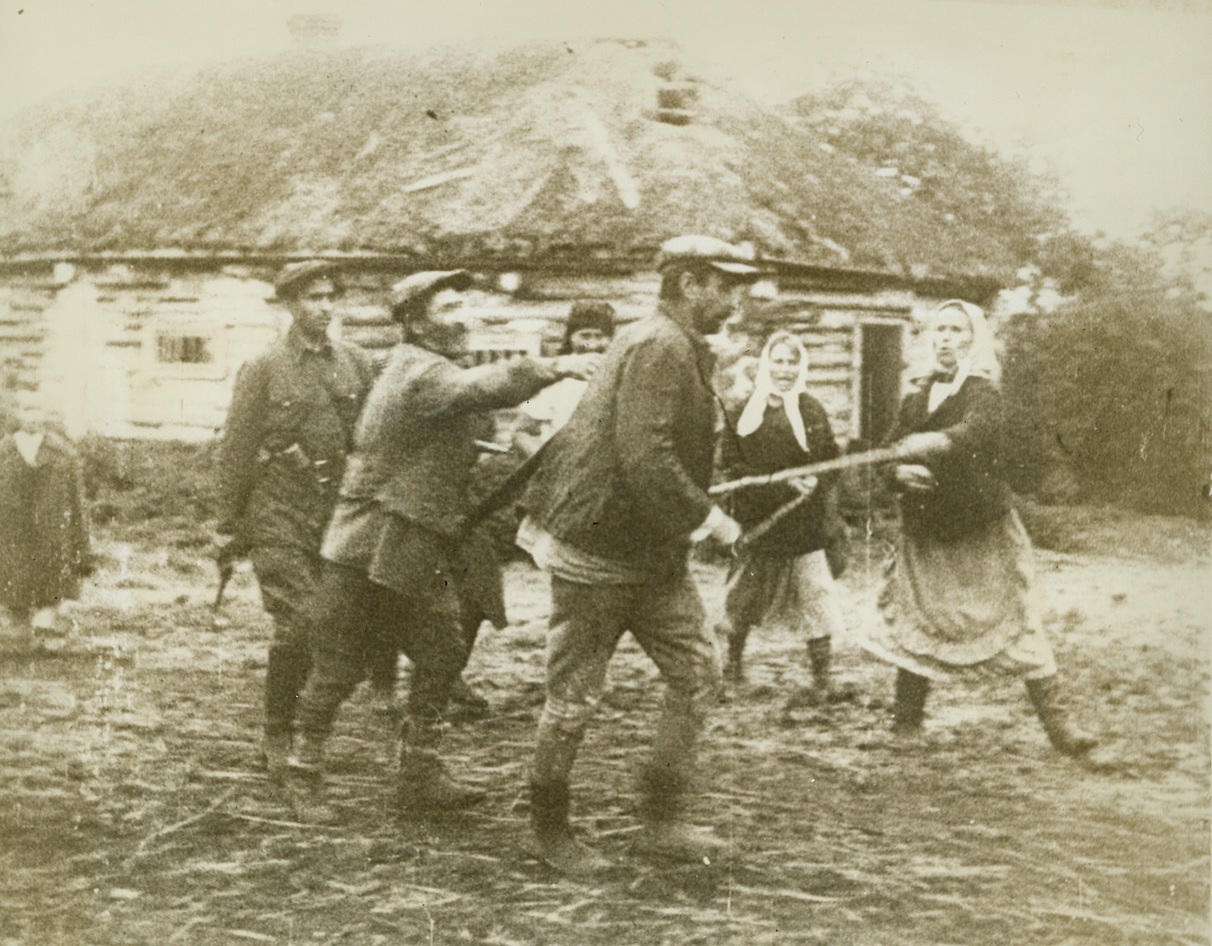
Russian Quisling, 2/10/1943. On the Russian Front—Like every other people fighting for freedom, the Russians despise those among their ranks who turn traitor and give aid to the invaders. Here a Russian “quisling” is made the object of jeers and poking sticks from Soviet villagers. Photo is from the March of Time documentary film, “One Day of War—Russia, 1943,” which depicts the action along the vast Russian front in a single day. Passed by censors. Credit: Copyright March of Time photo from ACME.;
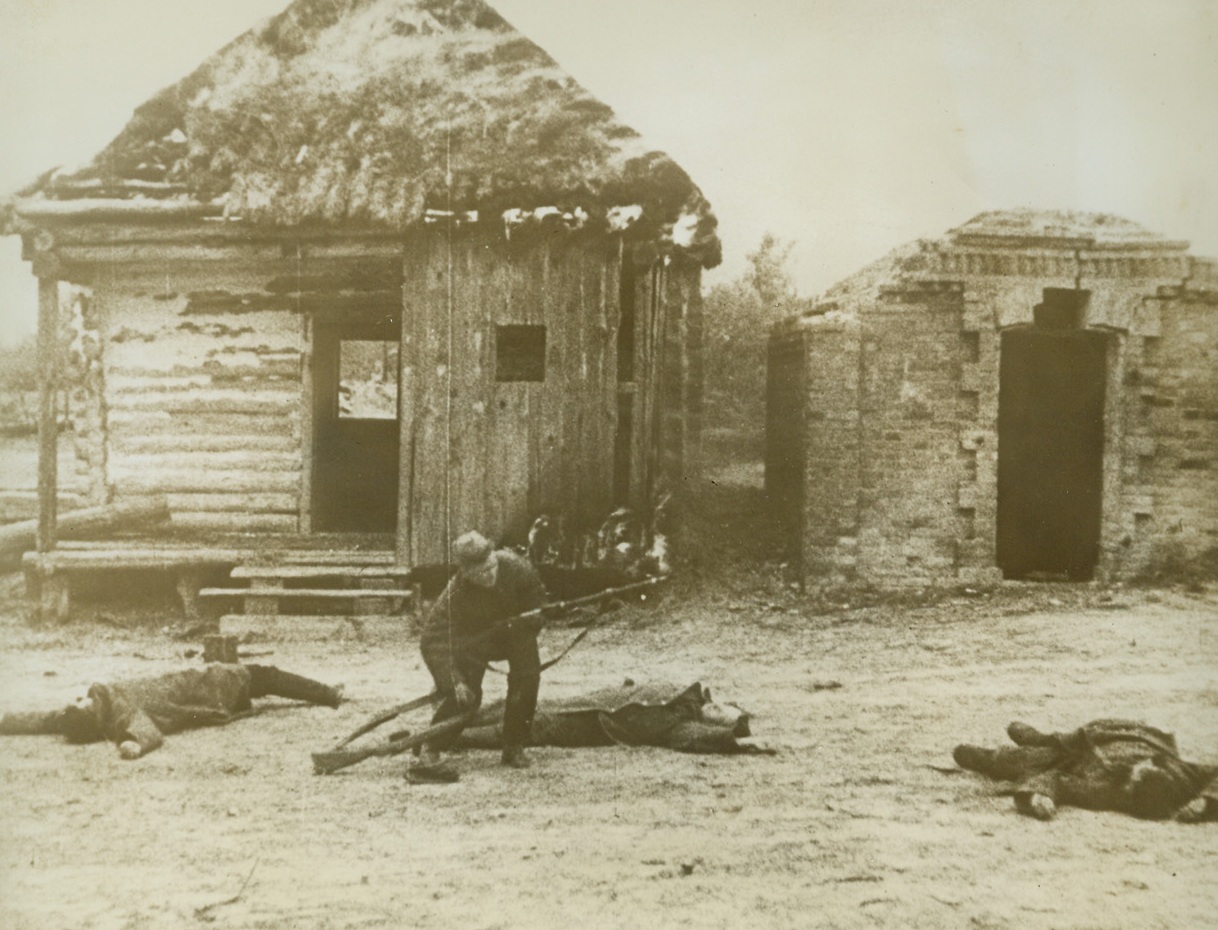
Supplies for Red Guerillas, 2/10/1943.On the Russian Front—A Red Army guerilla fighter collects the guns and ammunition used by these Nazis who fell in the battle for a Russian village. This is the only way guerillas can obtain supplies to continue their fight against the Nazi invaders. Photo is part of March of Time’s documentary film, “One Day of War—Russia, 1943,” which depicts the action along the vast Russian front in a single day. Passed by censors. Credit: Copyright March of Time photo from ACME.;
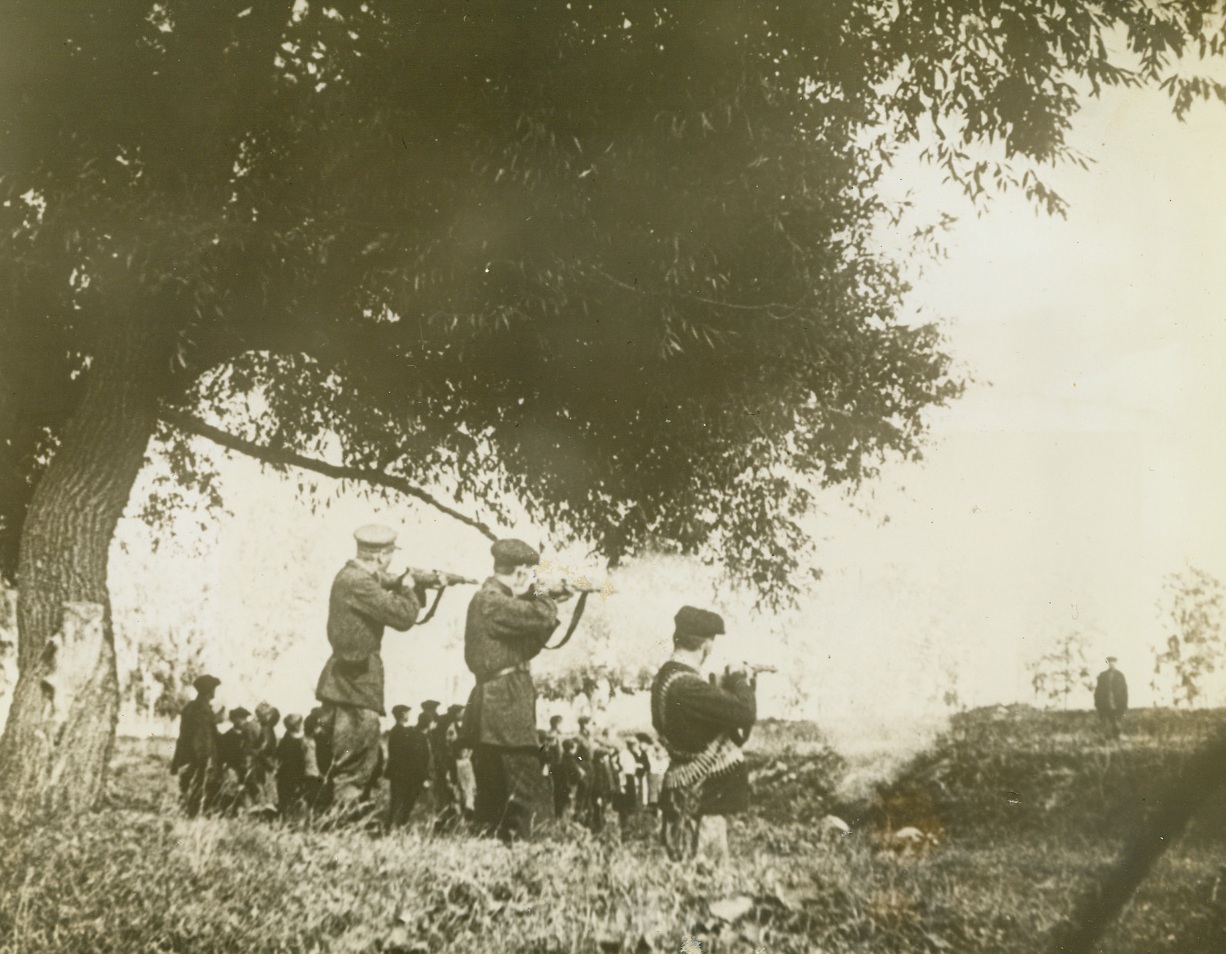
The End of a Traitor, 2/10/1943. On the Russian Front—Before a jeering crowd of men, women and children of a Russian village a red “Quisling” is executed by a firing squad. Photo is part of March of Time’s documentary film, “One Day of War—Russia, 1943,” which depicts the action along the vast Russian front in a single day. Latest reports from Moscow indicate that Soviet forces have taken the hugh Nazi base and railroad center at Belgordd. Passed by censors. Credit: Copyright March of Time photo from ACME.;
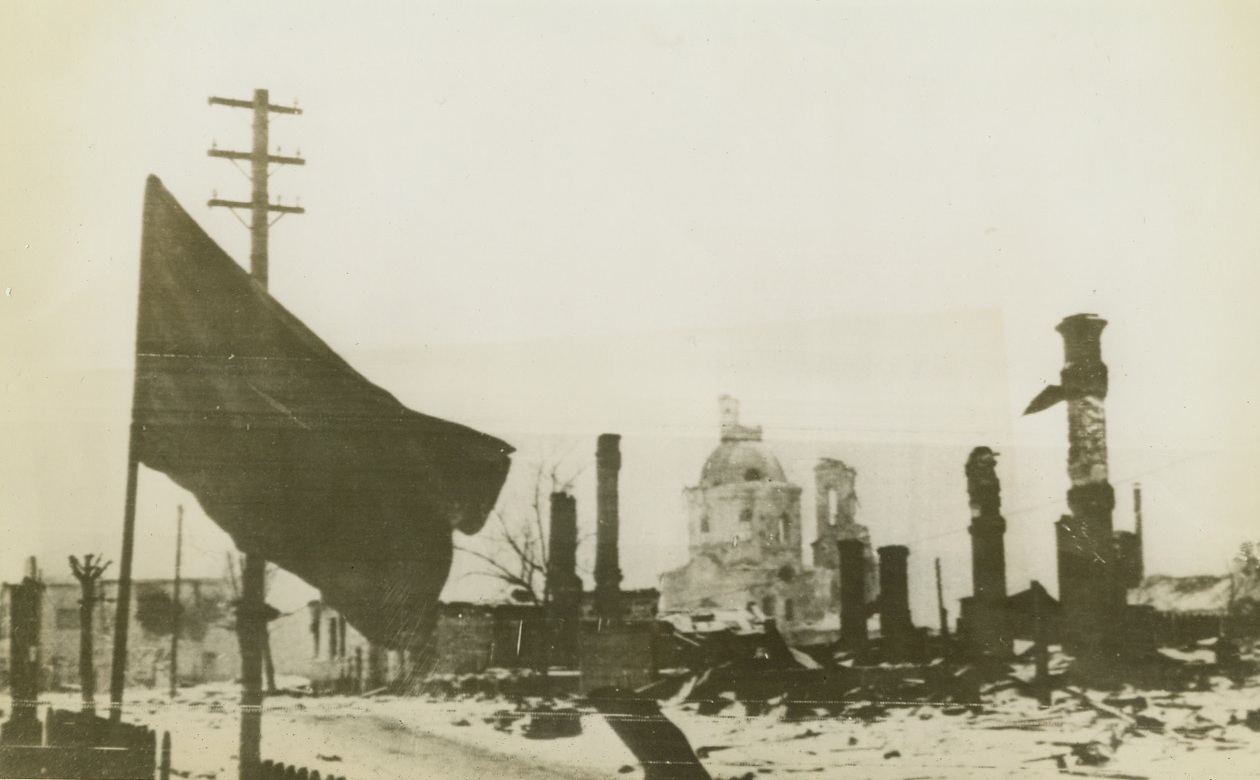
After Nazis Fled Veliki Luki, 2/1/1943. Russia—Here is how Veliki Luki looked after the Nazis had been forced to flee the town. Fierce street fighting took place before the Russian forces overcame the German garrison, capturing a huge amount of stores and ammunition. Credit: ACME.;
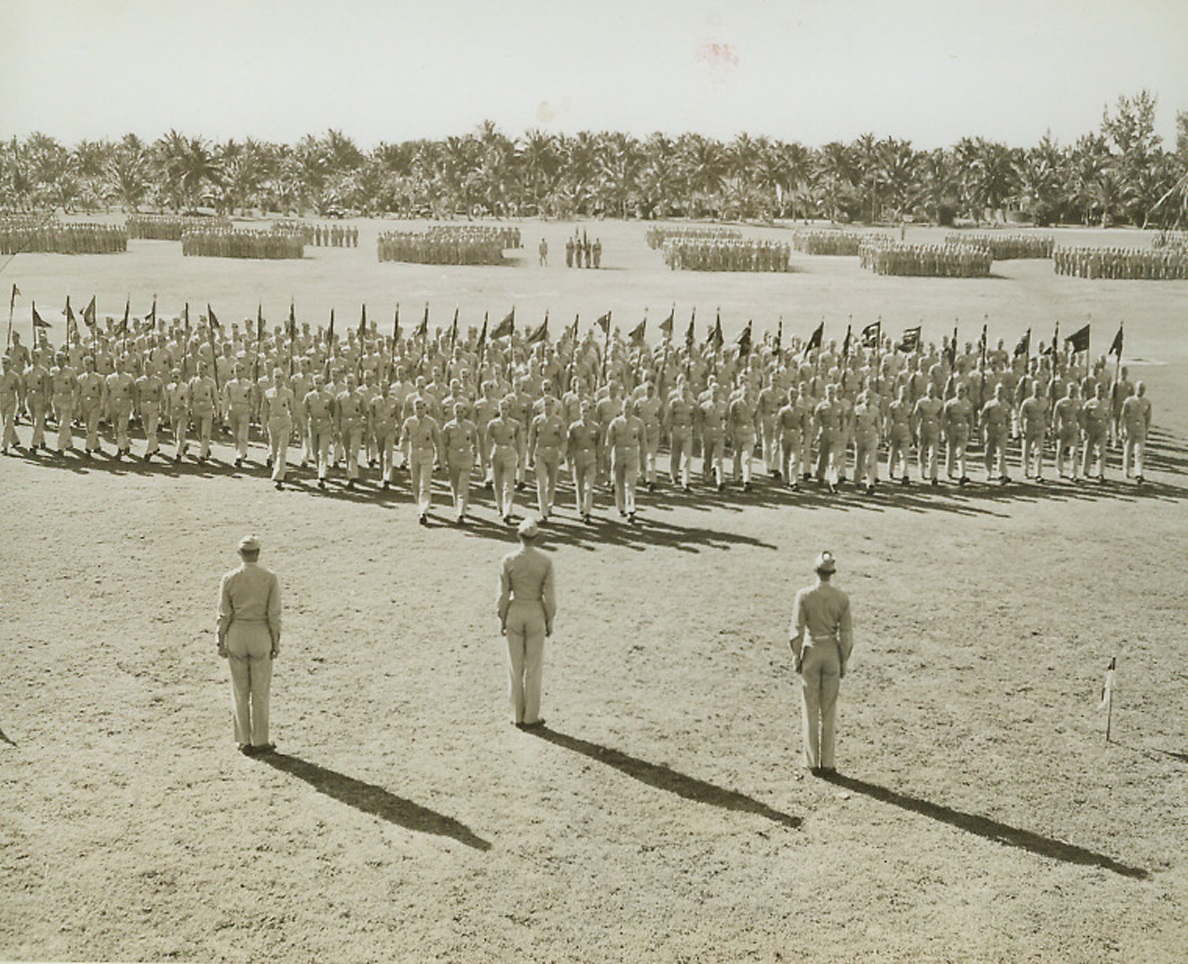
Drill on Swank Golf Course, 2/5/1943. Miami Beach, Fla.—Once a swank golf course, this wide stretch of green serves as a drill field for soldiers stationed with the Army Air Forces at Miami Beach. Photo was made during a parade in which men training at the Miami Beach Officer Training Candidate School participated. Awards were made to the best-drilled squadron during this part of the parade.Passed by censors. Credit: ACME.;
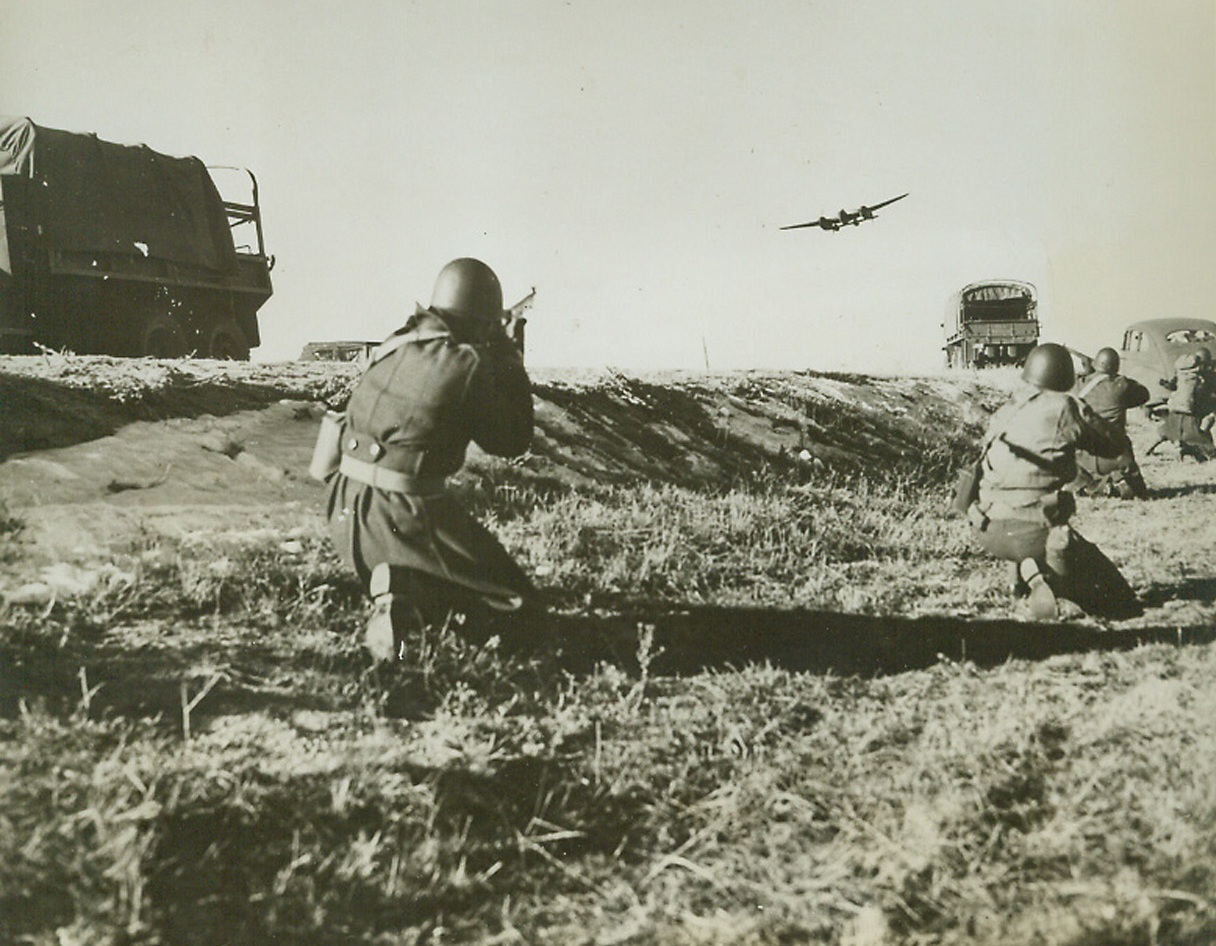
A War of Supplies, 2/5/1943. Fort Warren, Wyoming—Fighting quartermasters, at OCS school, break for the bush and “open fire” on low-flying planes that are trying to prevent their getting supplies up Icy Pole Mountain near Fort Frances E. Warren, Wyoming. The school instructors man the planes and try in every way to obstruct the successful movement of supplies in a mock battle. Despite wily attempts to demoralize them and harass movements with simulated air, gas, and mechanized attacks, the students—who will soon be important links in America’s battle for victory—all got their supplies through.Credit: ACME.;
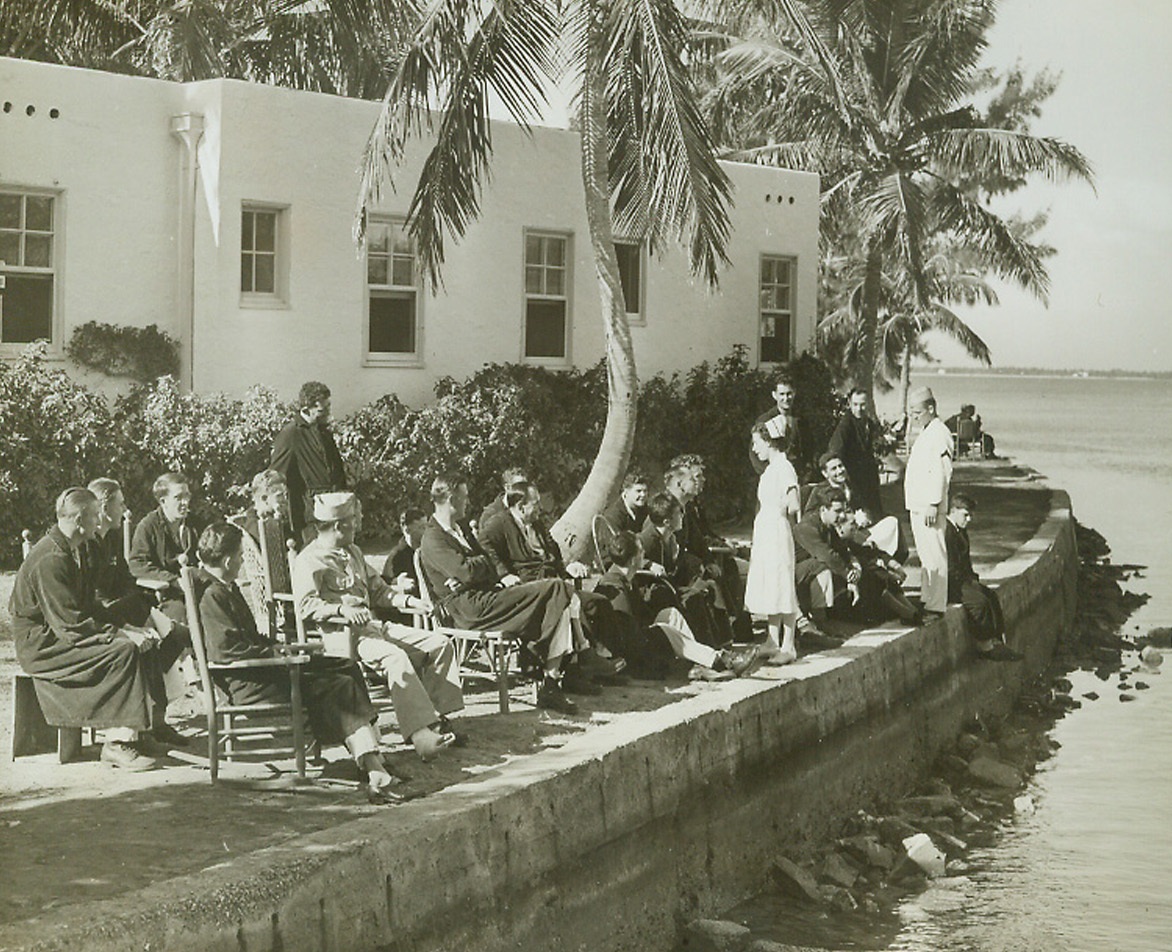
Convalescent Soldiers, 2/5/1943. Miami Beach, Fla.—Convalescent soldiers get a bit of that famous Florida sunshine as they sit along the waterfront outside the Nautilus Hotel Cottage Center. They are men who are stationed with the Army Air Forces at Miami Beach. The Nautilus Hotel has been taken over by the Army to serve as a hospital for the training center at the famous resort. Passed by censors.Credit: ACME.;
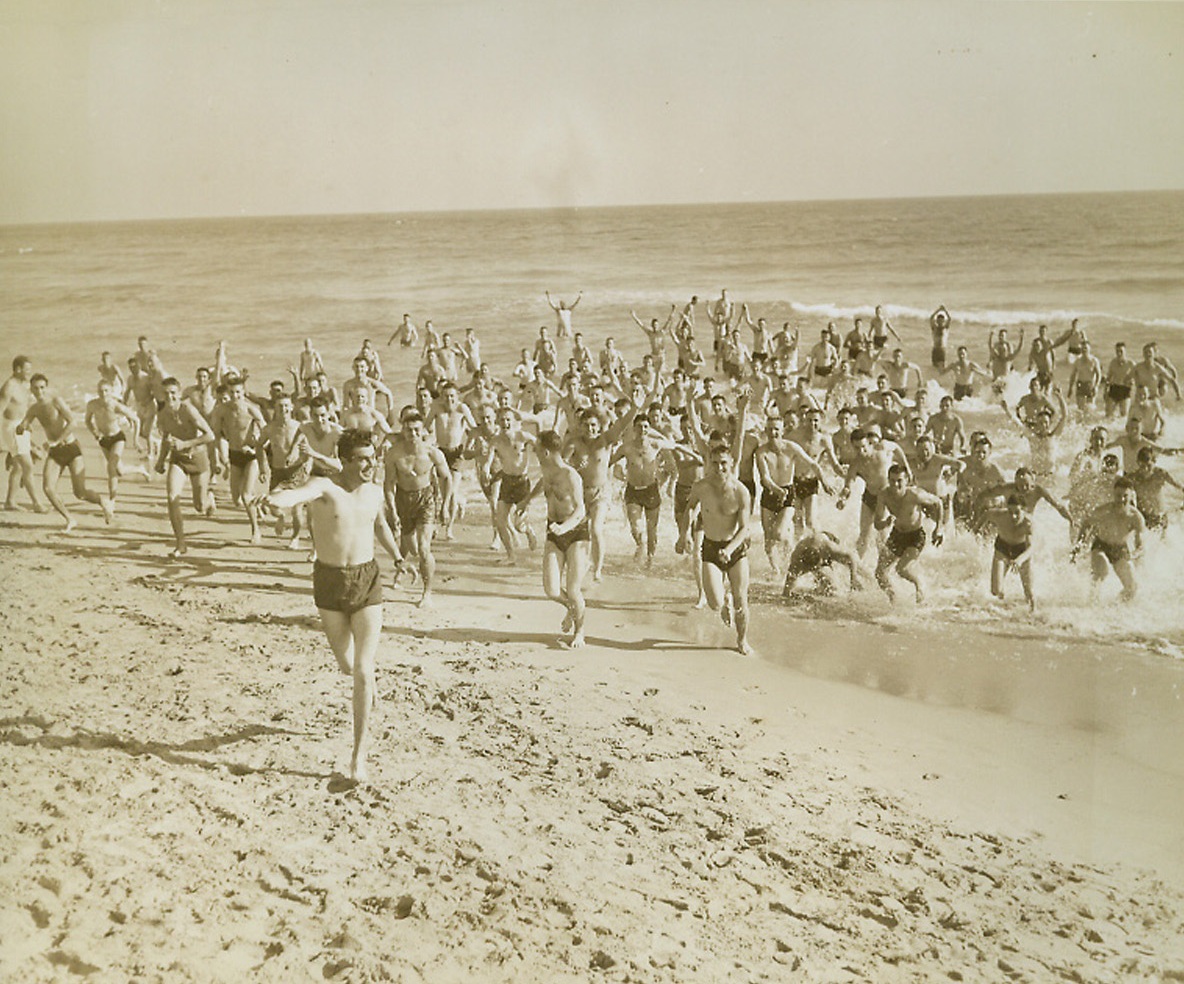
Out of the Water, 2/5/1943. Miami Beach, Fla.—Soldiers of the Army Air Force Training Command dash out of the Atlantic Ocean onto the sands of Miami Beach, after a refreshing swim, to continue their daily program of calisthenics on the beach.Passed by censorsCredit: ACME.;
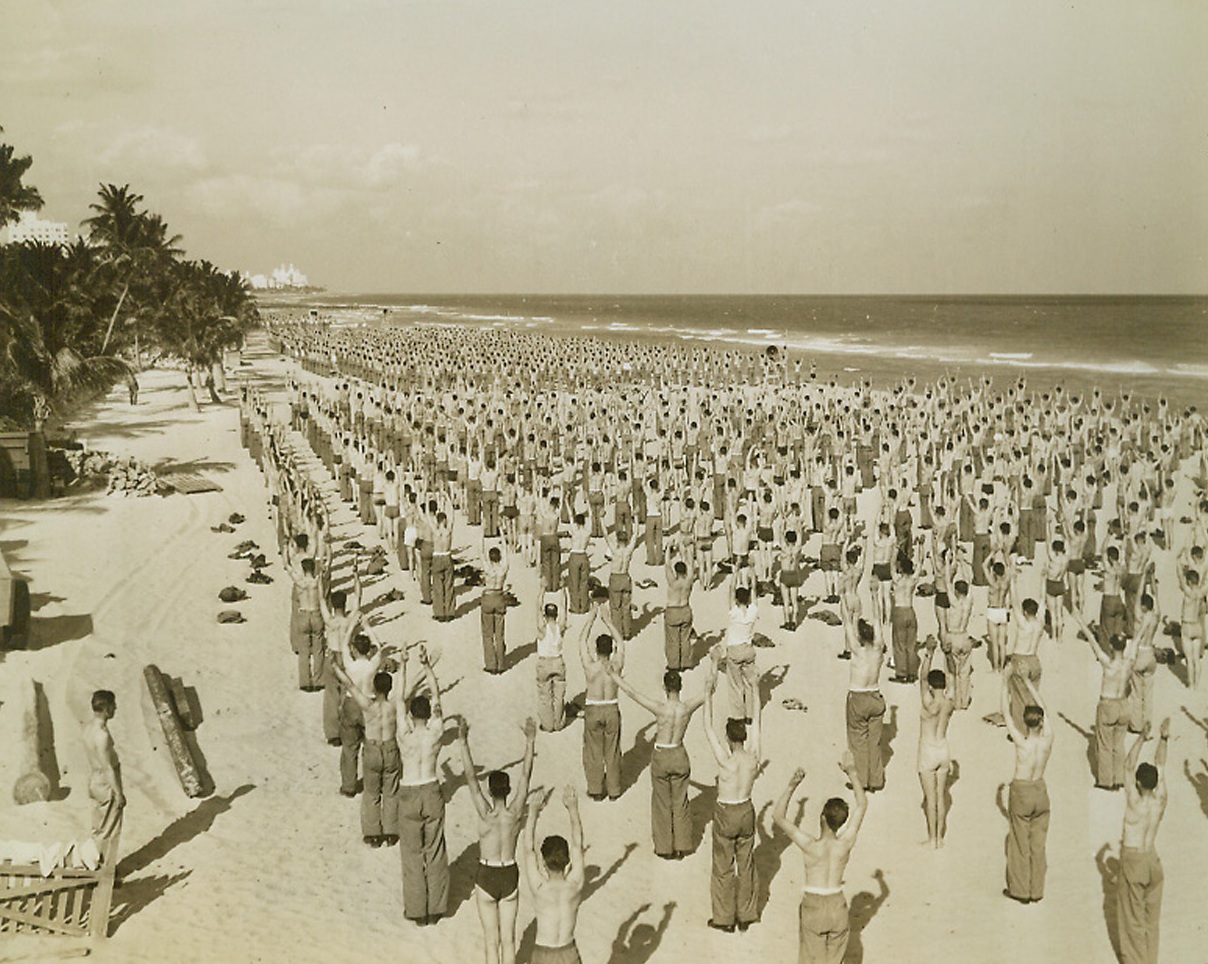
Calisthenics on the Beach, 2/5/1943. Miami Beach, Fla.—Soldiers training with the Army Air Forces at Miami Beach carry out their daily program of calisthenics on the beach. Hundreds of men, exercising along long stretches of the beach, do the same exercises at the same time. Their routine is directed by one announcer whose voice comes to them through loudspeakers erected on the beach.Passed by censors.Credit: ACME.;
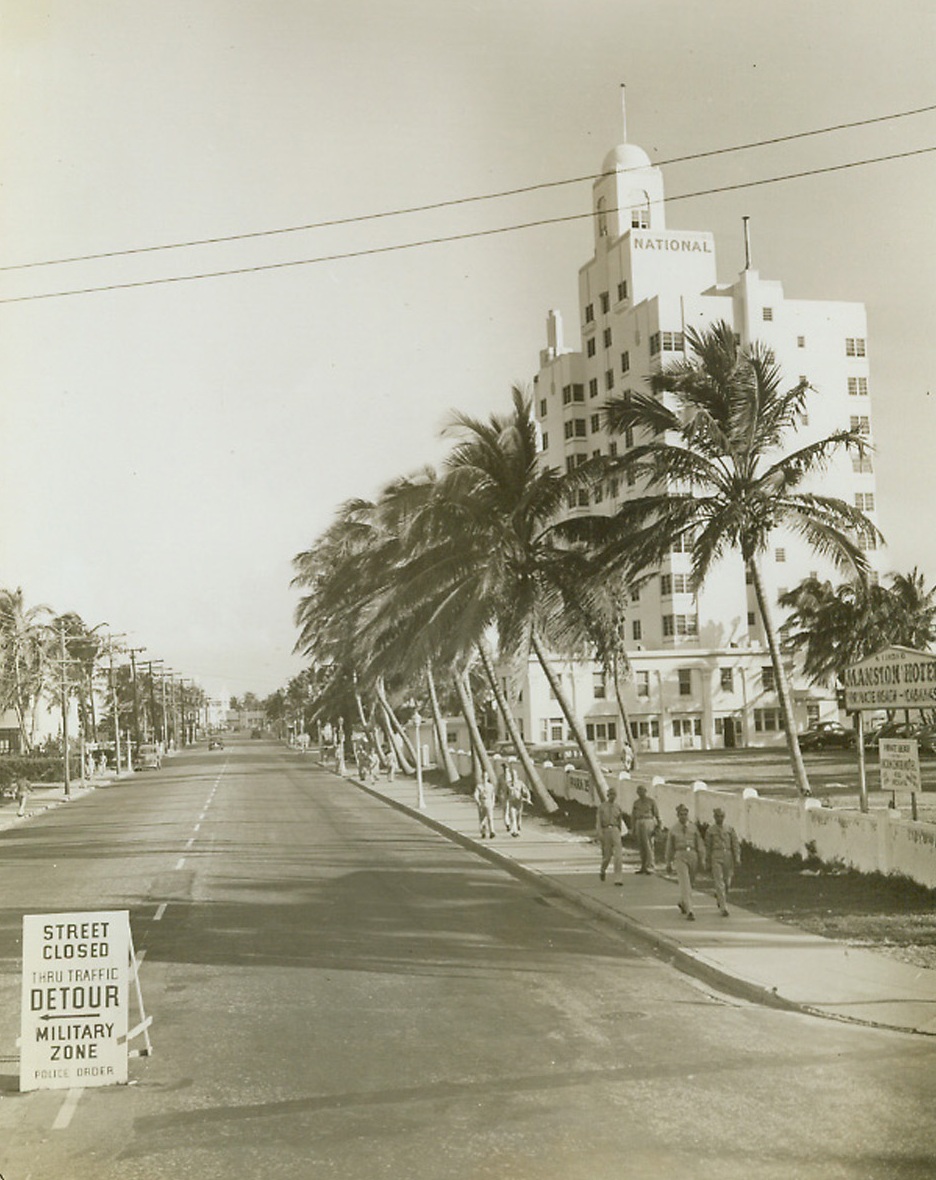
Detour—Street Closed, 2/5/1943. Miami Beach, Fla.—The sign at the left of the photo is a familiar one at Miami Beach these days. Once the playground of the rich, this section has been taken over by the Army Air Corps for training draftees, enlisted men and officer candidates. The area shown is Miami Beach’s famous Ocean Drive, looking north from Collins Avenue.Passed by censors.Credit: ACME.;

New U.S. Warship on Practice Cruise, 2/3/1943. Cold heavy seas surround this new U.S. battlewagon as it steams ahead on a practice cruise. Sixteen-inch rifles jut out from the two forward turrets while dual-purpose batteries point skyward from amidships. Credit: U.S. Marine Corps photo from ACME;
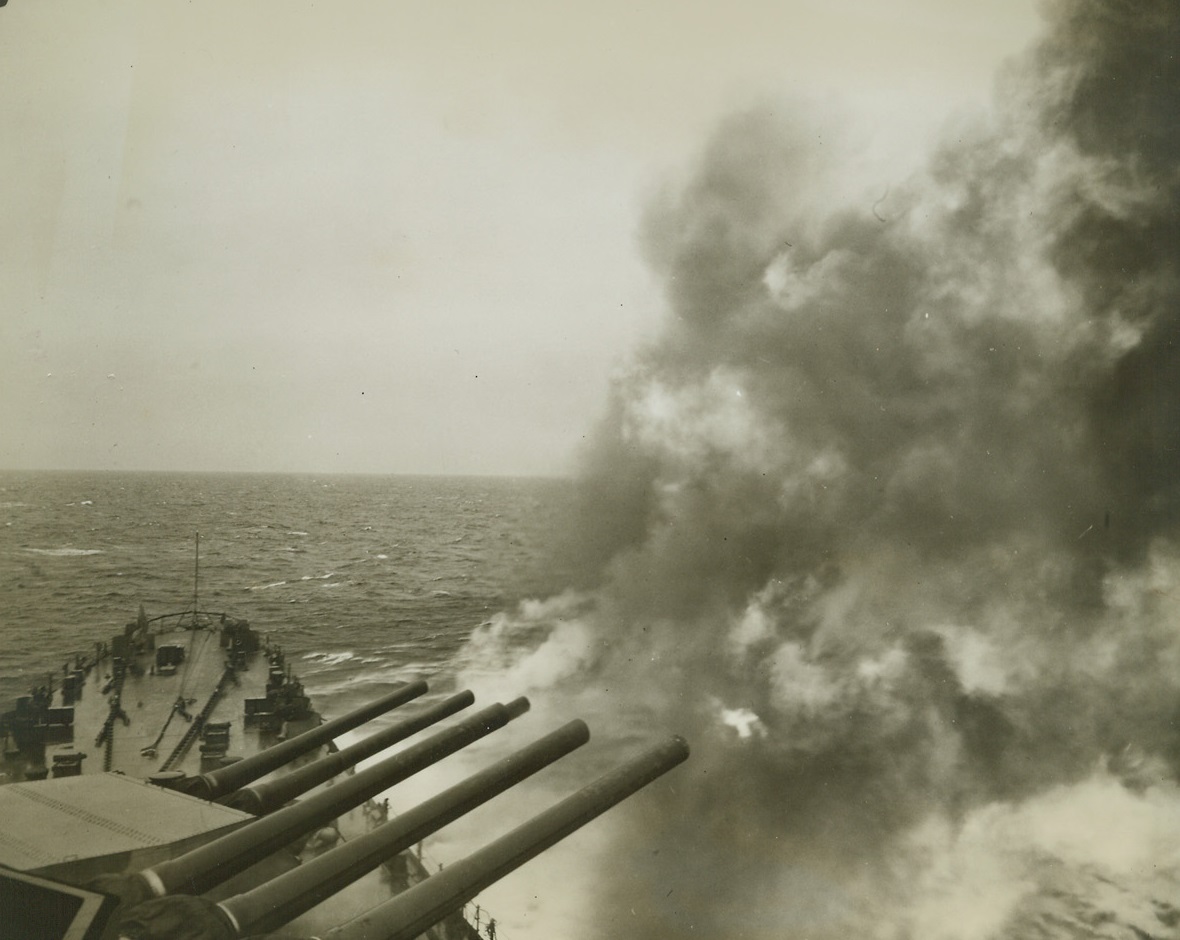
Sixteen Inch Salvo, 2/3/1943. The main battery of 16-inch guns blast away over the starboard side of a U.S. battleship on a cruise and target practice sea jaunt. There’s no enemy this time to feel the deadly combination of American skill and might. Credit: ACME;
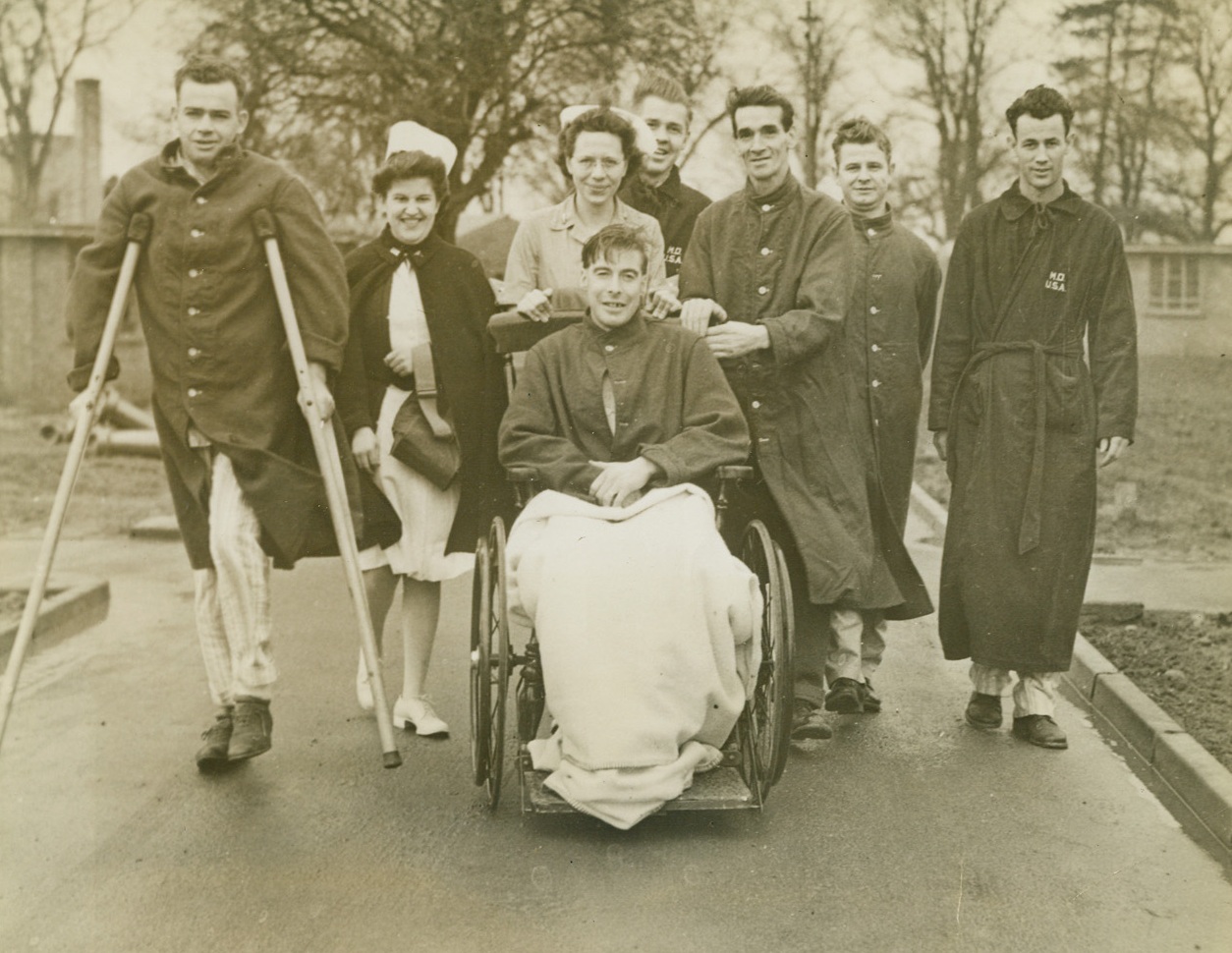
Doin’ Fine, 2/17/1943. Somewhere in Britain - Convalescing in a West Country Hospital, British and American soldiers, accompanied by American nurses, take a stroll on the hospital grounds. All well on the way to recovery, the men were brought to Britain after being wounded on North African battlefields. Passed by Censors Credit: ACME;
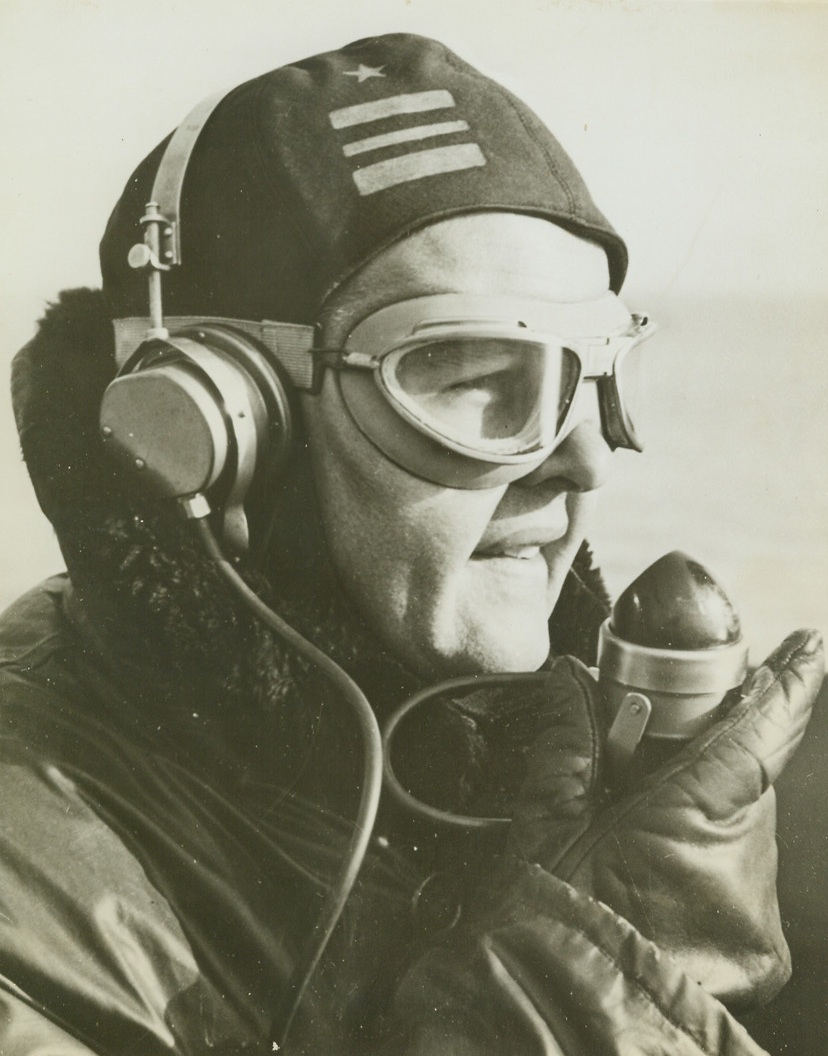
Enemy Overhead, 2/3/1943. Enemy Overhead – From the Sky Lookout, the top-most platform of a battleship, a U.S. Navy officer directs the fire of a 40 mm. and 20 mm anti-aircraft guns, during a cruise and target practice run. The Lieutenant Commander coordinates the defense fire against attacking enemy planes coming in simultaneously from several directions. Credit: Official U.S. Navy photo from ACME;
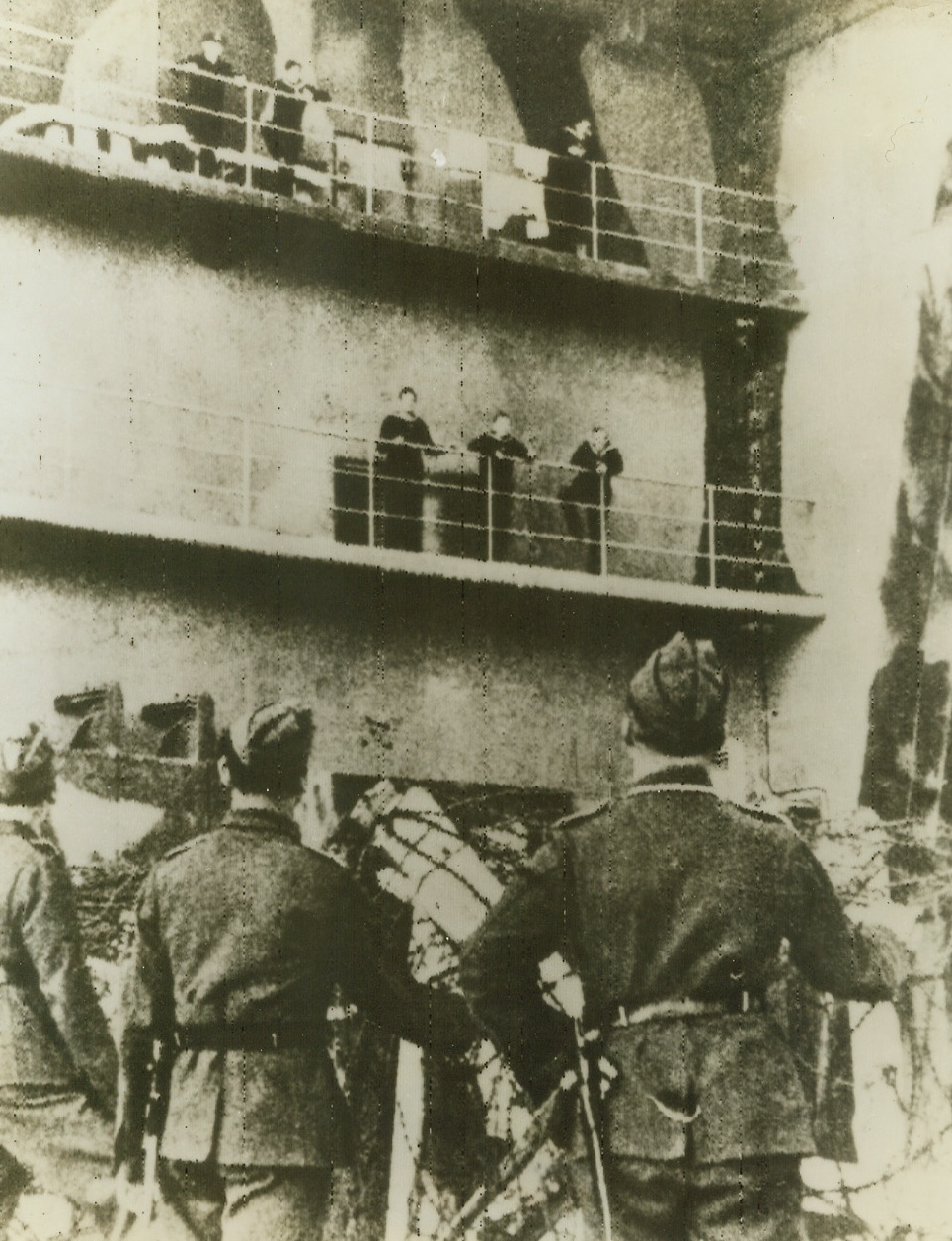
Double Raid Cripples Nazi U-Boat Base, 2/15/1943. Lorient, France – Concrete dugouts for Nazi U-boat crews, such as this one, were smashed by strong formations of RAF four-motored bombers Saturday night in two raids. The Nazi U-boat center was all but knocked out in the furious assault where over 1,000 tons of bombs were hurled and the city was virtually transformed into a sea of spurting flames. This photo was taken from a newspaper page smuggled into London and radioed to New York today. Credit: ACME Radiophoto;
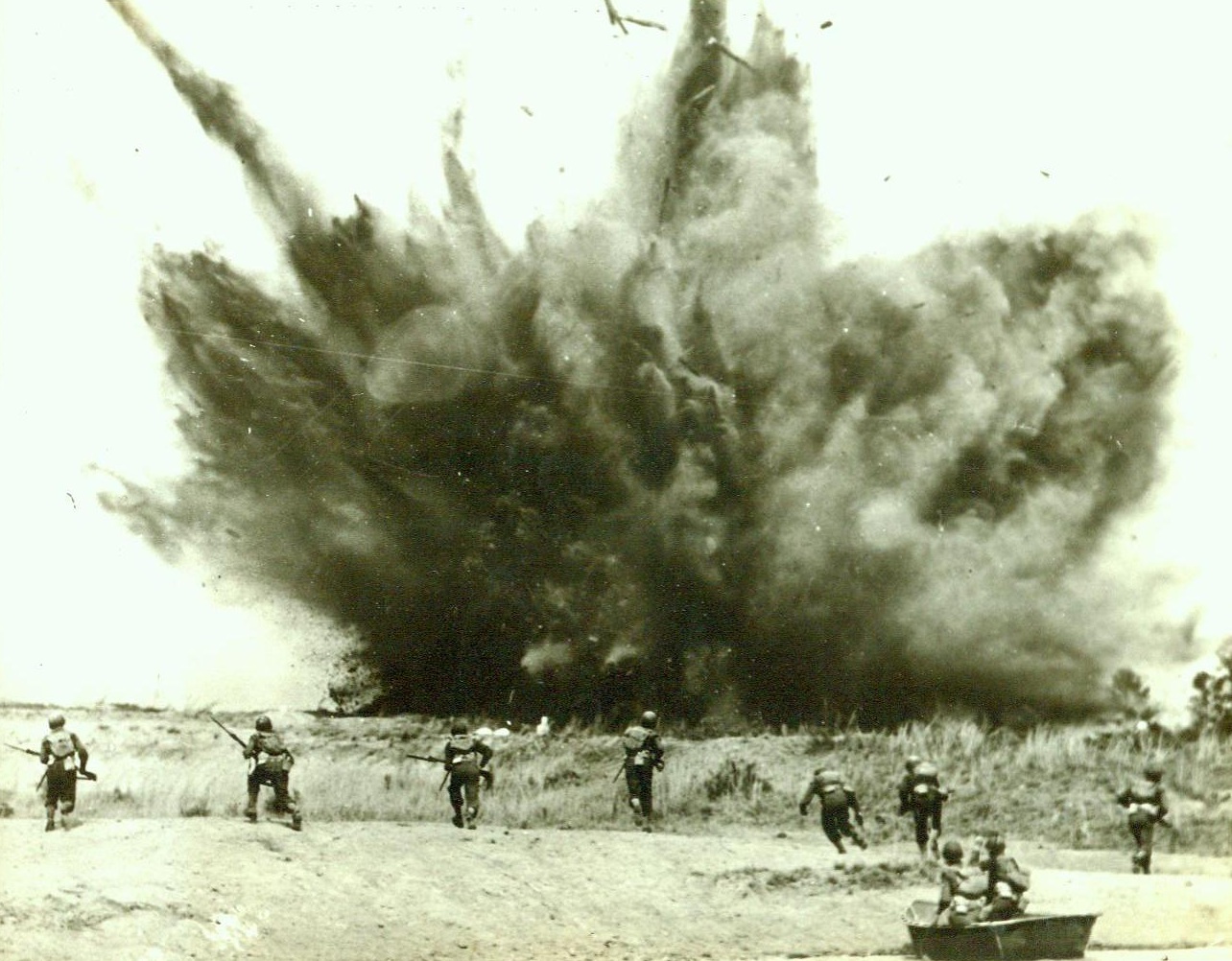
Wildcat Division Tastes Real War, 2/8/1943. Camp Rucker, Ala. -- Advancing under a barrage of live ammunition, units of the 81st (Wildcat) division were treated to a taste of actual warfare as they advanced across Lake Tholocco at Camp Rucker, Ala., in assault boats and stormed a "Nazi" village on the opposite shore. The exercise, planned to develop teamwork between all ground forces, saw nearly a thousand men in action as field artillery and infantry weapons threw live fire overhead. Photo shows a pillbox being blasted as infantrymen make a beach landing from their boats. 2/8/43 (ACME);
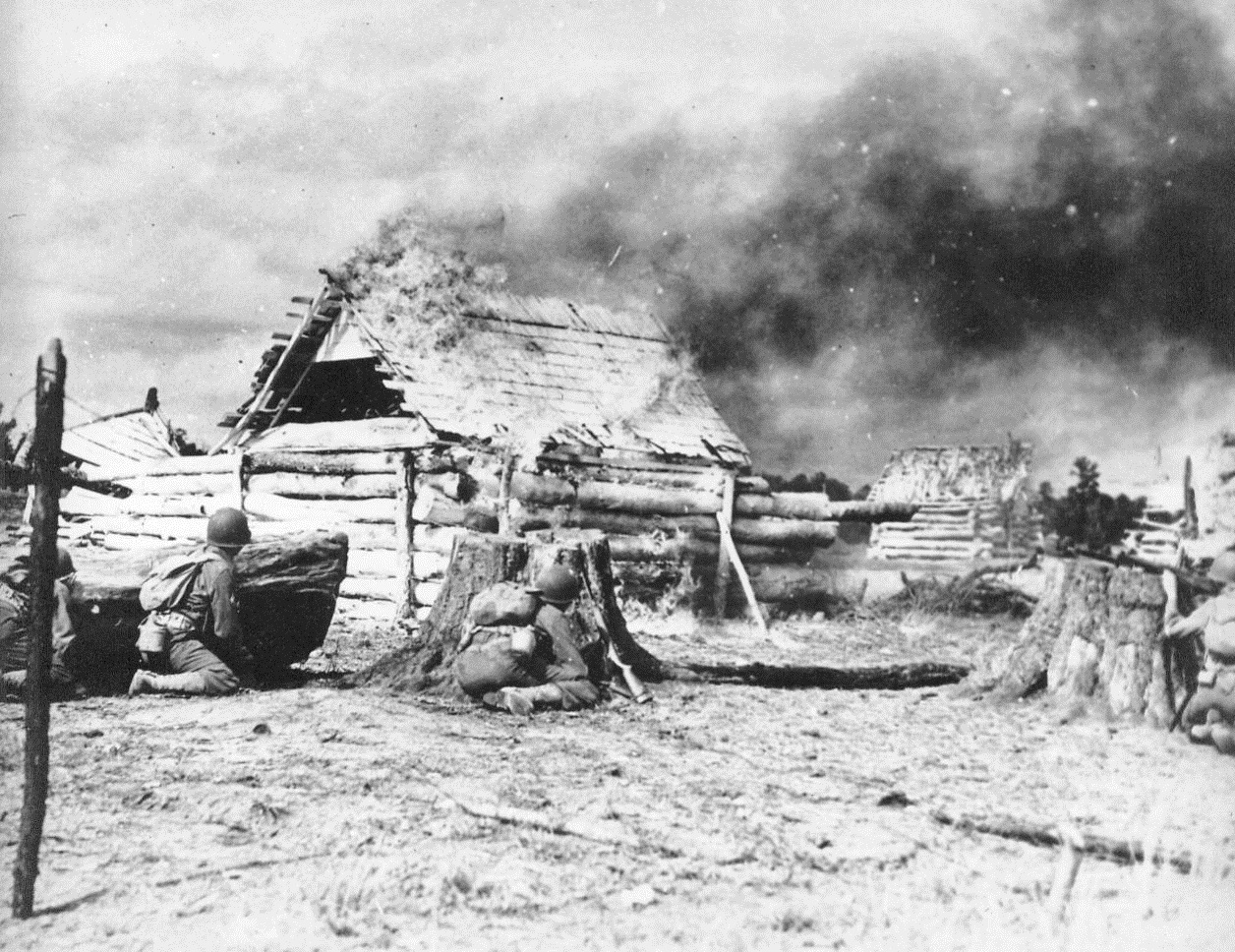
Wildcat Division Tastes Real War, 2/8/1943. Camp Rucker, Ala. -- Advancing under a barrage of live ammunition, units of the 81st (Wildcat) division were treated to a taste of actual warfare as they advanced across Lake Tholocco at Camp Rucker, Ala., in assault boats and stormed a "Nazi" village on the opposite shore. The exercise, planned to develop teamwork between all ground forces, saw nearly a thousand men in action as field artillery and infantry weapons threw live fire overhead. Photo shows Infantrymen attacking the enemy village. They have set fire to the house with incendiary grenades. 2/8/43 (ACME);
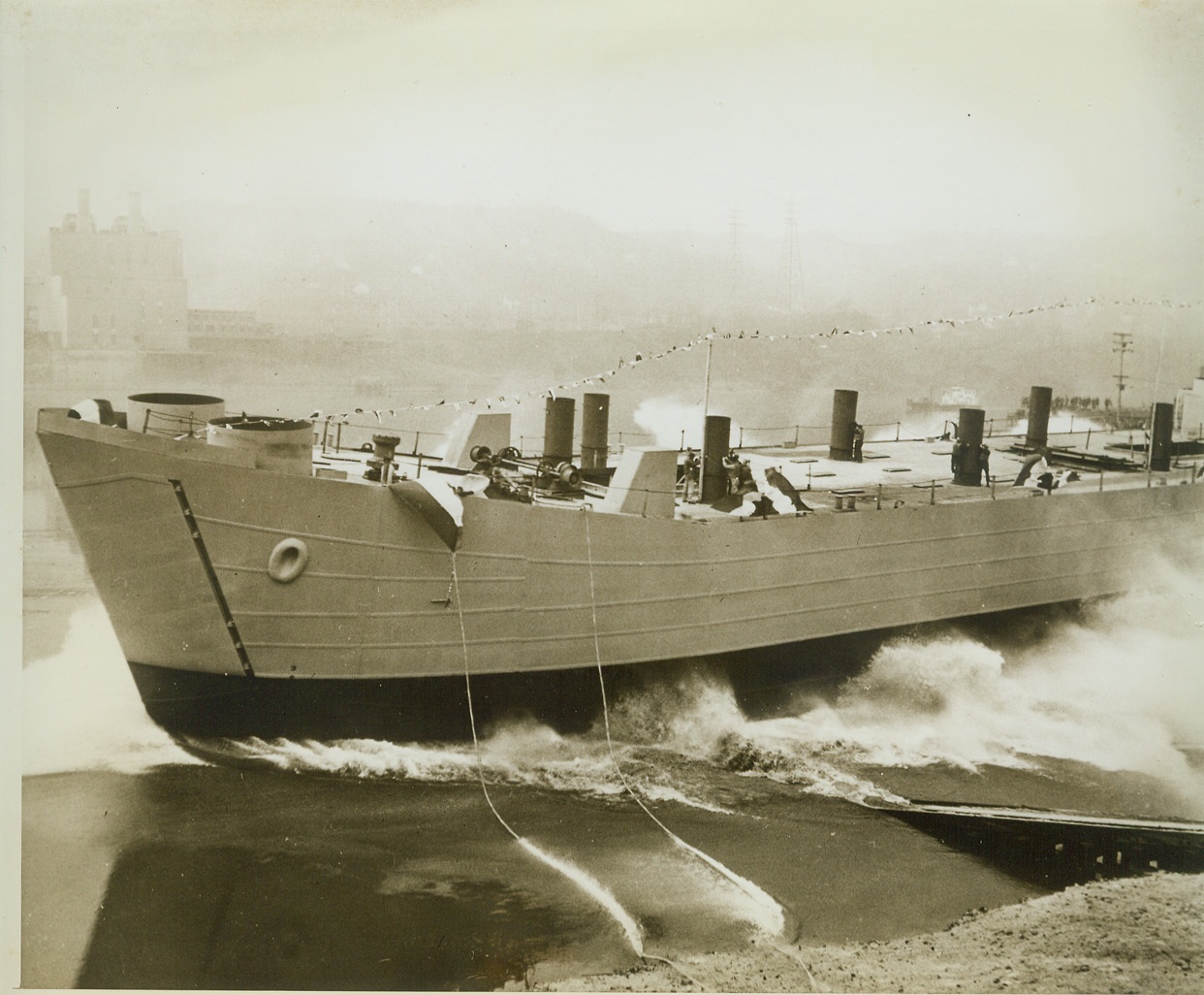
New Type Offensive Craft Launched Inland, 2/1/1943. AMBRIDGE, PA. – A new type tank landing ship splashes into the Ohio river after skidding down the ways of the Navy shipyard built and operated by the American Bridge Company. The U.S. steel subsidiary launched the new style vessel today, exactly nine months from the date workmen began converting 64 swampy acres into an inland shipbuilding plant. The conversion work involved changing the course of a creek, constructing a highway and bridges and erecting 23 buildings. Credit: (ACME);
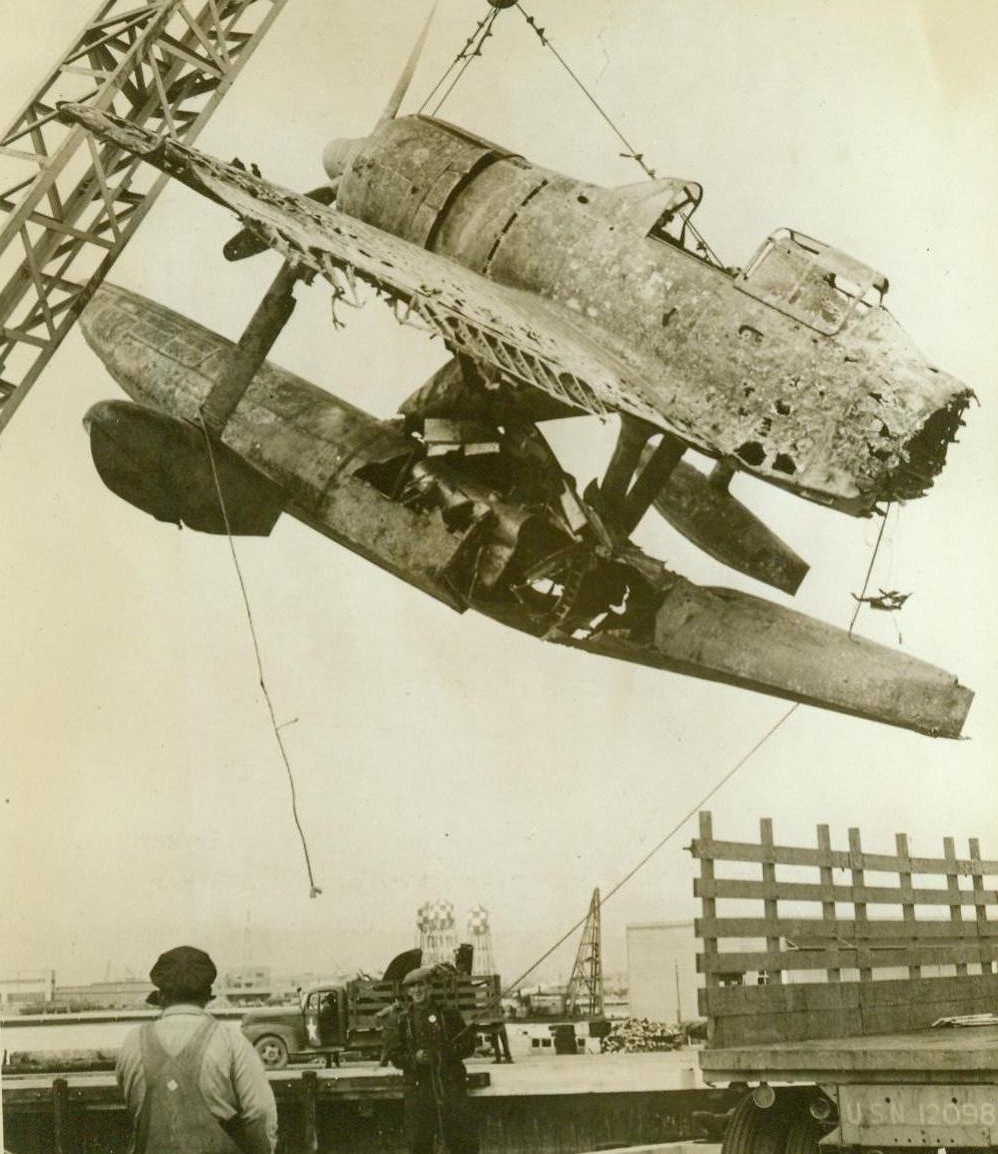
Blasted Zero Brought To U.S. For Inspection, 2/26/1943. Alameda, Calif. – A Jap zero float-type plane, brought down by U.S. forces in the Pacific, is unloaded at Alameda. The Navy Department will inspect the plane as well as other enemy aircraft, blasted in the Pacific zone and transported to the United States. 2/26/43 (ACME);
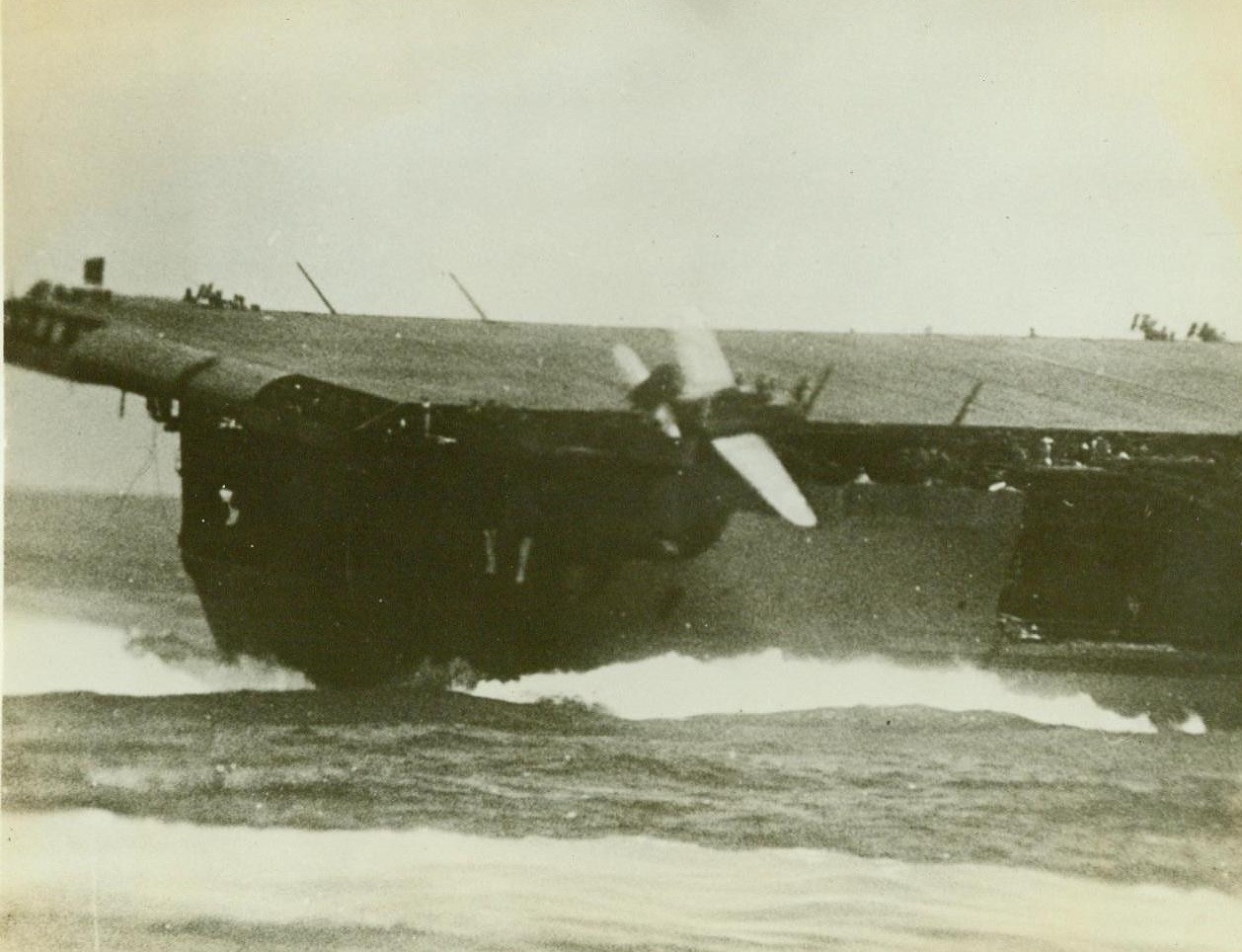
Concussion Throws Bomber Off U.S. Flattop, 2/20/1943. Overboard it goes! An enemy bomb hit on a U.S. aircraft carrier as it heeled over in a sharp turn sent this lone SED skidding off the flight deck on the starboard quarter. A U.S. Navy photographer on an accompanying warship snapped this picture just as the big Douglas Scout Bomber spilled over the side 2/20/43 (US Navy Official Photo From ACME);
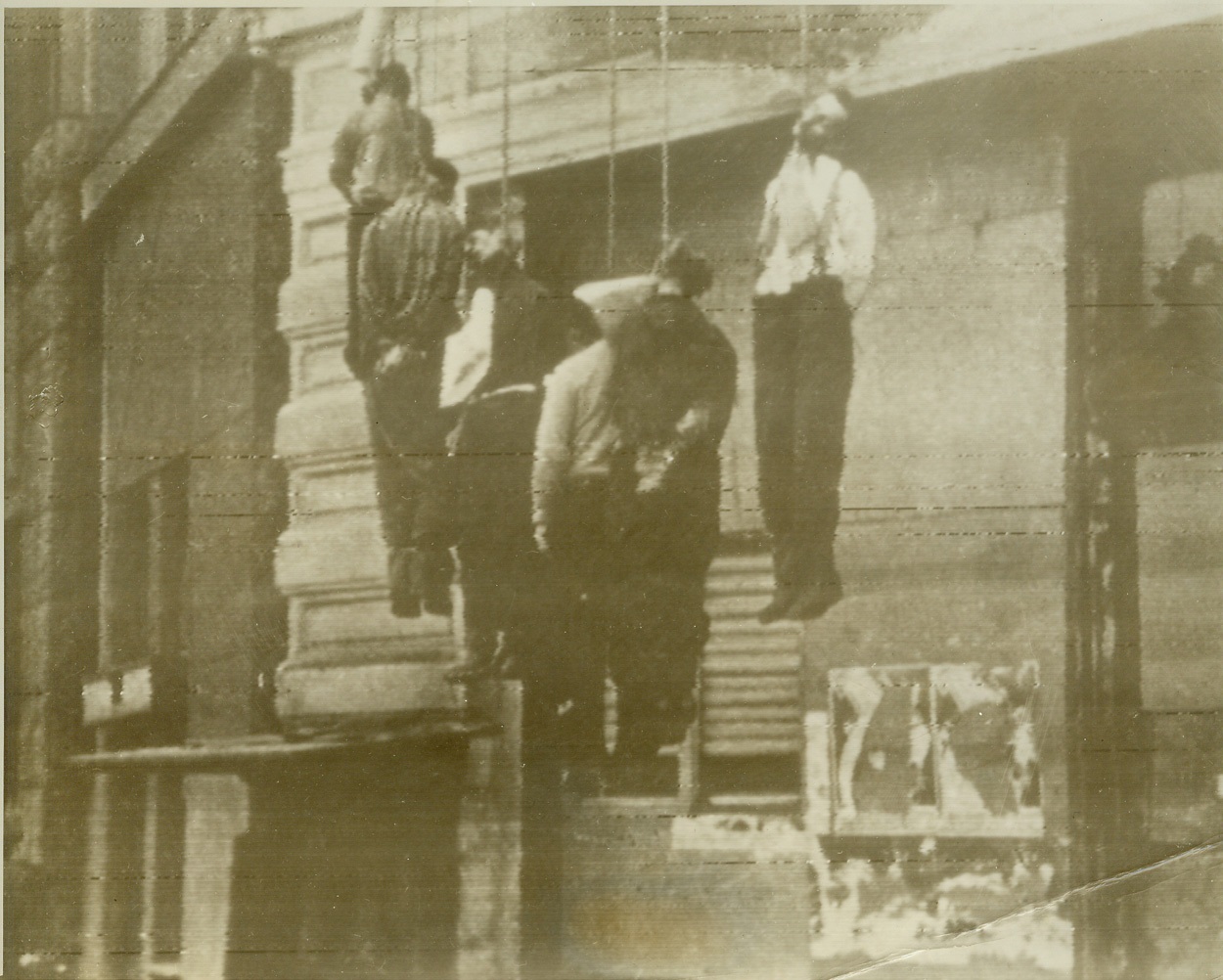
To Be Revenged, 2/21/1943. Somewhere in Russia—Another evidence that Nazi troops take pride in the atrocities they commit is this photo of hanged Red citizens found on a dead German fighters. To forever quell resistance, Hitlerite hangmen methodically exterminate populations of villages they capture. Soviets are getting their revenge on the battlefields. Credit: ACME radiotelephoto;
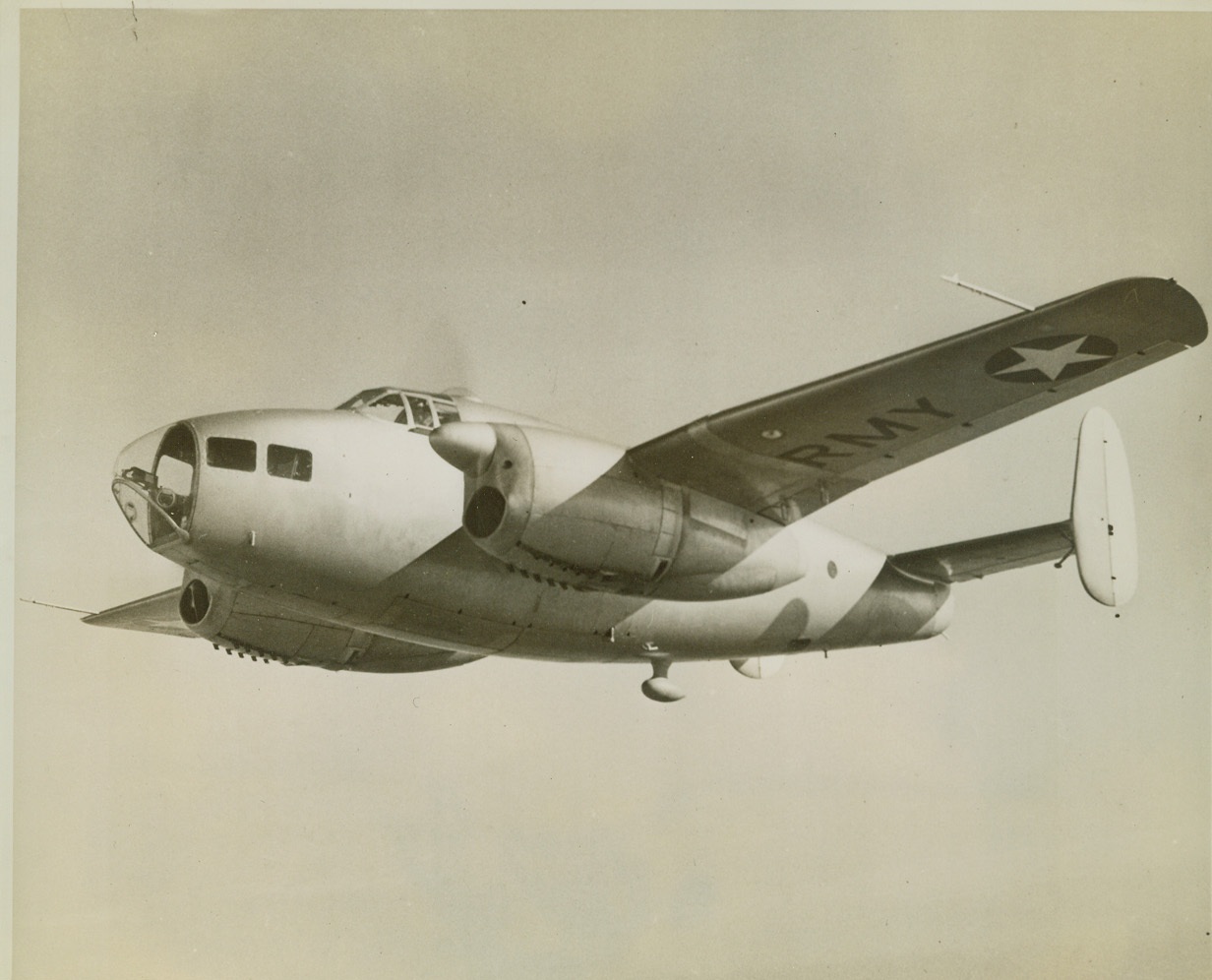
Plywood Training Plane, 2/22/1943. Burlington, N.C.—The only metal used in the Fairchild AT-21 (above) is in the engines, engine supports, instruments and certain other equipment supports. The rest of the five-beater plane is built of plastic bonded plywood. It is in the 200-miles-per-hour class and was designed primarily to train gunner crews to work as a team. It’s made by Fairchild Aircraft, Burlington. Credit: ACME;
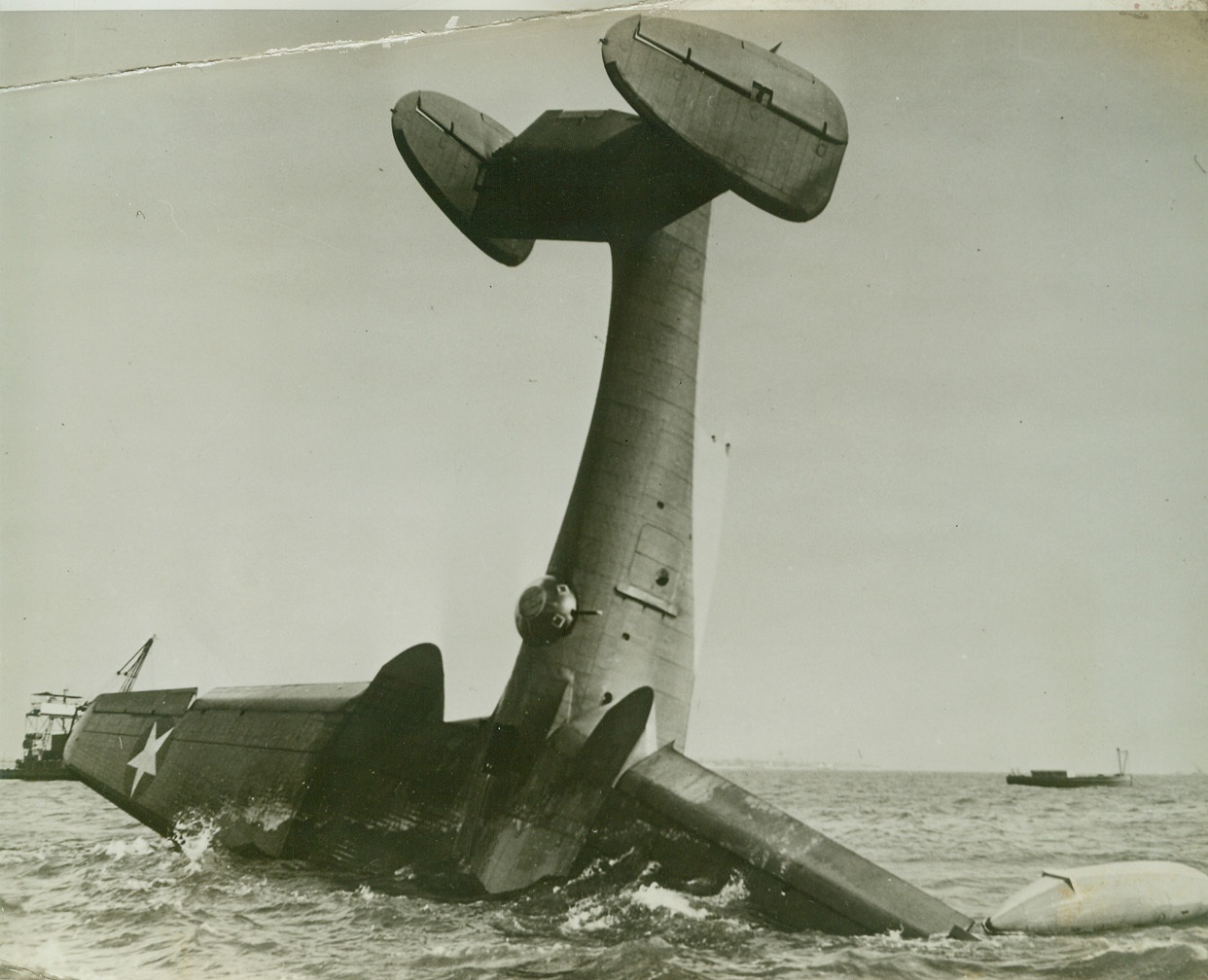
Fatal Navy Plane Crash, 2/20/1943. Four enlisted men were killed and two others and a naval officer are missing following the crash of this PBM Wednesday, Feb. 17, in Willoughby Bay at Norfolk, VA. The plane lost altitude after a takeoff from the Norfolk Naval Air Station and fell into the water. Its nose lodged into mud and sand, trapping seven men (Remaining portion of caption is illegible). Credit: U.S. Navy official photo from ACME;
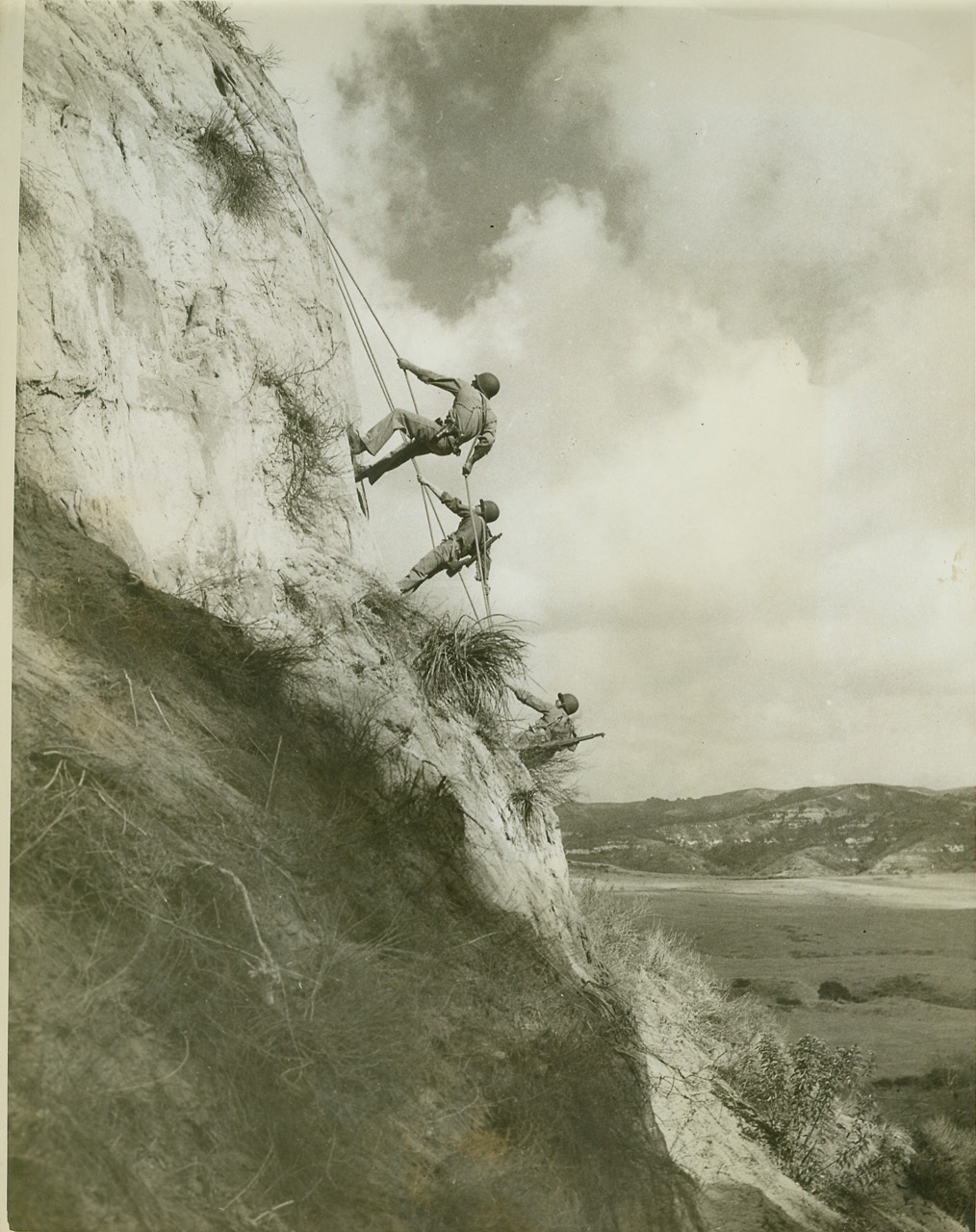
Marine Battle Tricks, 2/26/1943. Camp Pendleton, Calif.—Marine raiders scale a mountainside at Camp Pendleton where they are being taught savage methods for quick, quiet annihilation of the enemy. A battalion under the command of Lt. Col. James Roosevelt is now undergoing a tough course of instruction including mountain climbing, cable sliding for descending mountainsides at top-notch speed, construction of barriers out of natural material, and other rigorous maneuvers. Credit: U.S. Marine Corps photo, ACME.;
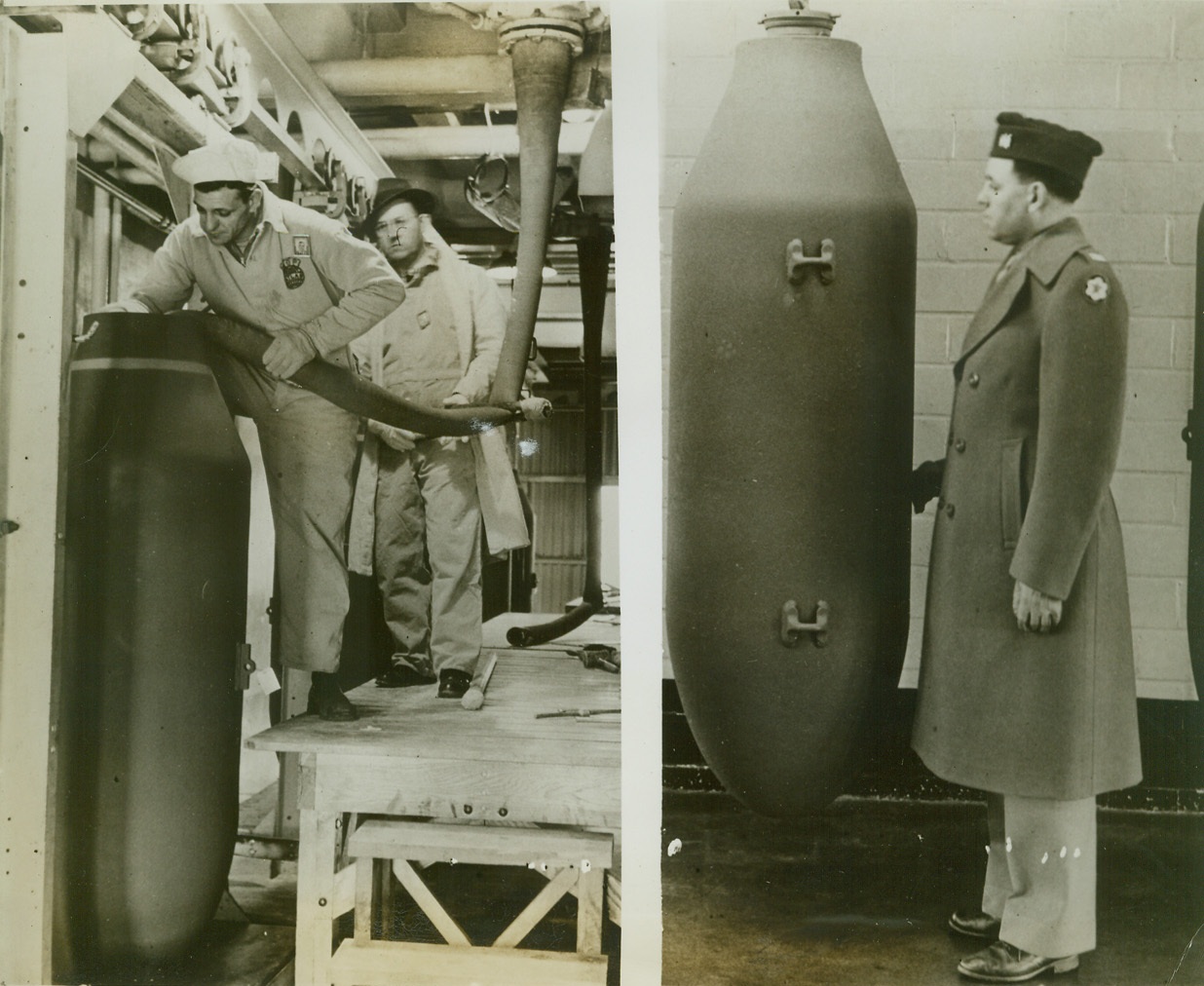
THESE’LL BUST YUH, ADOLF, 2/12/1943. RAVENNA, OHIO—Two workers at the Ravenna Oranance Plant of Uncle Sam here are shown at left as they fill a two-ton “block buster” bomb with bad medicine for the Axis. At right, a soldier is shown alongside one of these huge bombs for size comparison. The huge 30,000-acre arsenal here is turning out these and other munitions for the government in large quantities, and is one of the largest in the country. Credit: OWI Radiophoto from ACME;





 Trash & Recycling
Trash & Recycling
 Online Payments
Online Payments
 City Documents
City Documents
 Parks
Parks
 Traffic Court
Traffic Court
 CITY PARKS
CITY PARKS
 RECREATION
RECREATION
 Volunteer
Volunteer
 Home
Home TRANSLATE
TRANSLATE
